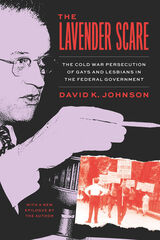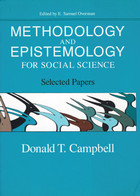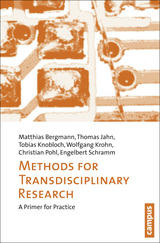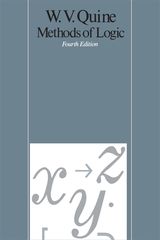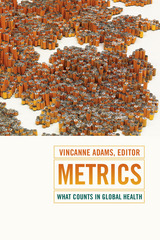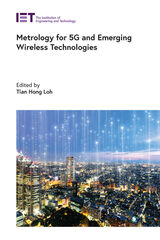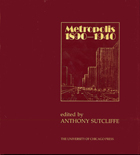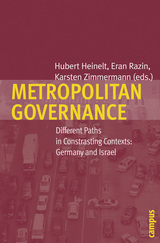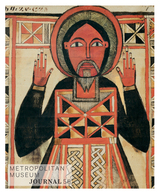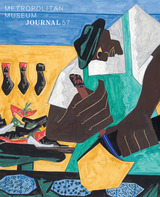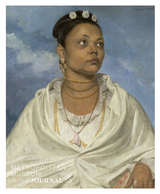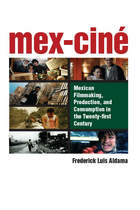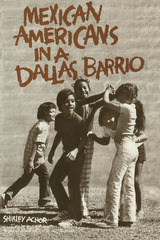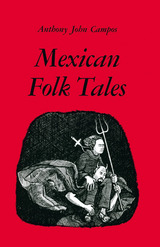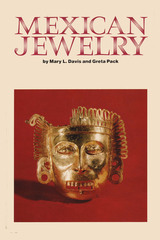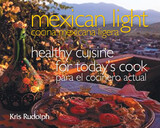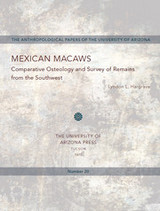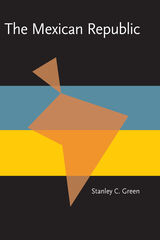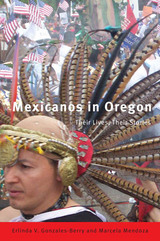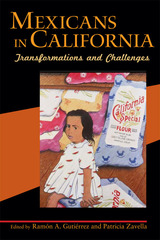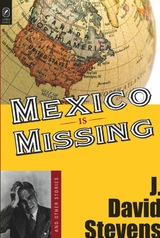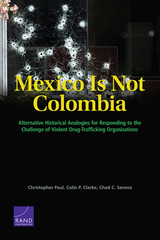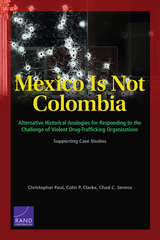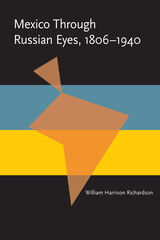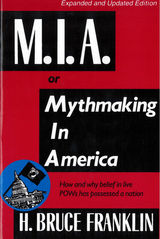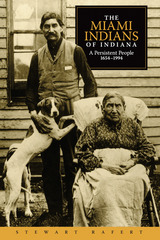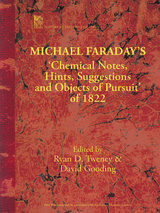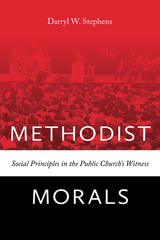 Methodist Morals: Social Principles in the Public Church's Witness
Darryl W. Stephens
University of Tennessee Press, 2016
Methodist Morals offers keen insight into the public church, interpreting the United Methodist Social Principles as a dynamic discourse about morality and human rights in light of faith. Revised every four years by the General Conference of the United Methodist Church, the Social Principles exposes the moral deliberations of this distinctly American and increasingly “worldwide” church as it struggles to achieve community across multiple languages and cultures. Perhaps no other document provides as rich a depiction of Protestants participating in the moral argument of public life.
This is the first full-length study of Methodist social teachings in over fifty years. Examining official Methodist teachings from institutional, historical, and cross-cultural perspectives, Darryl Stephens provides a rich analysis of this case study of Protestant social witness, drawing on his expertise in church polity, Methodist history, and Christian social ethics. A wide range of comparisons— with documents of the United Nations, with moral debate in Germany and Zimbabwe, and with historical Methodist statements of social witness—shows the Social Principles to be a unique form of social witness. The issues of war, abortion, human sexuality, and marriage illustrate the messiness of democratic deliberation in an ecclesial context and the evolution of a people ever concerned with the sin of “worldliness” even as they become more attuned to transforming social structures. Stephens also contrasts this conception of the public church with the ecclesiologies of prominent Methodist ethicists Stanley Hauerwas and Paul Ramsey.
Intended for students of Methodism, ecumenical church leaders, and scholars of Christian social ethics and contemporary US mainline religion, this work reveals the challenges to and possibilities for achieving moral community in an increasingly global and diverse world.
DARRYL W. STEPHENS, director of United Methodist studies at Lancaster Theological Seminary, is former assistant general secretary for advocacy and sexual ethics in the UMC’s General Commission on the Status and Role of Women. He is the coeditor of Professional Sexual Ethics: A Holistic Ministry Approach.
 Methodists and Muslims: My Life as an Orientalist
Richard W. Bulliet
Harvard University Press Richard W. Bulliet is an innovative historian of the Islamic world. His contributions have changed the way scholars think about the history of medieval city life, animal domestication, wheeled transport, religious conversion, Islamic institutions, and relations between Islam and Christianity. His fifty-year career at Harvard, Berkeley, and Columbia coincided with the rise of Middle East Studies as an American academic enterprise and with his Columbia colleague Edward Said’s book Orientalism, which set off a lasting debate over the value of Americans’ and Europeans’ studying non-Western cultures. In Methodists and Muslims, Bulliet has fashioned a critique of both Orientalism and Middle East Studies. His memoir also recounts how a young Methodist from Illinois made his way into the then-arcane field of Islamic Studies, became involved in shaping Middle East Studies, and developed relations with the Islamic Republic of Iran, culminating in the controversial visit to New York City by President Ahmadinejad of Iran.
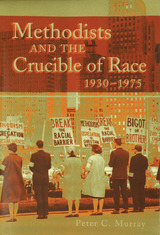 Methodists and the Crucible of Race, 1930-1975
Peter C. Murray
University of Missouri Press, 2004 In Methodists and the Crucible of Race, 1930–1975, Peter C. Murray contributes to the history of American Christianity and the Civil Rights movement by examining a national institution—the Methodist Church (after 1968 the United Methodist Church)—and how it dealt with the racial conflict centered in the South. Murray begins his study by tracing American Methodism from its beginnings to the secession of many African Americans from the church and the establishment of separate northern and southern denominations in the nineteenth century. He then details the reconciliation and compromise of many of these segments in 1939 that led to the unification of the church. This compromise created the racially segregated church that Methodists struggled to eliminate over the next thirty years. During the Civil Rights movement, American churches confronted issues of racism that they had previously ignored. No church experienced this confrontation more sharply than the Methodist Church. When Methodists reunited their northern and southern halves in 1939, their new church constitution created a segregated church structure that posed significant issues for Methodists during the Civil Rights movement. Of the six jurisdictional conferences that made up the Methodist Church, only one was not based on a geographic region: the Central Jurisdiction, a separate conference for “all Negro annual conferences.” This Jim Crow arrangement humiliated African American Methodists and embarrassed their liberal white allies within the church. The Supreme Court’s Brown v. Board of Education decision awakened many white Methodists from their complacent belief that the church could conform to the norms of the South without consequences among its national membership.
Murray places the struggle of the Methodist Church within the broader context of the history of race relations in the United States. He shows how the effort to destroy the barriers in the church were mirrored in the work being done by society to end segregation. Immensely readable and free of jargon, Methodists and the Crucible of Race, 1930–1975, will be of interest to a broad audience, including those interested in the Civil Rights movement and American church history.
Methodology and Epistemology for Social Sciences: Selected Papers
Donald T. Campbell
University of Chicago Press, 1988 Since the 1950s, Donald T. Campbell has been one of the most influential contributors to the methodology of the social sciences. A distinguished psychologist, he has published scores of widely cited journal articles, and two awards, in social psychology and in public policy, have been named in his honor. This book is the first to collect his most significant papers, and it demonstrates the breadth and originality of his work.
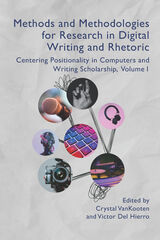 Methods and Methodologies for Research in Digital Writing and Rhetoric, Volume 1: Centering Positionality in Computers and Writing Scholarship
Crystal VanKooten
University Press of Colorado, 2023 Methods and Methodologies explores how researchers theorize, design, enact, reflect on, and revise digital writing research. The contributors to the two volumes of this edited collection explore how digital technologies can be used to solve problems, challenge the status quo, and address inequities. In some cases, they do so by using familiar digital technologies in novel ways. In other cases, they explain the use of relatively new or less familiar technologies such as digital mapping apps, Twitter bots, audio-visual captions, and computer programming code. By reflecting on the lessons that emerged from their work—and in particular on their own positionality—the authors provide methodological narratives that are personal, professional, and individual yet foundational. By combining attention to human positionality and digital technology, Methods and Methodologies addresses important social issues and questions related to writing and rhetoric.
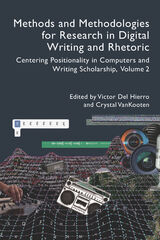 Methods and Methodologies for Research in Digital Writing and Rhetoric, Volume 2: Centering Positionality in Computers and Writing Scholarship
Victor Del Hierro
University Press of Colorado, 2023 Methods and Methodologies explores how researchers theorize, design, enact, reflect on, and revise digital writing research. The contributors to the two volumes of this edited collection explore how digital technologies can be used to solve problems, challenge the status quo, and address inequities. In some cases, they do so by using familiar digital technologies in novel ways. In other cases, they explain the use of relatively new or less familiar technologies such as digital mapping apps, Twitter bots, audio-visual captions, and computer programming code. By reflecting on the lessons that emerged from their work—and in particular on their own positionality—the authors provide methodological narratives that are personal, professional, and individual yet foundational. By combining attention to human positionality and digital technology, Methods and Methodologies addresses important social issues and questions related to writing and rhetoric.
Methods and Methodologies in Heritage Studies
Edited by Rachel King and Trinidad Rico
University College London, 2024 An interdisciplinary and insightful examination of heritage studies.
Methods and Methodologies in Heritage Studies offers succinct and accessible analyses of the current debates, intellectual legacies, and practical innovations on heritage value today. Using archaeology, anthropology, history, and geography, this multidisciplinary textbook is designed to support students, researchers, and practitioners, inviting them to review discussions of key problems and argumentative interventions in heritage studies.
Methods and Methodology in Composition Research
Gesa Kirsch and Patricia A. Sullivan
Southern Illinois University Press, 1992 In original essays, fourteen nationally known scholars examine the practical, philosophical, and epistemological implications of a variety of research traditions. Included are discussions of historical, theoretical, and feminist scholarship; case-study and ethnographic research; text and conversation analysis; and cognitive, experimental, and descriptive research. Issues that cross methodological boundaries, such as the nature of collaborative research and writing, methodological pluralism, the classification and coding of research data, and the politics of composition research, are also examined. Contributors reflect on their own research practices, and so reflect the current state of composition research itself.
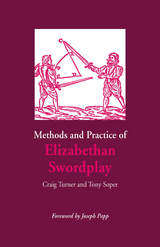 Methods and Practice of Elizabethan Swordplay
Craig Turner and Tony Soper. Foreword by Joseph Papp
Southern Illinois University Press, 1990 Featuring period drawings and prints of swordplay, this book examines and compares three Elizabethan fencing manuals written in English before 1600: Giacomo Di Grassi’s His True Arte of Defense (1594), Vincentio Saviolo’s His Practice in Two Bookes (1595), and George Silver’s Paradoxes of Defence and Bref Instructions upon My Paradoxes of Defence (1599). More than a technical manual on swordplay, this book explores the influence of a new form of violence introduced into Elizabethan culture by the invention of the rapier. The authors examine the rapier’s influence on the various social classes, the clash between the traditional English fencing masters and those embracing the new style, the growing concern with unregulated dueling, and the frequent references to rapier play in the works of Shakespeare and his contemporaries. As producer Joseph Papp notes in his foreword, this is a book that "makes a difference in performance."
Methods for Transdisciplinary Research: A Primer for Practice
Matthias Bergmann, Thomas Jahn, Tobias Knobloch, Wolfgang Krohn, Christian Pohl, and Engelbert Schramm
Campus Verlag, 2012 To solve real-world issues, the model of transdisciplinary research, which approaches from both the hard and social sciences, has recently come to the forefront. By integrating multiple disciplines as well as the expertise of partners from the societal practice, researchers are able to look at a problem from many angles, with the goal of making both societal and scientific advances. Methods for Transdisciplinary Research provides scholars with a model for conceptualizing and executing this type of work, while offering a systematic description of methods for knowledge integration that can be applied to any field, making it an indispensible guide for every transdisciplinary researcher and teacher.
 Methods in Medical Ethics
Jeremy Sugarman, MD, and Daniel P. Sulmasy, OFM, MD, Editors
Georgetown University Press, 2001 Medical ethics draws upon methods from a wide array of disciplines, including anthropology, economics, epidemiology, health services research, history, law, medicine, nursing, philosophy, psychology, sociology, and theology. In this first book to systematically examine, critique, and challenge some of these disciplines and their methods in light of their influence on medical ethics, leading scholars present particular methods that have played significant roles in the field. The methods addressed include philosophy, religion and theology, professional codes, law, casuistry, history, qualitative research, ethnography, quantitative surveys, experimental methods, and economics and decision science. Reviewing each, they provide descriptions of techniques, critiques, and notes on resources and training. Physician-assisted suicide and euthanasia are used as an illustration of the richness of multidisciplinary work applied to individual issues. Similarly, genetic testing is used as an example of how multiple descriptive methods may privilege certain findings. Methods in Medical Ethics is a valuable resource for scholars, teachers, editors, and students in any of the disciplines that have contributed to the field. As a textbook and reference for graduate students and scholars in medical ethics, it offers a rich understanding of the complexities of both moral questions and their answers.
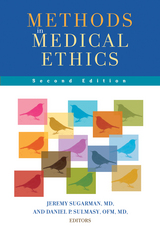 Methods in Medical Ethics: Second Edition
Jeremy Sugarman and Daniel P. Sulmasy, Editors
Georgetown University Press, 2013 Medical ethics draws upon methods from a wide array of disciplines, including anthropology, economics, epidemiology, health services research, history, law, medicine, nursing, philosophy, psychology, sociology, and theology. In this influential book, outstanding scholars in medical ethics bring these many methods together in one place to be systematically described, critiqued, and challenged. Newly revised and updated chapters in this second edition include philosophy, religion and theology, virtue and professionalism, casuistry and clinical ethics, law, history, qualitative research, ethnography, quantitative surveys, experimental methods, and economics and decision science. This second edition also includes new chapters on literature and sociology, as well as a second chapter on philosophy which expands the range of philosophical methods discussed to include gender ethics, communitarianism, and discourse ethics. In each of these chapters, contributors provide descriptions of the methods, critiques, and notes on resources and training. Methods in Medical Ethics is a valuable resource for scholars, teachers, editors, and students in any of the disciplines that have contributed to the field. As a textbook and reference for graduate students and scholars in medical ethics, it offers a rich understanding of the complexities involved in the rigorous investigation of moral questions in medical practice and research.
Methods of Crop Forecasting
Fred H. Sanderson
Harvard University Press Fred Sanderson, bringing together heretofore scattered material, gives a summary and critical appraisal of recent advances in the methodology of crop forecasting. Since advance knowledge of probable United States production is essential not only to farmers, dealers, railroads, banks, large consumers, manufacturers, and government agencies, but may well have worldwide repercussions, there is obvious need for a book of this sort.
Methods of Logic: Fourth Edition
W. V. Quine
Harvard University Press, 1982 This widely used textbook of modern formal logic now offers a number of new features. Incorporating updated notations, selective answers to exercises, expanded treatment of natural deduction, and new discussions of predicate-functor logic and the affinities between higher set theory and the elementary logic of terms, W. V. Quine’s new edition will serve admirably for both classroom and independent use.
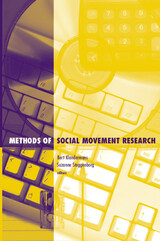 Methods Of Social Movement
Bert Klandermans
University of Minnesota Press, 2002 The definitive guide to conducting research in this dynamic field. Citing the critical importance of empirical work to social movement research, the editors of this volume have put together the first systematic overview of the major methods used by social movement theorists. Original chapters cover the range of techniques: surveys, formal models, discourse analysis, in-depth interviews, participant observation, case studies, network analysis, historical methods, protest event analysis, macro-organizational analysis, and comparative politics. Each chapter includes a methodological discussion, examples of studies employing the method, an examination of its strengths and weaknesses, and practical guidelines for its application. Contributors: Kathleen M. Blee, U of Pittsburgh; Elisabeth S. Clemens, U of Arizona; Donatella della Porta, U of Florence; Mario Diani, U of Trento, Italy; Martin D. Hughes; Hank Johnston, San Diego State U; Ruud Koopmans, Social Science Research Center, Berlin; Paul Lichterman, U of Wisconsin; Debra C. Minkoff, U of Washington; Daniel J. Myers, Notre Dame; Pamela E. Oliver, U of Wisconsin; Dieter Rucht, Social Science Research Center, Berlin; Jackie Smith, SUNY, Stony Brook; David A. Snow, U of California, Irvine; Sidney Tarrow, Cornell U; Verta Taylor, U of California, Santa Barbara; Danny Trom, École des Hautes Études en Sciences Sociales, Paris.
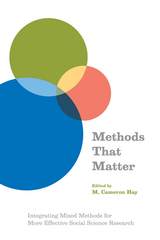 Methods That Matter: Integrating Mixed Methods for More Effective Social Science Research
Edited by M. Cameron Hay
University of Chicago Press, 2016 To do research that really makes a difference—the authors of this book argue—social scientists need questions and methods that reflect the complexity of the world. Bringing together a consortium of voices across a variety of fields, Methods that Matter offers compelling and successful examples of mixed methods research that do just that. In case after case, the researchers here break out of the traditional methodological silos that have long separated social science disciplines in order to better describe the intricacies of our personal and social worlds.
Historically, the largest division between social science methods has been that between quantitative and qualitative measures. For people trained in psychology or sociology, the bias has been toward the former, using surveys and experiments that yield readily comparable numerical results. For people trained in anthropology, it has been toward the latter, using ethnographic observations and interviews that offer richer nuances of meaning but are difficult to compare across societies. Discussing their own endeavors to combine the quantitative with the qualitative, the authors invite readers into a conversation about the best designs and practices of mixed methodologies to stimulate creative ideas and find new pathways of insight. The result is an engaging exploration of a promising new approach to the social sciences.
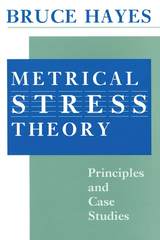 Metrical Stress Theory: Principles and Case Studies
Bruce Hayes
University of Chicago Press, 1994 In this account of metrical stress theory, Bruce Hayes builds on the notion that stress constitutes linguistic rhythm—that stress patterns are rhythmically organized, and that formal structures proposed for rhythm can provide a suitable account of stress. Through an extensive typological survey of word stress rules that uncovers widespread asymmetries, he identifies a fundamental distinction between iambic and trochaic rhythm, called the "Iambic/Trochaic law," and argues that it has pervasive effects among the rules and structures responsible for stress.
Hayes incorporates the iambic/trochaic opposition into a general theory of word stress assignment, intended to account for all languages in which stress is assigned on phonological as opposed to morphological principles. His theory addresses particularly problematic areas in metrical work, such as ternary stress and unusual weight distinctions, and he proposes new theoretical accounts of them. Attempting to take more seriously the claim of generative grammar to be an account of linguistic universals, Hayes proposes analyses for the stress patterns of over 150 languages.
Hayes compares his own innovative views with alternatives from the literature, allowing students to gain an overview of the field. Metrical Stress Theory should interest all who seek to understand the role of stress in language.
Metrics: What Counts in Global Health
Vincanne Adams, editor
Duke University Press, 2016 This volume's contributors evaluate the accomplishments, limits, and consequences of using quantitative metrics in global health. Whether analyzing maternal mortality rates, the relationships between political goals and metrics data, or the links between health outcomes and a program's fiscal support, the contributors question the ability of metrics to solve global health problems. They capture a moment when global health scholars and practitioners must evaluate the potential effectiveness and pitfalls of different metrics—even as they remain elusive and problematic.
Contributors. Vincanne Adams, Susan Erikson, Molly Hales, Pierre Minn, Adeola Oni-Orisan, Carolyn Smith-Morris, Marlee Tichenor, Lily Walkover, Claire L. Wendland
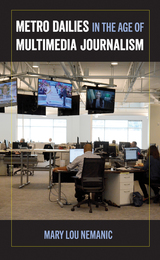 Metro Dailies in the Age of Multimedia Journalism
Mary Lou Nemanic
Temple University Press, 2020 The death of the daily newspaper in the internet age has been predicted for decades. While print newspapers are struggling from drops in advertising and circulation, their survival has been based on original reporting. Instead of a death knell, metro dailies are experiencing an identity crisis—a clash between traditional print journalism’s formality and detail and digital journalism’s informality and brevity. In Metro Dailies in the Age of Multimedia Journalism, Mary Lou Nemanic provides in-depth case studies of five mid-size city newspapers to show how these publications are adapting to the transition from print-only to multiplatform content delivery—and how newsroom practices are evolving to address this change. She considers the successes when owners allow journalists to manage their newspapers—to ensure production of quality journalism under the protection of newspaper guilds—as well as how layoffs and resource cutbacks have jeopardized quality standards. Arguing for an integrated approach in which print and online reporting are considered complementary and visual journalism is emphasized across platforms, Nemanic suggests that there is a future for the endangered daily metro newspaper.
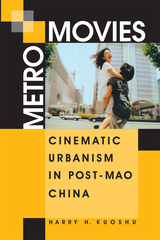 Metro Movies: Cinematic Urbanism in Post-Mao China
Harry H. Kuoshu
Southern Illinois University Press, 2010 Metro Movies: Cinematic Urbanism in Post-Mao China takes readers on a comprehensive tour of the urbanization of Chinese cinema. Focusing primarily on movies from the end of the twentieth century, it is the first single-authored work to explore the relationship between the changes in Chinese society—caused in part by the advent of postsocialism, the growth of cities, and globalization—and the transformation of Chinese cinema. Author Harry H. Kuoshu examines such themes as displacement, cinematic representation, youth subculture, the private emotional lives of emerging urbanites, raw urban realism, and the allegorical contrast of the city and the countryside to illustrate the artistic richness and cultural diversity of this cinematic genre. Kuoshu discusses the work of director Huang Jianxin, whose films follow and critique China’s changing urban political culture. He dedicates a chapter to filmmakers who followed Huang and attempted to redefine the concept of art films to regain the local audience. These directors address Chinese moviegoers’ disappointment with the international adoption of Chinese art films, their lack of interest in conventional Chinese films, and their fascination with emerging audio-video media. A considerable amount of attention is given to films of the 1990s, which focus on the social changes surfacing in China, from the trend of hooliganism and the Beijing rock scene to the arrival of an urban pop culture lifestyle driven by expansionist commerce and materialism. Kuoshu also explores recent films that confront the seedier aspects of city life, as well as films that demonstrate how urbanization has touched every fiber of Chinese living. Metro Movies illustrates how cinematic urbanism is no longer a genre indicator but is instead an era indicator, revealing the dominance of metropolitan living on modern Chinese culture. It gives new insight into contemporary Chinese politics and culture and provides readers with a better understanding of China’s urban cinema. This book will be an excellent addition to college film courses and will fascinate any reader with an interest in film studies or Chinese culture.
 Metroburbia, USA
Knox, Paul L
Rutgers University Press, 2008 Decades of economic prosperity in the United States have redefined the American dream. Paul Knox explores how extreme versions of this dream have changed the American landscape. Increased wealth has led America's metropolitan areas to develop into vast sprawling regions of "metroburbia"ùfragmented mixtures of employment and residential settings, combining urban and suburban characteristics. Upper-middle-class Americans are moving into larger homes in greater numbers, which leads Knox to explore the relationship between built form and material culture in contemporary society. He covers changes in home design, real estate, the work of developers, and the changing wishes of consumers. Knox shows that contemporary suburban landscapes are a product of consumer demand, combined with the logic of real estate development, mediated by design and policy professionals and institutions of governance. Suburban landscapes not only echo the fortunes of successive generations of inhabitants, Knox argues, they also reflect the country's changing core values. Knox addresses key areas of concern and importance to today's urban planners and suburban residents including McMansions, traffic disasters, house design, homeowner's associations, exclusionary politics, and big box stores. Through the inclusion of examples and photos, Metroburbia, USA creates an accessible portrait of today's suburbs supported by data, anecdotes, and social theory. It is a broad interpretation of the American metropolitan form that looks carefully at the different influences that contribute to where and how we live today.
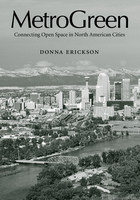 MetroGreen: Connecting Open Space in North American Cities
Donna Erickson
Island Press, 2006 In metropolitan areas across the country, you can hear the laments over the loss of green space to new subdivisions and strip malls. But some city residents have taken unprecedented measures to protect their open land, and a growing movement seeks not only to preserve these lands but to link them in green corridors. Many land-use and urban planning professionals, along with landscape architects and environmental advocates, have joined in efforts to preserve natural areas. MetroGreen answers their call for a deeper exploration of the latest thinking and newest practices in this growing conservation field. In ten case studies of U.S. and Canadian cities paired for comparative analysis-Toronto and Chicago, Calgary and Denver, and Vancouver and Portland among them-Erickson looks closely at the motivations and objectives for connecting open spaces across metropolitan areas. She documents how open-space networks have been successfully created and protected, while also highlighting the critical human and ecological benefits of connectivity. MetroGreen's unique focus on several cities rather than a single urban area offers a perspective on the political, economic, cultural, and environmental conditions that affect open-space planning and the outcomes of its implementation.
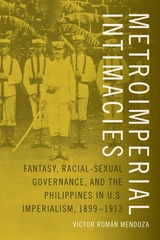 Metroimperial Intimacies: Fantasy, Racial-Sexual Governance, and the Philippines in U.S. Imperialism, 1899-1913
Victor Román Mendoza
Duke University Press, 2015 In Metroimperial Intimacies Victor Román Mendoza combines historical, literary, and archival analysis with queer-of-color critique to show how U.S. imperial incursions into the Philippines enabled the growth of unprecedented social and sexual intimacies between native Philippine and U.S. subjects. The real and imagined intimacies—whether expressed through friendship, love, or eroticism—threatened U.S. gender and sexuality norms. To codify U.S. heteronormative behavior, the colonial government prohibited anything loosely defined as perverse, which along with popular representations of Filipinos, regulated colonial subjects and depicted them as sexually available, diseased, and degenerate. Mendoza analyzes laws, military records, the writing of Philippine students in the United States, and popular representations of Philippine colonial subjects to show how their lives, bodies, and desires became the very battleground for the consolidation of repressive legal, economic, and political institutions and practices of the U.S. colonial state. By highlighting the importance of racial and gendered violence in maintaining control at home and abroad, Mendoza demonstrates that studies of U.S. sexuality must take into account the reach and impact of U.S. imperialism.
Metrology for 5G and Emerging Wireless Technologies
Tian Hong Loh
The Institution of Engineering and Technology, 2022 Metrology has a pivotal role to ensure the vision of fifth generation (5G) and emerging wireless technologies to be realised. It is essential to develop the underpinning metrology in response to the high demand for universal, dynamic, and data-rich wireless applications. As new technologies for 5G and beyond increasingly emerge in the arena of modern wireless devices/systems, the standards bodies, industries, and research communities are facing the challenge of diverse technological requirements, and on verifying products that meet desired performance parameters.
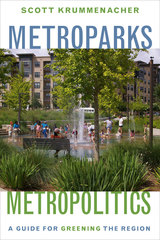 Metroparks, Metropolitics: A Guide for Greening the Region
Scott Krummenacher
Island Press Connecting fragments of undeveloped land into vibrant networks of trees, rivers, and open space is a grand accomplishment, with benefits that range from improved human health to stronger ecological systems. But getting support and financing from multiple local governments and communities presents huge challenges to these important initiatives. Metroparks, Metropolitics offers a perceptive analysis of how to achieve the elusive and important goal of creating regional greenspace networks.
Author Scott Krummenacher has studied greenspace systems for years, and offers answers to questions about engaging stakeholders and getting the resources and support that planners need. Krummenacher takes a detailed look at two comparable yet challenging metro areas, St. Louis and Kansas City, which have each created successful regional greenspace plans in different ways. He shows how the lessons they offer from their differing approaches can be incorporated into a strategy for any region, any greenspace initiative. Metroparks, Metropolitics combines rigorous policy analysis with key insights from policymakers, activists, and others who have been involved in successful campaigns.
While this book can’t guarantee that establishing a regional greenspace network will be easy, it is filled with both wisdom and practical advice for handling the obstacles that inevitably come up during these ambitious undertakings.
Metropolis 1890-1940
Edited by Anthony Sutcliffe
University of Chicago Press, 1984 An ideal and welcome reference and reader for students of urbanism, Metropolis 1890-1940 examines perceptions of the city during the dramatic urban growth of this period. Metropolis looks at the policies adopted to deal with the new city and at the views of the city expressed in the art, architecture, literature, cinema, music, and ideology of the time. Internationally known experts discuss case studies of London, Paris, Berlin, the Ruhr, New York, Moscow, and Tokyo, and a postscript brings the reader up to date with a survey of postwar urbanism.
 Metropolis 1985: An Interpretation of the Findings of the New York Metropolitan Region Study
Raymond Vernon
Harvard University Press This is the key volume in the New York Metropolitan Region Study. It is a synthesis and interpretation of the seven specialized books that have already been published and the one that is still awaiting publication. Here, at last, with a depth of perspective made possible by the author's familiarity with the unpublished as well as the published findings of the other participants in the Study, is the whole picture--New York's busy and varied economy as it is now, as it has been, and as it is likely to be twenty-five years from now.
Beginning with the visible present, Mr. Vernon with swift strokes lays bare the essentials of the economic history of the New York Region. He shows how its industries grew out of one another, the part played by labor, the early crucial role of the port, and the later crucial role of "clustering" that enables firms to share common facilities. He discusses the Region's advantages and disadvantages for different kinds of business and industry, the interrelation between the jobs in the Region and the people who live in it. He traces the movement of jobs geographically in and out of the Region as a whole, and also outward within the Region, relating this outward movement to such developments as the thinning-out of population in mid-city tenements and the continuing boom in suburban split-levels. He analyzes the problems besetting the multitude of local governments in the Region, and the crisis of commuting and rapid transit services. Finally he projects the metropolis of 1985, picturing it as all the infinitely complex forces of its history to date indicate that it will be, if these forces are not altered in their future operation by governmental actions of unprecedented magnitude.
In this book there is clearly presented the information that can enable the metropolitan dwellers themselves to communicate more effectively with the experts whose business is objective evaluation of urban problems. Once that communication is established, Mr. Vernon says, "We shall have moved a giant step closer to the objective of a more tolerable metropolitan environment."
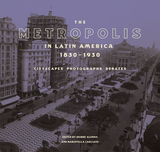 The Metropolis in Latin America, 1830-1930: Cityscapes, Photographs, Debates
Idurre Alonso
J. Paul Getty Trust, The, 2021 This volume examines the unprecedented growth of several cities in Latin America from 1830 to 1930, observing how sociopolitical changes and upheavals created the conditions for the birth of the metropolis.
In the century between 1830 and 1930, following independence from Spain and Portugal, major cities in Latin America experienced large-scale growth, with the development of a new urban bourgeois elite interested in projects of modernization and rapid industrialization. At the same time, the lower classes were eradicated from old city districts and deported to the outskirts. The Metropolis in Latin America, 1830–1930 surveys this expansion, focusing on six capital cities—Havana, Mexico City, Rio de Janeiro, Buenos Aires, Santiago de Chile, and Lima—as it examines sociopolitical histories, town planning, art and architecture, photography, and film in relation to the metropolis.
Drawing from the Getty Research Institute’s vast collection of books, prints, and photographs from this period, largely unpublished until now, this volume reveals the cities’ changes through urban panoramas, plans depicting new neighborhoods, and photographs of novel transportation systems, public amenities, civic spaces, and more. It illustrates the transformation of colonial cities into the monumental modern metropolises that, by the end of the 1920s, provided fertile ground for the emergence of today’s Latin American megalopolis.
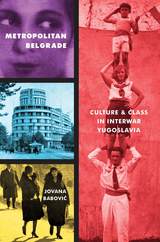 Metropolitan Belgrade: Culture and Class in Interwar Yugoslavia
Jovana Babovic
University of Pittsburgh Press, 2018 Winner of theMihajlo Misa Djordjevic Book Prizeawarded by the North American Society for Serbian Studies
Metropolitan Belgrade presents a sociocultural history of the city as an entertainment mecca during the 1920s and 1930s. It unearths the ordinary and extraordinary leisure activities that captured the attention of urban residents and considers the broader role of popular culture in interwar society.
As the capital of the newly unified Yugoslavia, Belgrade became increasingly linked to transnational networks after World War I, as jazz, film, and cabaret streamed into the city from abroad during the early 1920s. Belgrade’s middle class residents readily consumed foreign popular culture as a symbol of their participation in European metropolitan modernity. The pleasures they derived from entertainment, however, stood at odds with their civic duty of promoting highbrow culture and nurturing the Serbian nation within the Yugoslav state.
Ultimately, middle-class Belgraders learned to reconcile their leisured indulgences by defining them as bourgeois refinement. But as they endowed foreign entertainment with higher cultural value, they marginalized Yugoslav performers and their lower-class patrons from urban life. Metropolitan Belgrade tells the story of the Europeanization of the capital’s middle class and how it led to spatial segregation, cultural stratification, and the destruction of the Yugoslav entertainment industry during the interwar years.
 The Metropolitan Enigma: Inquiries into the Nature and Dimensions of America's Urban Crisis, Revised Edition
James Q. Wilson
Harvard University Press In a society which has made "urban crisis" a phrase peculiarly its own, it is strange how many different meanings are assigned to those two words. The theme of this book is that it is more important to disentangle and analyze the various problems which are indiscriminately referred to by this phrase than simply to issue a call to arms. To paraphrase the editor of The Metropolitan Enigma, James Q. Wilson, not everything about cities constitutes a problem and not all problems to be found in cities are distinctively "urban." This book seeks to explore the complexities and clear away the easy generalizations that prevent an understanding of the human problems of an urbanizing nation.
The essays in this book were written by Daniel P. Moynihan (Poverty in Cities), Bernard J. Frieden (Housing and National Urban Goals), Edward C. Banfield (Rioting Mainly for Fun and Profit), and other perceptive students of American society. Some of the papers reveal unexpected findings; others take an unusual perspective; each provides a fresh and lucid treatment of a difficult subject. No effort has been made to produce a work animated by a single point of view. A central idea of The Metropolitan Enigma is that there is no all-embracing strategy that can be put forward as an effective solution for the "urban crisis." Directed to everyone who is interested in the future of the American city, this is an important and valuable book.
The volume was first published in a soft-cover edition by the Task Force on Economic Growth and Opportunity of the United States Chamber of Commerce in 1966. The Joint Center for Urban Studies of M.I.T. and Harvard commissioned the articles. Each of the contributors has had an opportunity to revise his paper, and several essays have been substantially rewritten. Edward Banfield's essay appears here for the first time.
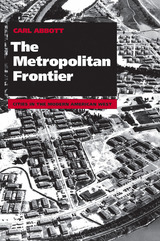 The Metropolitan Frontier: Cities in the Modern American West
Carl Abbott
University of Arizona Press, 1993 When the American West represented the country’s frontier, many of its cities may have seemed little more than trading centers to serve the outlying populace. Now the nation’s most open and empty region is also its most heavily urbanized, with eighty percent of Westerners living in its metropolitan areas. The process of urbanization that had already transformed the United States from a rural to an urban society between 1815 and 1930 has continued most clearly and completely in the modern West, where growth since 1940—spurred by mobilization for World War II—has constituted a distinct era in which Western cities have become national and even international pacesetters.
The Metropolitan Frontier places this last half-century of Western history in its urban context, making it the first comprehensive overview of urban growth in the region. Integrating the urban experience of all nineteen Western states, Carl Abbott ranges for evidence from Honolulu to Houston and from Fargo to Fairbanks to show how Western cities organize the region's vast spaces and connect them to the even larger sphere of the world economy. His survey moves from economic change to social and political response, examining the initial boom of the 1940s, the process of change in the following decades, and the ultimate impact of Western cities on their environments, on the Western regional character, and on national identity.
Today, a steadily decreasing number of Western workers are engaged in rural industries, but Western cities continue to grow. As ecological and social crises begin to affect those cities, Abbott’s study will prove required reading for historians, geographers, sociologists, urban planners, and all citizens concerned with America’s future.
 Metropolitan Governance: Conflict, Competition, and Cooperation
Richard C. Feiock, Editor
Georgetown University Press, 2004 Metropolitan Governance is the first book to bring together competing perspectives on the question and consequences of centralized vs. decentralized regional government. Presenting original contributions by some of the most notable names in the field of urban politics, this volume examines the organization of governments in metropolitan areas, and how that has an effect on both politics and policy. Existing work on metropolitan governments debates the consequences of interjurisdictional competition, but neglects the role of cooperation in a decentralized system. Feiock and his contributors provide evidence that local governments successfully cooperate through a web of voluntary agreements and associations, and through collective choices of citizens. This kind of "institutional collective action" is the glue that holds institutionally fragmented communities together. The theory of institutional collective action developed here illustrates the dynamics of decentralized governance and identifies the various ways governments cooperate and compete. Metropolitan Governance provides insight into the central role that municipal governments play in the governance of metropolitan areas. It explores the theory of institutional collective action through empirical studies of land use decisions, economic development, regional partnerships, school choice, morality issues, and boundary change—among other issues. A one-of-a-kind, comprehensive analytical inquiry invaluable for students of political science, urban and regional planning, and public administration—as well as for scholars of urban affairs and urban politics and policymakers—Metropolitan Governance blazes new territory in the urban landscape.
Metropolitan Governance: Different Paths in Contrasting Contexts: Germany and Israel
Edited by Hubert Heinelt, Eran Razin, and Karsten Zimmermann
Campus Verlag, 2011 As urban areas have grown and sprawl has spread in recent decades, metropolitan governments around the world have begun to look beyond city borders, establishing regional partnerships to help them deal with issues of transit, resource use, and more. Metropolitan Governance examines this trend through a close comparative study of seven metropolitan areas in Israel and Germany. While not neglecting the reasons behind these changes in governance, the authors pay particular attention to their effects on—and diminishing of—democratic participation and accountability.
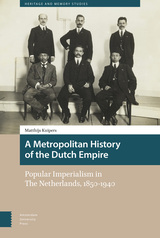 A Metropolitan History of the Dutch Empire: Popular Imperialism in The Netherlands, 1850-1940
Matthijs Kuipers
Amsterdam University Press, 2022 A Metropolitan History of the Dutch Empire: Popular Imperialism in The Netherlands, 1850-1940 examines popular imperial culture in the Netherlands around the turn of the twentieth century. In various and sometimes unexpected places in civil society the empire played a prominent role and was key in mobilizing people for causes that were directly and indirectly related to the Dutch overseas colonies. At the same time, however, the empire was ostensibly absent from people's minds. Except for some jingoist outbursts during the Aceh War and the Boer War, indifference was the main attitude with which imperial affairs were greeted. How could the empire simultaneously be present and absent in metropolitan life? Drawing upon the works of scholars from fields ranging from postcolonial studies to Habsburg imperialism, the author argues that indifference to empire was not an anomaly to the idea of an all-permeating imperial culture, but rather the logical consequence of an imperial ideology that rendered metropole and colony firmly separated entities. The different groups and individuals that advocated imperial or anti-imperial causes – such as missionaries, former colonials, Indonesian students, and boy scouts – hardly ever related to each other explicitly and had their own distinctive modes of expression, but were nonetheless part of what the author calls a 'fragmented empire' and shared the common thread of Dutch imperial ideology. This suggests we should not mistake colonial culture's metropolitan invisibility for a lack of strength.
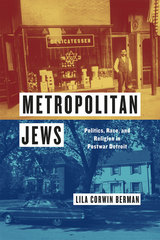 Metropolitan Jews: Politics, Race, and Religion in Postwar Detroit
Lila Corwin Berman
University of Chicago Press, 2015 In this provocative and accessible urban history, Lila Corwin Berman considers the role that Detroit’s Jews played in the city’s well-known narrative of migration and decline. Taking its cue from social critics and historians who have long looked toward Detroit to understand twentieth-century urban transformations, Metropolitan Jews tells the story of Jews leaving the city while retaining a deep connection to it. Berman argues convincingly that though most Jews moved to the suburbs, urban abandonment, disinvestment, and an embrace of conservatism did not invariably accompany their moves. Instead, the Jewish postwar migration was marked by an enduring commitment to a newly fashioned urbanism with a vision of self, community, and society that persisted well beyond city limits.
Complex and subtle, Metropolitan Jews pushes urban scholarship beyond the tenacious black/white, urban/suburban dichotomy. It demands a more nuanced understanding of the process and politics of suburbanization and will reframe how we think about the American urban experiment and modern Jewish history.
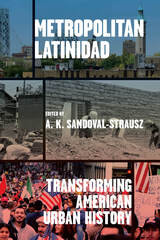 Metropolitan Latinidad: Transforming American Urban History
Edited by A. K. Sandoval-Strausz
University of Chicago Press, 2025 A wide-ranging collection of essays that centers Latinos in the history of American cities and suburbs.
Latino urban history has been underappreciated not only in its own right but for the centrality of its narratives to urban history as a field. A scholarly discipline that has long scrutinized economics, politics, and the built environment has too often framed race as literally Black and white. This has resulted in a fundamental misunderstanding of the full social canvas of American cities since at least the early twentieth century.
Traversing metropolitan areas like Atlanta, Chicago, El Paso, Fort Worth, Los Angeles, Miami, and New York, this collection of essays brings together both established and emerging scholars, including long-time urbanists and academics working in the fields of Latino, borderlands, political, landscape, and religious history. Organized at different scales—including city, suburb, neighborhood, and hemisphere—this impressive body of work challenges long-standing narratives about metropolitan America. The contributors—Llana Barber, Mauricio Castro, Eduardo Contreras, Sandra I. Enríquez, Monika Gosin, Cecilia Sánchez Hill, Felipe Hinojosa, Michael Innis-Jiménez, Max Krochmal, Becky M. Nicolaides, Pedro A. Regalado, Iliana Yamileth Rodriguez, and Thomas J. Sugrue—engage a diverse range of subjects, such as urban rebellions, the suburbanization of Latinos, affordable housing, labor, the built environment, transnationalism, place-making, and religious life. The scholars also explore race within Latino communities, as well as the role that political and economic dynamics have played in creating Latino urban spaces. After reading this book, you will never see American cities the same way again.
Metropolitan Museum Journal, volume 56 number 1 (January 2021)
The University of Chicago Press
University of Chicago Press Journals, 2021 This is volume 56 issue 1 of Metropolitan Museum Journal. Founded in 1968, the Metropolitan Museum Journal is a blind, peer-reviewed scholarly journal published annually that features original research on the history, interpretation, conservation, and scientific examination of works of art in the Museum’s collection. Its scope encompasses the diversity of artistic practice from antiquity to the present day. The Journal encourages contributions offering critical and innovative approaches that will further our understanding of works of art.
Metropolitan Museum Journal, volume 57 number 1 (January 2022)
The University of Chicago Press
University of Chicago Press Journals, 2022 This is volume 57 issue 1 of Metropolitan Museum Journal. Founded in 1968, the Metropolitan Museum Journal is a blind, peer-reviewed scholarly journal published annually that features original research on the history, interpretation, conservation, and scientific examination of works of art in the Museum’s collection. Its scope encompasses the diversity of artistic practice from antiquity to the present day. The Journal encourages contributions offering critical and innovative approaches that will further our understanding of works of art.
Metropolitan Museum Journal, volume 58 number 1 (January 2023)
The University of Chicago Press
University of Chicago Press Journals, 2023 This is volume 58 issue 1 of Metropolitan Museum Journal. Founded in 1968, the Metropolitan Museum Journal is a blind, peer-reviewed scholarly journal published annually that features original research on the history, interpretation, conservation, and scientific examination of works of art in the Museum’s collection. Its scope encompasses the diversity of artistic practice from antiquity to the present day. The Journal encourages contributions offering critical and innovative approaches that will further our understanding of works of art.
Metropolitan Museum Journal, volume 59 number 1 (January 2024)
The University of Chicago Press
University of Chicago Press Journals, 2024 This is volume 59 issue 1 of Metropolitan Museum Journal. Founded in 1968, the Metropolitan Museum Journal is a blind, peer-reviewed scholarly journal published annually that features original research on the history, interpretation, conservation, and scientific examination of works of art in the Museum’s collection. Its scope encompasses the diversity of artistic practice from antiquity to the present day. The Journal encourages contributions offering critical and innovative approaches that will further our understanding of works of art.
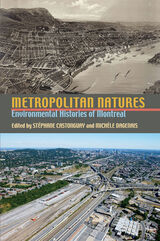 Metropolitan Natures: Environmental Histories of Montreal
Stéphane Castonguay
University of Pittsburgh Press, 2011
One of the oldest metropolitan areas in North America, Montreal has evolved from a remote fur trading post in New France into an international center for services and technology. A city and an island located at the confluence of the Ottawa and St. Lawrence Rivers, it is uniquely situated to serve as an international port while also providing rail access to the Canadian interior. The historic capital of the Province of Canada, once Canada’s foremost metropolis, Montreal has a multifaceted cultural heritage drawn from European and North American influences. Thanks to its rich past, the city offers an ideal setting for the study of an evolving urban environment.
Metropolitan Natures presents original histories of the diverse environments that constitue Montreal and it region. It explores the agricultural and industrial transformation of the metropolitan area, the interaction of city and hinterland, and the interplay of humans and nature. The fourteen chapters cover a wide range of issues, from landscape representations during the colonial era to urban encroachments on the Kahnawake Mohawk reservation on the south shore of the island, from the 1918–1920 Spanish flu epidemic and its ensuing human environmental modifications to the urban sprawl characteristic of North America during the postwar period.
Situations that politicize the environment are discussed as well, including the economic and class dynamics of flood relief, highways built to facilitate recreational access for the middle class, power-generating facilities that invade pristine rural areas, and the elitist environmental hegemony of fox hunting. Additional chapters examine human attempts to control the urban environment through street planning, waterway construction, water supply, and sewerage.
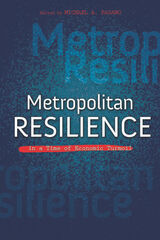 Metropolitan Resilience in a Time of Economic Turmoil
Edited by Michael A. Pagano
University of Illinois Press, 2013 Cities, counties, school districts and other local governments have suffered a long-lasting period of fiscal challenges since the beginning of the Great Recession. Metropolitan governments continue to adjust to the "new normal" of sharply lower property values, consumer sales, and personal income. Contributors to this volume include elected officials, academics, key people in city administrations, and other nationally recognized experts who discuss solutions to the urban problems created by the Great Recession. Metropolitan Resilience in a Time of Economic Turmoil looks at the capacity of local governments to mobilize resources efficiently and effectively, as well as the overall effects of the long-term economic downturn on quality of life. Introducing the reader to the fiscal effects of the Great Recession on cities, the book examines the initial fraying and subsequent mending of the social safety net, the opportunities for pursuing economic development strategies, the challenges of inter-jurisdictional cooperation, and the legacy costs of pension liabilities and infrastructure decay. Contributors are Phil Ashton, Raphael Bostic, Richard Feiock, Rachel A. Gordon, Rebecca Hendrick, Geoffrey J.D. Hewings, David Merriman, Richard Nathan, Michael A. Pagano, Breeze Richardson, Annette Steinacker, Nik Theodore, Rachel Weber, and Margaret Weir.
 Metternich: Strategist and Visionary
Wolfram Siemann
Harvard University Press, 2019 A compelling new biography that recasts the most important European statesman of the first half of the nineteenth century, famous for his alleged archconservatism, as a friend of realpolitik and reform, pursuing international peace.
Metternich has a reputation as the epitome of reactionary conservatism. Historians treat him as the archenemy of progress, a ruthless aristocrat who used his power as the dominant European statesman of the first half of the nineteenth century to stifle liberalism, suppress national independence, and oppose the dreams of social change that inspired the revolutionaries of 1848. Wolfram Siemann paints a fundamentally new image of the man who shaped Europe for over four decades. He reveals Metternich as more modern and his career much more forward-looking than we have ever recognized.
Clemens von Metternich emerged from the horrors of the Revolutionary and Napoleonic wars, Siemann shows, committed above all to the preservation of peace. That often required him, as the Austrian Empire’s foreign minister and chancellor, to back authority. He was, as Henry Kissinger has observed, the father of realpolitik. But short of compromising on his overarching goal Metternich aimed to accommodate liberalism and nationalism as much as possible. Siemann draws on previously unexamined archives to bring this multilayered and dazzling man to life. We meet him as a tradition-conscious imperial count, an early industrial entrepreneur, an admirer of Britain’s liberal constitution, a failing reformer in a fragile multiethnic state, and a man prone to sometimes scandalous relations with glamorous women.
Hailed on its German publication as a masterpiece of historical writing, Metternich will endure as an essential guide to nineteenth-century Europe, indispensable for understanding the forces of revolution, reaction, and moderation that shaped the modern world.
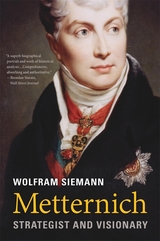 Metternich: Strategist and Visionary
Wolfram Siemann
Harvard University Press “A superb biographical portrait and work of historical analysis…Let us hope that it will serve if not as a manual then at least as an inspiration—good statesmanship is needed more than ever.”
—Brendan Simms, Wall Street Journal
“Brilliantly refreshes our understanding of Metternich and his era…[He] was an intellectual in politics of a kind now rare.”
—Christopher Clark, London Review of Books
“Succeed[s] in forcing readers to wonder whether Metternich’s efforts to defend an essentially conservative order against populists and terrorists are so different from the struggles that liberal democracies face today.”
—Andrew Moravcsik, Foreign Affairs
Metternich is often portrayed as the epitome of reactionary conservatism, a ruthless aristocrat who used his power to stifle liberalism and oppose the dreams of social change that inspired the revolutionaries of 1848. But in this landmark biography, the first to make use of state and family papers, Wolfram Siemann paints a fundamentally new image of the man, revealing him to be more forward-looking and nimble than we have ever recognized.
Clemens von Metternich emerged from the horrors of the Revolutionary and Napoleonic wars committed above all to the preservation of peace. As the Austrian Empire’s foreign minister and chancellor he was, as Henry Kissinger has observed, the father of realpolitik. But short of compromising on his overarching goal, Metternich aimed to accommodate liberalism and nationalism. Siemann draws on previously unexamined archives to bring this dazzling man to life.
Hailed as a masterpiece of historical writing, Metternich is indispensable for understanding the forces of revolution, reaction, and moderation that shaped the modern world.
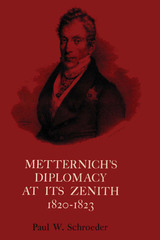 Metternich's Diplomacy at its Zenith, 1820-1823: Austria and the Congresses of Troppau, Laibach, and Verona
By Paul W. Schroeder
University of Texas Press, 1962 What Metiernich wanted at the peak of his career, why he wanted it, and the methods by which he achieved his goals are questions brilliantly answered in this survey and analysis of the Austrian chancellor's diplomacy during the period when he was the pre-eminent figure in European politics. Metternich's single-minded objective during 1820–1823 was to preserve the Austrian hegemony he had gained in Central Europe after long wars, enormous effort, and great sacrifice. If the internal security and international-power position secured by Austria at the Congress of Vienna were to be defended against the impact of widespread revolution in Europe, it was imperative that peace in Europe and the status quo be maintained. This required an unyielding opposition to all political movements that might disturb the equilibrium, especially French chauvinism and the spread of French constitutional ideas. A one-man distillate of the doctrine of absolute monarchy, Metternich was the relentless foe of any cause, just or unjust, that threatened European repose. Hence, when the revolution in Naples seriously menaced Austrian hegemony in Italy, Metternich determined that the constitutional regime in Naples must be overthrown by an Austrian armed force, an absolute monarchy restored, and an Austrian army of occupation kept there. Nor did he scruple to use duplicity, secret negotiation, trickery, or deceit against ally and adversary alike in his effort to enlist them in the common cause of all thrones. At the Congress of Troppau, Metternich succeeded not only in defeating Russian ideas for peaceful intervention and a moderate constitution at Naples, but also in converting Tsar Alexander to thoroughly conservative views, thereby making Russia a powerful supporter of Austrian policies and knowingly alienating England, formerly Austria's closest ally. Paul W. Schroeder brings to this bookexceptional scholarship and an objectivity hard to attain when dealing with a personality. Although Metternich, as Schroeder sees him, doubtless helped to maintain European peace and order, his real greatness consisted not in his European principles, but in his ability to defend Austrian interests under the guise of European principles. The evidence, gathered from documentary material in the Haus Hof- und Staatsarchiv in Vienna, has forced the author to the conclusion that Metternich was no real statesman. The very qualities that distinguished him as a brilliant diplomat—keen vision, cogent analysis, fertility of expedients, farsightedness, flexibility, and firmness of purpose—were converted into those of blindness to reality, superficial analysis, sterility of expedients, dogmatism, and failure of will when confronted with fundamental problems of state and society.
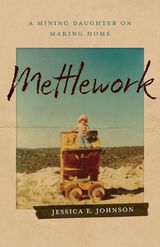 Mettlework: A Mining Daughter on Making Home
Jessica E. Johnson
Acre Books, 2024 A memoir of Johnson’s unusual upbringing during the 1970s and ’80s, interwoven with the story of her transition to parenthood in post-recession Portland, Oregon.
In the weeks after her first child is born, Jessica E. Johnson receives an email from her mother that contains artifacts of the author’s early childhood: scans of Polaroids and letters her mother wrote in mountain west mining camps and ghost towns—places without running water, companions, or help. Awash in love and restlessness, Johnson begins to see how the bedrock images of her isolated upbringing have stayed with her, even when she believed she was removing herself from their logic.
As she copes with the swirling pressures of parenting, teaching at an urban community college, and a partnership shaped by chronic illness, Johnson starts digging through her mother’s keepsakes and the histories of the places her family passed through, uncovering the linked misogyny and disconnection that characterized her childhood world—a world with uncomfortable echoes in the present and even in the act of writing itself. The resulting journey encompasses Johnson’s early memories, the story of the earth told in the language of geology, bits of vivid correspondence, a mothering manual from the early twentieth century, and the daily challenges of personal and collective care in a lonesome-crowded Pacific wonderland. Mettlework traces intergenerational failures of homemaking, traveling toward presence and relationship amid the remains of extractive industry and unsustainable notions of family.
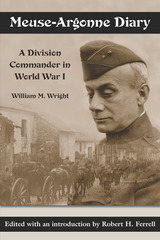 Meuse-Argonne Diary: A Division Commander in World War I
William M. Wright & Edited & Intro by Robert H. Ferrell
University of Missouri Press, 2004 September 13, 1918 Got no sleep at all last night. About two o'clock in the morning Col. Heintzelman, chief of staff of the corps, came out and he was much pleased with what the division had accomplished and with the way they had gone through. It was the division's first battle and it played a very important and creditable part. Certain things fell down. . . . The truth of the matter is the troops got away from the wire and it was impossible to keep the wire up through the tangle of barbed wire and woods. We captured 3,000 prisoners on our front alone and have lost 521. November 1, 1918 Considerable heavy artillery fire all night. The preparation fire went down promptly at 3:30, it was very heavy. . . . The barrage went down promptly at 5:30. Troops jumped off. At 7:30 thirty prisoners reported from Le Dhuy Fme., taken by the 353rd and 354th infantries. I don't understand what the 353rd Infantry is doing in there, as it is out of the sector. At 7:00 a.m. there was a distinct lull in the artillery fire. . . . I told Hanson at 8:05 to move his troops forward to parallel 86 immediately. He stated that he would get them going about 8:30, but actually did not get them started until about eleven o'clock. I sent for him on arrival and told him to hurry his men up. Before Lee left I had ordered the divisional reserve to move forward with its advance element on the first objective to maintain their echelonment in depth. Smyser came in at one o'clock and I ordered the divisional machine guns to the front to take position about one-half kilometer east of Dhuy Fme. At the time the reserves were ordered forward. I ordered Hanson to take his P.C. to Dhuy Fme. . . . Hanson has just arrived. I do not understand why he is always so slow. He seems to be inordinately stupid. During America’s participation in World War I, 1917–1918, only a single commander of a division, William M. Wright, is known to have kept a diary. In it, General Wright relates his two-month experience at St. Mihiel and especially the Meuse-Argonne, the largest and most costly battle in American history. In the Meuse-Argonne, the Eighty-ninth Division, made up of 28,000 draftees from Missouri and Kansas and under Wright’s command, was one of the two American point divisions beginning November 1, 1918, when the U.S. First Army forced the German defenders back to the Meuse River and helped end World War I as the main German railway line for the entire Western Front came under American artillery fire. It was a great moment, and Wright was at the center of it. Robert Ferrell skillfully supplements the diary with his own narrative, making use of pertinent manuscripts, notably a memoir by one of Wright’s infantry regiment commanders. The diary shows the exacting attention that was necessary to keep such a large, unwieldy mass of men in motion. It also shows how the work of the two infantry brigadiers and of the two supporting artillery brigades required the closest attention. Meuse-Argonne Diary, a unique account of, among other things, a singular moment in the Great War in which American troops ensured victory, will fascinate anyone interested in military history in general and World War I in particular.
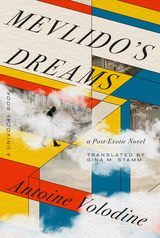 Mevlido's Dreams: A Post-Exotic Novel
Antoine Volodine
University of Minnesota Press, 2024 A postapocalyptic noir that asks if love and political ideals can survive civilizational collapse
A meditative, postapocalyptic noir, Mevlido’s Dreams is an urgent communiqué from a far-future reality of irreversible environmental damage and civilizational collapse. Mevlido is a double agent working for the police and living in the last habitable city on the planet, a sprawling abyssal ruin marked by war and ruled by criminals. Suspended in the bardo between his loyalty to the surveillance state and to the anarchists, communists, and other rebels he monitors, Mevlido clings to life and hope—barely—in the city’s vast slums, haunted by the memory of the wife he failed to save during the last war and dreaming of a mysterious mission he is told he must accomplish. At the same time, an enigmatic organization existing elsewhere—the Organs—observes Mevlido’s actions and debates its responsibility to him and to humanity as a whole. Asking what it means to love and care for others at the end of the world, this dense, brilliantly detailed postcollapse reality imagined by Antoine Volodine is one that grows ever more relevant amidst intensifying climate and political catastrophes. A key work in Volodine’s post-exotic fictional universe, Mevlido’s Dreams envisions a world changed beyond recognition and ruled under irrational authoritarianism in which dreams nest within dreams and the boundaries between life and death are fluid and uncertain.
Mex-Ciné: Mexican Filmmaking, Production, and Consumption in the Twenty-first Century
Frederick Luis Aldama
University of Michigan Press, 2013 Mex-Cinéoffers an accessibly written, multidisciplinary investigation of contemporary Mexican cinema that combines industrial, technical, and sociopolitical analysis with analyses of modes of reception through cognitive theory. Mex-Cinéaims to make visible the twenty-first century Mexican film industry, its blueprints, and the cognitive and emotive faculties involved in making and consuming its corpus. A sustained, free-flowing book-length meditation, Mex-Ciné enriches our understanding of the way contemporary Mexican directors use specific technical devices, structures, and characterizations in making films in ways that guide the perceptual, emotive, and cognitive faculties of their ideal audiences, while providing the historical contexts in which these films are made and consumed.
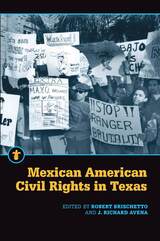 Mexican American Civil Rights in Texas
Robert Brischetto
Michigan State University Press, 2022 Inspired by a 1968 U.S. Commission on Civil Rights six-day hearing in San Antonio that introduced the Mexican American people to the rest of the nation, this book is an examination of the social change of Mexican Americans of Texas over the past half century. The San Antonio hearing included 1,502 pages of testimony, given by more than seventy witnesses, which became the baseline twenty experts used to launch their research on Mexican American civil rights issues during the following fifty years. These experts explored the changes in demographics and policies with regard to immigration, voting rights, education, employment, economic security, housing, health, and criminal justice. While there are a number of anecdotal historical accounts of Mexican Americans in Texas, this book adds an evidence-based examination of racial and ethnic inequalities and changes over the past half century. The contributors trace the litigation on behalf of Latinos and other minorities in state and federal courts and the legislative changes that followed, offering public policy recommendations for the future. The fact that this study is grounded in Texas is significant, as it was the birthplace of a majority of Chicano civil rights efforts and is at the heart of Mexican American growth and talent, producing the first Mexican American in Congress, the first Mexican American federal judge, and the first Mexican American candidate for president. As the largest ethnic group in the state, Latinos will continue to play a major role in the future of Texas.
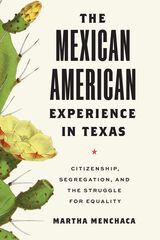 The Mexican American Experience in Texas: Citizenship, Segregation, and the Struggle for Equality
By Martha Menchaca
University of Texas Press, 2022 A historical overview of Mexican Americans' social and economic experiences in Texas
For hundreds of years, Mexican Americans in Texas have fought against political oppression and exclusion—in courtrooms, in schools, at the ballot box, and beyond. Through a detailed exploration of this long battle for equality, this book illuminates critical moments of both struggle and triumph in the Mexican American experience. Martha Menchaca begins with the Spanish settlement of Texas, exploring how Mexican Americans’ racial heritage limited their incorporation into society after the territory’s annexation. She then illustrates their political struggles in the nineteenth century as they tried to assert their legal rights of citizenship and retain possession of their land, and goes on to explore their fight, in the twentieth century, against educational segregation, jury exclusion, and housing covenants. It was only in 1967, she shows, that the collective pressure placed on the state government by Mexican American and African American activists led to the beginning of desegregation. Menchaca concludes with a look at the crucial roles that Mexican Americans have played in national politics, education, philanthropy, and culture, while acknowledging the important work remaining to be done in the struggle for equality.
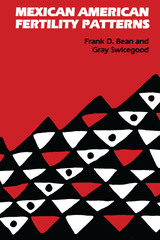 Mexican American Fertility Patterns
By Frank D. Bean and Gray Swicegood
University of Texas Press, 1985 The Mexican American population is the fastest growing major racial/ethnic group in the United States. During the decade 1970–1980, the Mexican origin population increased from 4.5 million to 8.7 million persons. High fertility, not immigration, was responsible for nearly two-thirds of this growth.
Recent and historical evidence shows that women of Mexican origin or descent bear significantly more children than other white women in the United States. Mexican American Fertility Patterns clarifies the nature and magnitude of these fertility differences by analyzing patterns of childbearing both across ethnic groups and within the Mexican American population.
Using data from the 1970 and 1980 U.S. Censuses and from the 1976 Survey of Income and Education, the authors evaluate various hypotheses of cultural, social, demographic, and/or economic factors as determinants of fertility differences. Empirical analyses center on the interrelationships between fertility and generational status, language usage and proficiency, and female education. This timely report concludes that Mexican American fertility is closest to that of other whites under conditions of greater access to the opportunity structures of the society.
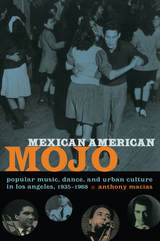 Mexican American Mojo: Popular Music, Dance, and Urban Culture in Los Angeles, 1935–1968
Anthony Macías
Duke University Press, 2008 Stretching from the years during the Second World War when young couples jitterbugged across the dance floor at the Zenda Ballroom, through the early 1950s when honking tenor saxophones could be heard at the Angelus Hall, to the Spanish-language cosmopolitanism of the late 1950s and 1960s, Mexican American Mojo is a lively account of Mexican American urban culture in wartime and postwar Los Angeles as seen through the evolution of dance styles, nightlife, and, above all, popular music. Revealing the links between a vibrant Chicano music culture and postwar social and geographic mobility, Anthony Macías shows how by participating in jazz, the zoot suit phenomenon, car culture, rhythm and blues, rock and roll, and Latin music, Mexican Americans not only rejected second-class citizenship and demeaning stereotypes, but also transformed Los Angeles. Macías conducted numerous interviews for Mexican American Mojo, and the voices of little-known artists and fans fill its pages. In addition, more famous musicians such as Ritchie Valens and Lalo Guerrero are considered anew in relation to their contemporaries and the city. Macías examines language, fashion, and subcultures to trace the history of hip and cool in Los Angeles as well as the Chicano influence on urban culture. He argues that a grass-roots “multicultural urban civility” that challenged the attempted containment of Mexican Americans and African Americans emerged in the neighborhoods, schools, nightclubs, dance halls, and auditoriums of mid-twentieth-century Los Angeles. So take a little trip with Macías, via streetcar or freeway, to a time when Los Angeles had advanced public high school music programs, segregated musicians’ union locals, a highbrow municipal Bureau of Music, independent R & B labels, and robust rock and roll and Latin music scenes.
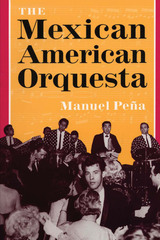 The Mexican American Orquesta: Music, Culture, and the Dialectic of Conflict
By Manuel Peña
University of Texas Press, 1999 The Mexican American orquesta is neither a Mexican nor an American music. Relying on both the Mexican orquesta and the American dance band for repertorial and stylistic cues, it forges a synthesis of the two. The ensemble emerges historically as a powerful artistic vehicle for the expression of what Manuel Peña calls the "dialectic of conflict." Grounded in ethnic and class conflict, this dialectic compels the orquesta and its upwardly mobile advocates to waver between acculturation and ethnic resistance. The musical result: a complex mesh of cultural elements—Mexican and American, working- and middle-class, traditional and contemporary. In this book, Manuel Peña traces the evolution of the orquesta in the Southwest from its beginnings in the nineteenth century through its pinnacle in the 1970s and its decline since the 1980s. Drawing on fifteen years of field research, he embeds the development of the orquesta within a historical-materialist matrix to achieve the optimal balance between description and interpretation. Rich in ethnographic detail and boldly analytical, his book is the first in-depth study of this important but neglected field of artistic culture.
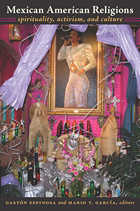 Mexican American Religions: Spirituality, Activism, and Culture
Gastón Espinosa and Mario T. García, eds.
Duke University Press, 2008 This collection presents a rich, multidisciplinary inquiry into the role of religion in the Mexican American community. Breaking new ground by analyzing the influence of religion on Mexican American literature, art, activism, and popular culture, it makes the case for the establishment of Mexican American religious studies as a distinct, recognized field of scholarly inquiry. Scholars of religion, Latin American, and Chicano/a studies as well as of sociology, anthropology, and literary and performance studies, address several broad themes. Taking on questions of history and interpretation, they examine the origins of Mexican American religious studies and Mario Barrera’s theory of internal colonialism. In discussions of the utopian community founded by the preacher and activist Reies López Tijerina, César Chávez’s faith-based activism, and the Los Angeles-based Católicos Por La Raza movement of the late 1960s, other contributors focus on mystics and prophets. Still others illuminate popular Catholicism by looking at Our Lady of Guadalupe, home altars, and Los Pastores dramas (nativity plays) as vehicles for personal, social, and political empowerment. Turning to literature, contributors consider Gloria Anzaldúa’s view of the borderlands as a mystic vision and the ways that Chicana writers invoke religious symbols and rhetoric to articulate a moral vision highlighting social injustice. They investigate the role of healing, looking at it in relation to both the Latino Pentecostal movement and the practice of the curanderismo tradition in East Los Angeles. Delving into to popular culture, they reflect on Luis Valdez’s video drama La Pastorela: “The Shepherds’ Play,” the spirituality of Chicana art, and the religious overtones of the reverence for the slain Tejana music star Selena. This volume signals the vibrancy and diversity of the practices, arts, traditions, and spiritualities that reflect and inform Mexican American religion. Contributors: Rudy V. Busto, Davíd Carrasco, Socorro Castañeda-Liles, Gastón Espinosa, Richard R. Flores, Mario T. García, María Herrera-Sobek, Luís D. León, Ellen McCracken, Stephen R. Lloyd-Moffett, Laura E. Pérez, Roberto Lint Saragena, Anthony M. Stevens-Arroyo, Kay Turner
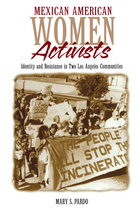 Mexican American Women Activists
Mary Pardo
Temple University Press, 1998 When we see children playing in a supervised playground or hear about a school being renovated, we seldom wonder about who mobilized the community resources to rebuild the school or staff the park. Mexican American Women Activists tells the stories of Mexican American women from two Los Angeles neighborhoods and how they transformed the everyday problems they confronted into political concerns. By placing these women's experiences at the center of her discussion of grassroots political activism, Mary Pardo illuminates the gender, race, and class character of community networking. She shows how citizens help to shape their local environment by creating resources for churches, schools, and community services and generates new questions and answers about collective action and the transformation of social networks into political networks.
By focusing on women in two contiguous but very different communities -- the working-class, inner-city neighborhood of Boyle Heights in Eastside Los Angeles and the racially mixed middle-class suburb of Monterey Park -- Pardo is able to bring class as ell as gender and ethnic concerns to bear on her analysis in ways that shed light on the complexity of mobilizing for urban change.
Unlike many studies, the stories told here focus on women's strengths rather than on their problems. We follow the process by which these women empowered themselves by using their own definitions of social justice and their own convictions about the importance of traditional roles. Rather than becoming political participants in spite of their family responsibilities, women in both neighborhoods seem to have been more powerful because they had responsibilities, social networks, and daily routines separate from the men in their communities.
Pardo asserts that the decline of real wages and the growing income gap means that unforunately most women will no longer be able to focus their energies on unpaid community work. She reflects on the consequences of this change for women's political involvement, as well as on the politics of writing about women and politics.
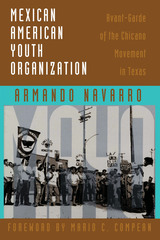 Mexican American Youth Organization: Avant-Garde of the Chicano Movement in Texas
By Armando Navarro
University of Texas Press, 1995 Among the protest movements of the 1960s, the Mexican American Youth Organization (MAYO) emerged as one of the principal Chicano organizations seeking social change. By the time MAYO evolved into the Raza Unida Party (RUP) in 1972, its influence had spread far beyond its Crystal City, Texas, origins. Its members precipitated some thirty-nine school walkouts, demonstrated against the Vietnam War, and confronted church and governmental bodies on numerous occasions. Armando Navarro here offers the first comprehensive assessment of MAYO's history, politics, leadership, ideology, strategies and tactics, and activist program. Interviews with many MAYO and RUP organizers and members, as well as first-hand knowledge drawn from his own participation in meetings, presentations, and rallies, enrich the text. This wealth of material yields the first reliable history of this extremely vocal and visible catalyst of the Chicano Movement. The book will add significantly to our understanding of Sixties protest movements and the social and political conditions that gave them birth.
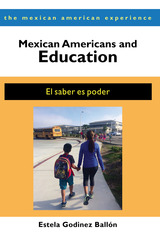 Mexican Americans and Education: El saber es poder
Estela Godinez Ballón
University of Arizona Press, 2015 As the Mexican American student population in U.S. public schools climbs to over 8 million, the establishment of policies that promote equity and respect have never been more crucial. In Mexican Americans and Education, Estela Godinez Ballón provides an overview of the relationship between Mexican Americans and all levels of U.S. public schooling.
Mexican Americans and Education begins with a brief overview of historical educational conditions that have impacted the experiences and opportunities of Mexican American students, and moves into an examination of major contemporary institutional barriers to academic success, including segregation, high-stakes testing, and curriculum tracking. Ballón also explores the status of Mexican American students in higher education and introduces theories and pedagogies that aim to understand and improve school conditions. Through her extensive examination of the major issues impacting Mexican American students, Ballón provides a broad introduction to an increasingly relevant topic.
Ballón uses understandable and accessible language to examine institutional and ideological factors that have negatively impacted Mexican Americans’ public school experiences, while also focusing on their strengths and possibilities for future action. This unique overview serves as a foundation for both education and Chicana/o studies courses, as well as in teacher and professional development.
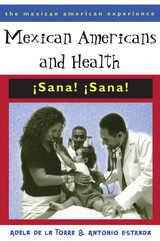 Mexican Americans and Health: ¡Sana! ¡Sana!
Adela de la Torre and Antonia Estrada
University of Arizona Press, 2001 By the middle of the twenty-first century, one out of every six Americans will be of Mexican descent; and as health care becomes of increasing concern to all Americans, the particular needs of Mexican Americans will have to be more thoroughly addressed. Mexican Americans and Health explains how the health of Mexican-origin people is often related to sociodemographic conditions and genetic factors, while historical and political factors influence how Mexican Americans enter the health care system and how they are treated once they access it. It considers such issues as occupational hazards for Mexican-origin agricultural workers—including pesticide poisoning, heat-related conditions, and musculoskeletal disorders—and women's health concerns, such as prenatal care, preventable cancers, and domestic violence. The authors clearly discuss the health status of Mexican Americans relative to the rest of the U.S. population, interweaving voices of everyday people to explain how today's most pressing health issues have special relevance to the Mexican American community:
- how values such as machismo, familismo, and marianismo influence care-seeking decisions and treatment of illness;
- how factors such as cultural values, socioeconomic status, peer pressure, and family concerns can contribute to substance abuse;
- how cultural attitudes toward sex can heighten the risk of AIDS—and how approaches to AIDS prevention and education need to reflect core cultural values such as familismo, respeto, and confianza. The book also addresses concerns of Mexican Americans regarding the health care system. These include not only access to care and to health insurance but also the shortage of bilingual and bicultural health care professionals. This coverage stresses not only the importance of linguistic competency but also the need to understand folklore illnesses, herbal remedies, and spiritual practices that can delay the treatment of illness and either complement or compromise treatment. Of all the issues that face the contemporary Mexican American community, none is as important to its very survival as health and health care. This timely book gives readers a broad understanding of these complex issues and points the way toward a healthier future for all people of Mexican origin. Mexican Americans and Health and Chicano Popular Culture are the first volumes in the series The Mexican American Experience, a cluster of modular texts designed to provide greater flexibility in undergraduate education. Each book deals with a single topic concerning the Mexican American population. Instructors can create a semester-length course from any combination of volumes, or may choose to use one or two volumes to complement other texts.
 Mexican Americans and Health: ¡Sana! ¡Sana!
Adela de la Torre and Antonio Estrada
University of Arizona Press, 2015 Given recent developments in health care and policy and a steadily increasing population of people of Mexican origin in the United States, a comprehensive look at Mexican American health has never been more necessary. Adela de la Torre and Antonio Estrada first accomplished such an overview with Mexican Americans and Health in 2001, and they have since continued to revise and expand their initial work. With a multitude of additions and renovations, Mexican Americans and Health, 2nd Edition provides a timely and accessible description of current topics in Latino health.
De la Torre and Estrada once again present a broad and nuanced understanding of recent issues involving Mexican American health and well-being, this time with the addition of discussions on: * the new U.S. Human Development Index to contextualize the health, education, and income status of Mexican Americans relative to other population groups,
* emerging diseases, such as diabetes and obesity,
* recent health-care reforms under the Obama administration,
* substance abuse, sexual risk, and psychological distress among HIV-positive individuals in the gay/bisexual community,
* and predictions of future trends for the next decade.
This new volume has been updated throughout to reflect the many developments in health care since its first edition. Mexican Americans and Health, 2nd Edition continues to present data on a large number of health issues that are important and relevant to the Mexican American population, while describing the social contexts in which they are occurring. Its comprehensive and interdisciplinary approach brings originality and focus to a dynamic literature.
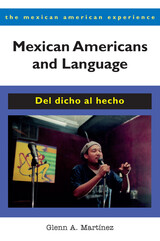 Mexican Americans and Language: Del dicho al hecho
Glenn A. Martínez
University of Arizona Press, 2006 When political activists rallied for the abolition of bilingual education and even called for the declaration of English as an official language, Mexican Americans and other immigrant groups saw this as an assault on their heritage and civil rights. Because language is such a defining characteristic of Mexican American ethnicity, nearly every policy issue that touches their lives involves language in one way or another.
This book offers an overview of some of the central issues in the Mexican American language experience, describing it in terms of both bilingualism and minority status. It is the first book to focus on the historical, social, political, and structural aspects of multiple languages in the Mexican American experience and to address the principles and methods of applied sociolinguistic research in the Mexican American community. Spanish and non-Spanish speakers in the Mexican American community share a common set of social and ethnic bonds. They also share a common experience of bilingualism.
As Martínez observes, the ideas that have been constructed around bilingualism are as important to understanding the Mexican American language experience as bilingualism itself. Mexican Americans and Language gives students the background they need to respond to the multiple social problems that can result from the language differences that exist in the Mexican American community. By showing students how to go from word to deed (del dicho al hecho), it reinforces the importance of language for their community, and for their own lives and futures.
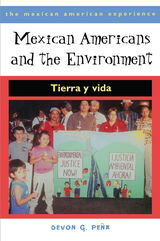 Mexican Americans and the Environment: Tierra y Vida
Devon G. Peña
University of Arizona Press, 2005 Mexican Americans have traditionally had a strong land ethic, believing that humans must respect la tierra because it is the source of la vida. As modern market forces exploit the earth, communities struggle to control their own ecological futures, and several studies have recorded that Mexican Americans are more impacted by environmental injustices than are other national-origin groups. In our countryside, agricultural workers are poisoned by pesticides, while farmers have lost ancestral lands to expropriation. And in our polluted inner cities, toxic wastes sicken children in their very playgrounds and homes. This book addresses the struggle for environmental justice, grassroots democracy, and a sustainable society from a variety of Mexican American perspectives. It draws on the ideas and experiences of people from all walks of life—activists, farmworkers, union organizers, land managers, educators, and many others—who provide a clear overview of the most critical ecological issues facing Mexican-origin people today. The text is organized to first provide a general introduction to ecology, from both scientific and political perspectives. It then presents an environmental history for Mexican-origin people on both sides of the border, showing that the ecologically sustainable Norteño land use practices were eroded by the conquest of El Norte by the United States. It finally offers a critique of the principal schools of American environmentalism and introduces the organizations and struggles of Mexican Americans in contemporary ecological politics. Devon Peña contrasts tenets of radical environmentalism with the ecological beliefs and grassroots struggles of Mexican-origin people, then shows how contemporary environmental justice struggles in Mexican American communities have challenged dominant concepts of environmentalism. Mexican Americans and the Environment is a didactically sound text that introduces students to the conceptual vocabularies of ecology, culture, history, and politics as it tells how competing ideas about nature have helped shape land use and environmental policies. By demonstrating that any consideration of environmental ethics is incomplete without taking into account the experiences of Mexican Americans, it clearly shows students that ecology is more than nature study but embraces social issues of critical importance to their own lives.
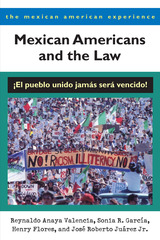 Mexican Americans and the Law: ¡El pueblo unido jamás será vencido!
Reynaldo Anaya Valencia, Sonia R. García, Henry Flores, and José Roberto Juárez Jr.
University of Arizona Press, 2004 The experience of Mexican Americans in the United States has been marked by oppression at the hands of the legal system—but it has also benefited from successful appeals to the same system. Mexican Americans and the Law illustrates how Mexican Americans have played crucial roles in mounting legal challenges regarding issues that directly affect their political, educational, and socioeconomic status. Each chapter highlights historical contexts, relevant laws, and policy concerns for a specific issue and features abridged versions of significant state and federal cases involving Mexican Americans. Beginning with People v. Zammora (1940), the trial that was a precursor to the Zoot Suit Riots in Los Angeles during World War II, the authors lead students through some of the most important and precedent-setting cases in American law:
- Educational equality: from segregation concerns in Méndez v. Westminster (1946) to unequal funding in San Antonio Independent School District vs. Rodríguez (1973)
- Gender issues: reproductive rights in Madrigal v. Quilligan (1981), workplace discrimination in EEOC v. Hacienda Hotel (1989), sexual violence in Aguirre-Cervantes v. INS (2001)
- Language rights: Ýñiguez v. Arizonans for Official English (1995), García v. Gloor (1980), Serna v. Portales Municipal Schools (1974)
- Immigration-: search and seizure questions in U.S. v. Brignoni-Ponce (1975) and U.S. v. Martínez-Fuerte (1976); public benefits issues in Plyler v. Doe (1982) and League of United Latin American Citizens v. Wilson (1997)
- Voting rights: redistricting in White v. Regester (1973) and Bush v. Vera (1996)
- Affirmative action: Hopwood v. State of Texas (1996) and Coalition for Economic Equity v. Wilson (1997)
- Criminal justice issues: equal protection in Hernández v. Texas (1954); jury service in Hernández v. New York (1991); self incrimination in Miranda v. Arizona (1966); access to legal counsel in Escobedo v. Illinois (1964) With coverage as timely as the 2003 Supreme Court decision on affirmative action, Mexican Americans and the Law offers invaluable insight into legal issues that have impacted Mexican Americans, other Latinos, other racial minorities, and all Americans. Discussion questions, suggested readings, and Internet sources help students better comprehend the intricacies of law.
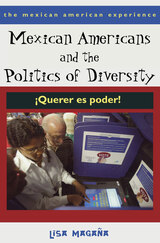 Mexican Americans and the Politics of Diversity: ¡Querer es poder!
Lisa Magaña
University of Arizona Press, 2005 With Mexican Americans now the nation’s fastest growing minority, major political parties are targeting these voters like never before. During the 2004 presidential campaign, both the Republicans and Democrats ran commercials on Spanish-language television networks, and in states across the nation the Mexican-American vote can now mean the difference between winning or losing an election. This book examines the various ways politics plays out in the Mexican-origin community, from grassroots action and voter turnout to elected representation, public policy creation, and the influence of lobbying organizations. Lisa Magaña illustrates the essential roles that Mexican Americans play in the political process and shows how, in just the last decade, there has been significant political mobilization around issues such as environmental racism, immigration, and affirmative action. Mexican Americans and the Politics of Diversity is directed to readers who are examining this aspect of political action for the first time. It introduces the demographic characteristics of Mexican Americans, reviewing demographic research regarding this population’s participation in both traditional and nontraditional politics, and reviews the major historical events that led to the community’s political participation and activism today. The text then examines Mexican American participation in electoral political outlets, including attitudes toward policy issues and political parties; considers the reasons for increasing political participation by Mexican American women; and explores the issues and public policies that are most important to Mexican Americans, such as education, community issues, housing, health care, and employment. Finally, it presents general recommendations and predictions regarding Mexican American political participation based on the demographic, cultural, and historical determinants of this population, looking at how political issues will affect this growing and dynamic population. Undoubtedly, Mexican Americans are a diverse political group whose interests cannot be easily pigeonholed, and, after reading this book, students will understand that their political participation and the community’s public policy needs are often unique. Mexican Americans and the Politics of Diversity depicts an important political force that will continue to grow in the coming decades.
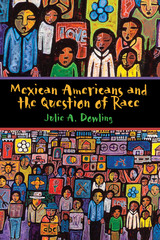 Mexican Americans and the Question of Race
By Julie A. Dowling
University of Texas Press, 2014 Honorable Mention, Oliver Cromwell Cox Book Award, presented by the Racial and Ethnic Minorities Section of the American Sociological Association, 2015 With Mexican Americans constituting a large and growing segment of U.S. society, their assimilation trajectory has become a constant source of debate. Some believe Mexican Americans are following the path of European immigrants toward full assimilation into whiteness, while others argue that they remain racialized as nonwhite. Drawing on extensive interviews with Mexican Americans and Mexican immigrants in Texas, Dowling’s research challenges common assumptions about what informs racial labeling for this population. Her interviews demonstrate that for Mexican Americans, racial ideology is key to how they assert their identities as either in or outside the bounds of whiteness. Emphasizing the link between racial ideology and racial identification, Dowling offers an insightful narrative that highlights the complex and highly contingent nature of racial identity.
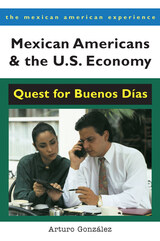 Mexican Americans and the U.S. Economy: Quest for Buenos Días
Arturo González
University of Arizona Press, 2002 As workers and consumers, Mexican Americans are a viable—and valuable—part of the broad U.S. economy. Despite that many are hindered by low education (and consequently low wages) and limited opportunities, they have continuously struggled for, and continue to seek, better days and the opportunity to realize their share of the American dream. This book examines the problems that Mexican Americans have experienced in attaining economic parity with non-Hispanic whites. It examines four major topics of particular concern to the economic status of the Mexican American community: - immigration, reviewing the Bracero Program, the Immigration Reform and Control Act of 1986, legislation from the 1990s, and the problems faced by immigrants today - education, stressing the importance of economic incentives to invest in education - wealth and poverty, evaluating opportunities and roadblocks as Mexican Americans aspire to middle-class standards of living - the labor market, covering such topics as employment, income, and discrimination. Arturo González has drawn on recent census data to present for the first time in one volume a detailed economic analysis of three generations of Mexican Americans. These statistics reveal a people who are steadily improving economically and provide evidence that stereotypes of Mexican Americans are outdated or erroneous. Mexican Americans and the U.S. Economy shows that economics is an important aspect of the Mexican American experience. The book helps broaden students' understanding of the community’s ongoing struggle, putting the quest for buenos días in clearer perspective.
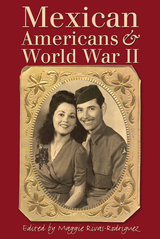 Mexican Americans and World War II
Edited by Maggie Rivas-Rodriguez
University of Texas Press, 2005 Up to 750,000 Mexican American men served in World War II, earning more Medals of Honor and other decorations in proportion to their numbers than any other ethnic group. Mexican American women entered the workforce on the home front, supporting the war effort and earning good wages for themselves and their families. But the contributions of these men and women have been largely overlooked as American society celebrates the sacrifices and achievements of the "Greatest Generation." To bring their stories out of the shadows, this book gathers eleven essays that explore the Mexican American experience in World War II from a variety of personal and scholarly perspectives. The book opens with accounts of the war's impact on individuals and families. It goes on to look at how the war affected school experiences; how Mexican American patriotism helped to soften racist attitudes; how Mexican Americans in the Midwest, unlike their counterparts in other regions of the country, did not experience greater opportunities as a result of the war; how the media exposed racist practices in Texas; and how Mexican nationals played a role in the war effort through the Bracero program and through the Mexican government's championing of Mexican Americans' rights. As a whole, the collection reveals that World War II was the turning point that gave most Mexican Americans their first experience of being truly included in American society, and it confirms that Mexican Americans of the "Greatest Generation" took full advantage of their new opportunities as the walls of segregation fell.
Mexican Americans in a Dallas Barrio
Shirley Achor
University of Arizona Press, 1978 This book vividly describes day-to-day barrio life in Dallas. Achor’s portrayal of the residents challenges stereotypes of traditional Mexican American culture and southwestern barrio life.
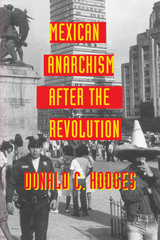 Mexican Anarchism after the Revolution
By Donald C. Hodges
University of Texas Press, 1995 Formal anarchist organizations disappeared in Mexico after the 1910 Revolution, but anarchist principles survive in the popular resistance movements against the post-revolutionary governments. In this book, Donald Hodges offers the first comprehensive treatment of the intellectual foundations, history, politics, and strategy of Mexican anarchism since the Revolution. Hodges interviewed leading Mexican anarchists, including Mónico Rodríguez Gómez, and gained access to documents of numerous guerrilla organizations, such as the previously missing "Plan de Cerro Prieto." Using both original and published sources, he shows how the political heirs of Ricardo Flores Magón, Mexico's foremost anarchist, agitated for workers' self-management and agrarian reform under the cover of the Mexican Communist party, how they played an important role in the student rebellion, and how, in the face of a labor movement that has come under government control, anarchism is currently experiencing a rebirth under another name.
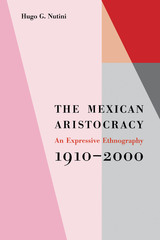 The Mexican Aristocracy: An Expressive Ethnography, 1910–2000
By Hugo G. Nutini
University of Texas Press, 2004 The Mexican aristocracy today is simultaneously an anachronism and a testimony to the persistence of social institutions. Shut out from political power by the democratization movements of the twentieth century, stripped of the basis of its great wealth by land reforms in the 1930s, the aristocracy nonetheless maintains a strong sense of group identity through the deeply held belief that their ancestors were the architects and rulers of Mexico for nearly four hundred years. This expressive ethnography describes the transformation of the Mexican aristocracy from the onset of the Mexican Revolution of 1910, when the aristocracy was unquestionably Mexico's highest-ranking social class, until the end of the twentieth century, when it had almost ceased to function as a superordinate social group. Drawing on extensive interviews with group members, Nutini maps out the expressive aspects of aristocratic culture in such areas as perceptions of class and race, city and country living, education and professional occupations, political participation, religion, kinship, marriage and divorce, and social ranking. His findings explain why social elites persist even when they have lost their status as ruling and political classes and also illuminate the relationship between the aristocracy and Mexico's new political and economic plutocracy.
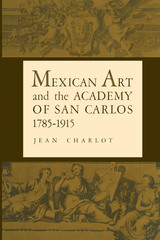 Mexican Art and the Academy of San Carlos, 1785-1915
By Jean Charlot
University of Texas Press, 1962 Was the Royal Academy of San Carlos, founded in 1785 by the King of Spain, beneficial or detrimental to the development of a valid, living art in Mexico? The answer lies in the archives of the school, but nobody thought about constructing an aesthetic history from them until Jean Charlot accidentally discovered their extent and interest while searching for other material. In this straightforward, documented account he presents not merely opinions and criticism but evidence, including curricula and contemporary drawings by students and teachers. Since Pre-Conquest art there have been, it is usually assumed, two periods in Mexican art: the Colonial and the Modern. Between these peaks lies the dark Academy-dominated hiatus called Neo-Classicism, an episode that this treatise makes the first attempt to under-stand. The academic canons imported from Europe during this period were undeniably wrong for the indigenous people, and especially wrong at a time when a revolutionary Mexico was struggling for its own identity. But instead of throwing out this strange episode as foreign and imitative, it now becomes possible to see it as a period of acculturation through which the Mexican spirit emerged. Aside from its interest as aesthetic history, this book makes an important contribution to the social history of Mexico. Some provocative ideas emerge: the interrelations between cultural and political attitudes, the historical impact of events and personalities on ideology. In the seesaw of political and financial fortunes, the worst moments of confusion were often the most pregnant artistically, with mexicanidad rising inevitably when official guidance weakened. As social history this account constitutes an interesting parallel to similar cultural experiences in the United States and in other countries of the Americas. Charlot presents this material without special pleading, but not without appraisal. He writes: “… in the periods when the Academy was most strictly run along academic lines, it helped the young, by contrast, to realize the meaning of freedom. When the school was manned by men blind to the Mexican tradition, and sensitive only to European values, their stubborn stand became a most healthy invitation to artistic revolution.”
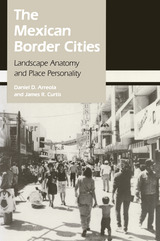 The Mexican Border Cities: Landscape Anatomy and Place Personality
Daniel D. Arreola and James R. Curtis
University of Arizona Press, 1993 From Matamoros to Tijuana, Mexican border cities have long evoked for their neighbors to the north images of cheap tourist playgrounds and, more recently, industrial satellites of American industry. These sensationalized and simplified perceptions fail to convey the complexity and diversity of urban form and function—and of cultural personality—that characterize these places.
The Mexican Border Cities draws on extensive field research to examine eighteen settlements along the 2,000-mile border, ranging from towns of less than 10,000 people to dynamic metropolises of nearly a million. The authors chronicle the cities' growth and compare their urban structure, analyzing them in terms of tourist districts, commercial landscapes, residential areas, and industrial and transportation quarters.
Arreola and Curtis contend that, despite their proximity to the United States, the border cities are fundamentally Mexican places, as distinguished by their cultural landscapes, including town plan, land-use pattern, and building fabric. Their study, richly illustrated with over 75 maps and photographs, offers a provocative and insightful interpretation of the geographic anatomy and personality of these fascinating—and rapidly changing—communities.
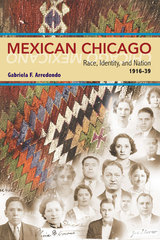 Mexican Chicago: Race, identity and Nation, 1916-39
Gabriela F. Arredondo
University of Illinois Press, 2007 Mexican Chicago builds on previous studies of Mexicans in the United States while challenging static definitions of “American” and underlying assumptions of assimilation. Gabriela F. Arredondo contends that because of the revolutionary context from which they came, Mexicans in Chicago between 1916 and 1939 were not just another ethnic group working to be assimilated into a city that has a long history of incorporating newcomers. Suggesting a new understanding of identity formation, she argues that Mexicans wielded tools of identification forged in revolutionary Mexico to collectively battle the prejudices of ethnic groups that included Poles, Italians, and the Irish, as well as African Americans. By turning inward, however, Mexicans also highlighted tremendous differences among themselves, such as gender and class. In discussing this distinctive process of becoming “Mexican” in Chicago during the early twentieth century, Arredondo not only explores how that identity was constructed but also provides telling insight into the repercussions of that identity formation process.
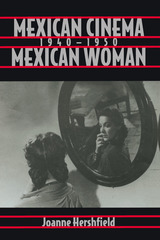 Mexican Cinema/Mexican Woman, 1940-1950
Joanne Hershfield
University of Arizona Press, 1996 The female image has been an ambiguous one in Mexican culture, and the place of women in Mexican cinema is no less tenuous--yielding in the films of Luis Buñuel and others a range of characterizations from virgin to whore, mother to femme fatale. Mexican Cinema/Mexican Woman, 1940-1950 examines a singular moment in the history of Mexican film to investigate the ways in which the cinematic figures of woman functioned to mediate narrative and social debates. The book raises new questions about the relations between woman and cinema. It will have broad appeal among students and scholars of film, feminist studies, and Latin American studies, as well as those interested in the popular culture of Mexico. Considering the historical and cultural representations of sexual difference as well as race and class, Hershfield closely examines the portrayal of women and gender identity in six films: María Candelaria (Emilio Fernández, 1943), Río Escondido (Emilio Fernández, 1947), Distinto amanecer (Julio Bracho, 1943), Salón México (Emilio Fernández, 1948), Doña Bárbara (Fernando de Fuentes, 1943), and Susana (Carne y demonio) (Luis Buñuel, 1950).
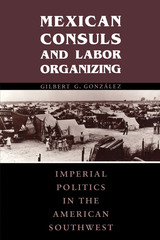 Mexican Consuls and Labor Organizing: Imperial Politics in the American Southwest
By Gilbert G. González
University of Texas Press, 1999 Chicano history, from the early decades of the twentieth century up to the present, cannot be explained without reference to the determined interventions of the Mexican government, asserts Gilbert G. González. In this pathfinding study, he offers convincing evidence that Mexico aimed at nothing less than developing a loyal and politically dependent emigrant community among Mexican Americans, which would serve and replicate Mexico's political and economic subordination to the United States. González centers his study around four major agricultural workers' strikes in Depression-era California. Drawing on a wide variety of sources, he documents how Mexican consuls worked with U.S. growers to break the strikes, undermining militants within union ranks and, in one case, successfully setting up a grower-approved union. Moreover, González demonstrates that the Mexican government's intervention in the Chicano community did not end after the New Deal; rather, it continued as the Bracero Program of the 1940s and 1950s, as a patron of Chicano civil rights causes in the 1960s and 1970s, and as a prominent voice in the debates over NAFTA in the late 1980s and early 1990s.
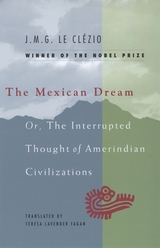 The Mexican Dream: Or, The Interrupted Thought of Amerindian Civilizations
J. M. G. Le Clézio
University of Chicago Press, 1993 Winner of the 2008 Nobel Prize for Literature, J. M. G. Le Clézio here conjures the consciousness of Mexico, powerfully evoking the dreams that made and unmade an ancient culture. Le Clézio’s haunting book takes us into the dream that was the religion of the Aztecs, a religion whose own apocalyptic visions anticipated the coming of the Spanish conquerors. Here the dream of the conquistadores rises before us, too, the glimmering idea of gold drawing Europe into the Mexican dream. Against the religion and thought of the Aztecs and the Tarascans and the Europeans in Mexico, Le Clézio also shows us those of the “barbarians” of the north, the nomadic Indians beyond the pale of the Aztec frontier. Finally, Le Clézio’s book is a dream of the present, a meditation on what in Amerindian civilizations—in their language, in their way of telling tales, of wanting to survive their own destruction—moved the poet, playwright, and actor Antonin Artaud and motivates Le Clézio in this book. His own deep identification with pre-Columbian cultures, whose faith told them the wheel of time would bring their gods and their beliefs back to them, finds fitting expression in this extraordinary book, which brings the dream around.
“We are lucky to have in Le Clézio a writer of great quality who brings his particular sensibility and talent here to remind us of the very nature of the rituals and myths of the civilizations of ancient Mexico; he provides us with descriptions as precise as they are mysterious.”—Le Figaro
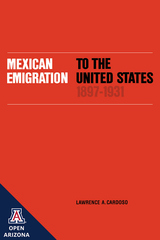 Mexican Emigration to the United States, 1897–1931
Lawrence A. Cardoso
University of Arizona Press, 1980 Rapid change in the land and labor system in rural Mexico during the 1890s destroyed the ancestral homes of the peasantry, forcing them either onto privately owned haciendas or into the migratory labor stream. The anarchy, inflation, and fear for personal safety that resulted from the Mexican Revolution of the 1910 provided a further impetus to migratory patterns that otherwise might not have emerged, considering the people's strong ties to their ancestral land.
During the same era, capitalist modernization in the United States was creating a strong demand for low-paid, unskilled labor, especially for agricultural and railroad work. Mexico's newly created class of migrant workers rushed across the border to fill this demand, setting in motion a social, economic, and political phenomenon that Lawrence Cardoso analyzed here in detail. What set this study apart, however, is the author's focus on the ' Human element," as revealed through the Mexican workers' hopes, fears, and reactions to events of their time.
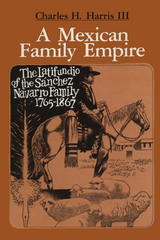 A Mexican Family Empire: The Latifundio of the Sánchez Navarro Family, 1765-1867
By Charles H. Harris III
University of Texas Press, 1975 Perhaps no other institution has had a more significant impact on Latin American history than the large landed estate—the hacienda. In Mexico, the latifundio, an estate usually composed of two or more haciendas, dominated the social and economic structure of the country for four hundred years. A Mexican Family Empire is a careful examination of the largest latifundio ever to have existed, not only in Mexico but also in all of Latin America—the latifundio of the Sánchez Navarros. Located in the northern state of Coahuila, the Sánchez Navarro family's latifundio was composed of seventeen haciendas and covered more than 16.5 million acres—the size of West Virginia. Charles H. Harris places the history of the latifundio in perspective by showing the interaction between the various activities of the Sánchez Navarros and the evolution of landholding itself. In his discussion of the acquisition of land, the technology of ranching, labor problems, and production on the Sánchez Navarro estate, and of the family's involvement in commerce and politics, Harris finds that the development of the latifundio was only one aspect in the Sánchez Navarros' rise to power. Although the Sánchez Navarros conformed in some respects to the stereotypes advanced about hacendados, in terms of landownership and the use of debt peonage, in many important areas a different picture emerges. For example, the family's salient characteristic was a business mentality; they built the latifundio to make money, with status only a secondary consideration. Moreover, the family's extensive commercial activities belie the generalization that the objective of every hacendado was to make the estates self-sufficient. Harris emphasizes the great importance of the Sánchez Navarros' widespread network of family connections in their commercial and political activities. A Mexican Family Empire is based on the Sánchez Navarro papers—75,000 pages of personal letters, business correspondence, hacienda reports and inventories, wills, land titles, and court records spanning the period from 1658 to 1895. Harris's thorough research of these documents has resulted in the first complete social, economic, and political history of a great estate. The geographical and chronological boundaries of his study permit analysis of both continuity and change in Mexico's evolving socioeconomic structure during one of the most decisive periods in its history—the era of transition from colony to nation.
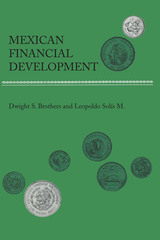 Mexican Financial Development
By Dwight S. Brothers and Leopoldo Solís M.
University of Texas Press, 1966 The development of the Mexican financial system as it has related to the remarkable growth of the Mexican economy is examined in this book. Believing that a better understanding of the past will permit a more nearly accurate appraisal of contemporary problems and facilitate the choice of intelligent policies in the future, the authors present a detailed chronicle and analysis of components of the Mexican financial system, with primary emphasis on the period from 1940 to the mid-1960s. Separate chapters are devoted to the money and capital market, the formulation and execution of monetary and financial policies, and the nature of Mexican financial experience in both the public and private sectors of the economy. The authors offer a theoretical explanation of the record of Mexican experience, based upon their analysis of relationships between monetary policy, domestic stability, and external equilibrium, as well as upon their analysis of factors governing the growth of domestic indebtedness, the development of financial intermediation, and the operation of the loanable funds market. The final chapter of the book, a review of Mexican experience from 1960 to 1965, speculates with respect to the future course of Mexican financial development and offers specific proposal for future monetary and financial policies. This record of Mexican financial development contains much that should be of interest to others engaged in related theoretical and empirical studies, including many lessons for those countries confronted with circumstances and problems not too unlike those encountered in Mexico.
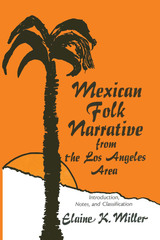 Mexican Folk Narrative from the Los Angeles Area: Introduction, Notes, and Classification
By Elaine K. Miller
University of Texas Press, 1973 Urban Los Angeles is the setting in which Elaine Miller has collected her narratives from Mexican-Americans. The Mexican folk tradition, varied and richly expressive of the inner life not only of a people but also of the individual as each lives it and personalizes it, is abundantly present in the United States. Since it is in the urban centers that most Mexican-Americans have lived, this collection represents an important contribution to the study of that tradition and to the study of the changes urban life effects on traditional folklore. The collection includes sixty-two legendary narratives and twenty traditional tales. The legendary narratives deal with the virgins and saints as well as with such familiar characters as the vanishing hitchhiker, the headless horseman, and the llorona. Familiar characters appear in the traditional tales—Juan del Oso, Blancaflor, Pedro de Ordimalas, and others. Elaine Miller concludes that the traditional tales are dying out in the city because tale telling itself is not suited to the fast pace of modern urban life, and the situations and characters in the tales are not perceived by the people to be meaningfully related to the everyday challenges and concerns of that life. The legendary tales survive longer in an urban setting because, although containing fantastic elements, they are related to the beliefs and hopes of the narrator—even in the city one may be led to buried treasure on some dark night by a mysterious woman. The penchant of the informants for the fantastic in many of their tales often reflects their hopes and fears, such as their dreams of suddenly acquiring wealth or their fears of being haunted by the dead. Miller closely observes the teller's relation to the stories—to the duendes, the ánimas, Death, God, the devil—and she notes the tension on the part of the informant in his relation to their religion. The material is documented according to several standard tale and motif indices and is placed within the context of the larger body of Hispanic folk tradition by the citation of parallel versions throughout the Hispanic world. The tales, transcribed from taped interviews, are presented in colloquial Spanish accompanied by summaries in English.
Mexican Folk Tales
Anthony John Campos
University of Arizona Press, 1977 Intriguing collection of authentic stories preserves a colorful part of the Mexican heritage. Tales center around Legends of the Devil, The strange Doings of the Saints, and The Mysteries of Human Life.
 Mexican Highland Cultures: Archaeological Researches at Teotihuacan, Calpoulalpan and Chalchicomula in 1934-35
Sigvald Linné
University of Alabama Press, 2003 Presents the broad picture and analysis of excavations at three cultural centers in central Mexico This classic work published in 1942, ten years after archaeological excavations were begun in the Valley of Mexico by Linné's team, presents additional data that had not been fully detailed in the previously published Archaeological Researches at Teotihuacan. It provides comparative information on the high-status ruins situated on the fringes of the Valley of Mexico and excavation results from a compound within the city of Teotihuacan. This information is of critical use to archaeologists still excavating at Teotihuacan in projecting compound extent, types of artifacts expected to be discovered, and patterns of artifacts to be found in particular types of rooms. The characteristics of burials is also explored. This book, along with its predecessor, is an important primary resource for Americanists. Staffan Brunius's foreword offers a broad background of Linné's life and work. The introduction by George Cowgill focuses more specifically on the conduct and impact of the archaeological exavations.
G. C. Vaillant has stated, "The greatest achievement of Dr. Linné from the viewpoint of the general student is the presentation of a technical field excavation in such terms that anyone can follow his text and see the relationship between the details of position of specimens and the larger problems of history and anthropology."
Sigvald Linné was Professor of Ethnography at the University of Stockholm and Director of the Swedish National Museum of Ethnography until 1969. He published several other books, including The Technique of South American Ceramics. Staffan Brunius is Curator of the Americas at the National Museum of Ethnography in Stockholm. George L. Cowgill is Professor of Anthropology at Arizona State University and coeditor of The Collapse of Ancient States and Civilizations.
Additional reviews:
This book . . . makes Linne's work widely available again to those interested and may prompt a new generation of specialists to examine the original material either in Stockholm's National Museum of Ethnography, Mexico's Museo Nacional de Antropologia or the Teotihuacan site itself. Testament to the lasting value of Linne's work is given in a succinct and helpful new introduction by anthropologist George L. Cowgill. A more recent curator of the Americas at Stockholm's ethnographical museum, Steffan Brunius, also chips in with a brief contextualization of Linne's work against the background of the early Swedish-American tradition.—The Historian
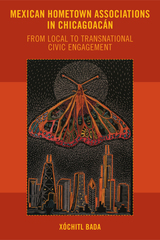 Mexican Hometown Associations in Chicagoacán: From Local to Transnational Civic Engagement
Bada, Xóchitl
Rutgers University Press Chicago is home to the second-largest Mexican immigrant population in the United States, yet the activities of this community have gone relatively unexamined by both the media and academia. In this groundbreaking new book, Xóchitl Bada takes us inside one of the most vital parts of Chicago’s Mexican immigrant community—its many hometown associations.
Hometown associations (HTAs) consist of immigrants from the same town in Mexico and often begin quite informally, as soccer clubs or prayer groups. As Bada’s work shows, however, HTAs have become a powerful force for change, advocating for Mexican immigrants in the United States while also working to improve living conditions in their communities of origin. Focusing on a group of HTAs founded by immigrants from the state of Michoacán, the book shows how their activism has bridged public and private spheres, mobilizing social reforms in both inner-city Chicago and rural Mexico.
Bringing together ethnography, political theory, and archival research, Bada excavates the surprisingly long history of Chicago’s HTAs, dating back to the 1920s, then traces the emergence of new models of community activism in the twenty-first century. Filled with vivid observations and original interviews, Mexican Hometown Associations in Chicagoacán gives voice to an underrepresented community and sheds light on an underexplored form of global activism.
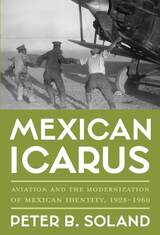 Mexican Icarus: Aviation and the Modernization of Mexican Identity, 1928-1960
Peter B. Soland
University of Pittsburgh Press, 2023 The development of aviation in Mexico reflected more than a pragmatic response to the material challenges brought on by the 1910 Revolution. It was also an effective symbol for promoting the aspirations of the new elite who attained prominence during the war and who fixated on technology as a measure of national progress. The politicians, industrialists, and cultural influencers in the media who made up this group molded the aviator into an avatar of modern citizenship. The figure of the pilot as a model citizen proved an adept vessel for disseminating the values championed by the official party of the Revolution and validating the technological determinism that underpinned its philosophy of development. At the same time, the archetype of the aviator camouflaged problematic aspects of the government’s unification and development plans that displaced and exploited poor and Indigenous communities.
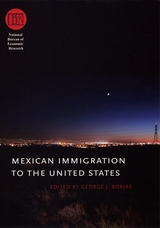 Mexican Immigration to the United States
Edited by George J. Borjas
University of Chicago Press, 2007 From debates on Capitol Hill to the popular media, Mexican immigrants are the subject of widespread controversy. By 2003, their growing numbers accounted for 28.3 percent of all foreign-born inhabitants of the United States. Mexican Immigration to the United States analyzes the astonishing economic impact of this historically unprecedented exodus. Why do Mexican immigrants gain citizenship and employment at a slower rate than non-Mexicans? Does their migration to the U.S. adversely affect the working conditions of lower-skilled workers already residing there? And how rapid is the intergenerational mobility among Mexican immigrant families?
This authoritative volume provides a historical context for Mexican immigration to the U.S. and reports new findings on an immigrant influx whose size and character will force us to rethink economic policy for decades to come. Mexican Immigration to the United States will be necessary reading for anyone concerned about social conditions and economic opportunities in both countries.
Mexican Jewelry
Mary L. Davis
University of Texas Press, 1963 Mexico’s streams give forth cool green jade and rich gold; its shores provide coral and dainty pearls. Its brown hills yield silver and copper and gems whose colors form a dazzling palette for the jeweler. And Mexico has never lacked the artists to mold its abundant jewels into finished pieces of beauty. In this enjoyable volume, Mary L. Davis and Greta Pack show us the splendors of Mexican jewelry. After briefly tracing the history of the jewelry of Mexico, they describe the various types and explain the basic techniques used in handling the metals of Mexican jewelry and in displaying the gems. Finally, they examine the creative accomplishments of some influential twentieth-century jewelry makers. A favorite among travelers, coilectors, and jewelry makers, Mexican Jewelry has become a classic introduction to the richness and variety of this Mexican folk art.
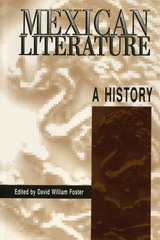 Mexican Literature: A History
Edited by David William Foster
University of Texas Press, 1994 Mexico has a rich literary heritage that extends back over centuries to the Aztec and Mayan civilizations. This major reference work surveys more than five hundred years of Mexican literature from a sociocultural perspective. More than merely a catalog of names and titles, it examines in detail the literary phenomena that constitute Mexico's most significant and original contributions to literature. Recognizing that no one scholar can authoritatively cover so much territory, David William Foster has assembled a group of specialists, some of them younger scholars who write from emerging trends in Latin American and Mexican literary scholarship. The topics they discuss include pre-Columbian indigenous writing (Joanna O'Connell), Colonial literature (Lee H. Dowling), Romanticism (Margarita Vargas), nineteenth-century prose fiction (Mario Martín Flores), Modernism (Bart L. Lewis), major twentieth-century genres (narrative, Lanin A. Gyurko; poetry, Adriana García; theater, Kirsten F. Nigro), the essay (Martin S. Stabb), literary criticism (Daniel Altamiranda), and literary journals (Luis Peña). Each essay offers detailed analysis of significant issues and major texts and includes an annotated bibliography of important critical sources and reference works.
Mexican Macaws: Comparative Osteology and Survey of Remains from the Southwest
Lyndon L. Hargrave
University of Arizona Press, 1970 The Anthropological Papers of the University of Arizona is a peer-reviewed monograph series sponsored by the School of Anthropology. Established in 1959, the series publishes archaeological and ethnographic papers that use contemporary method and theory to investigate problems of anthropological importance in the southwestern United States, Mexico, and related areas.
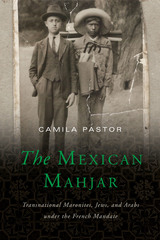 The Mexican Mahjar: Transnational Maronites, Jews, and Arabs under the French Mandate
By Camila Pastor
University of Texas Press, 2017 Winner, Khayrallah Migration Studies Prize, Moise Khayrallah Center for Lebanese Diaspora Studies, 2018 Migration from the Middle East brought hundreds of thousands of people to the Americas in the late nineteenth and early twentieth centuries. By the time the Ottoman political system collapsed in 1918, over a third of the population of the Mashriq, i.e. the Levant, had made the transatlantic journey. This intense mobility was interrupted by World War I but resumed in the 1920s and continued through the late 1940s under the French Mandate. Many migrants returned to their homelands, but the rest concentrated in Brazil, Argentina, the United States, Haiti, and Mexico, building transnational lives. The Mexican Mahjar provides the first global history of Middle Eastern migrations to Mexico. Making unprecedented use of French colonial archives and historical ethnography, Camila Pastor examines how French colonial control over Syria and Lebanon affected the migrants. Tracing issues of class, race, and gender through the decades of increased immigration to Mexico and looking at the narratives created by the Mahjaris (migrants) themselves in both their old and new homes, Pastor sheds new light on the creation of transnational networks at the intersection of Arab, French, and Mexican colonial modernisms. Revealing how migrants experienced mobility as conquest, diaspora, exile, or pilgrimage, The Mexican Mahjar tracks global history on an intimate scale.
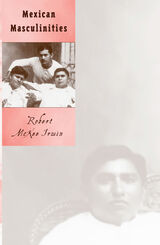 Mexican Masculinities
Robert McKee Irwin
University of Minnesota Press, 2003 A fascinating examination of masculinity in nineteenth- and twentieth-century Mexico The first of its kind and a powerful challenge to customary views of gender and sexuality in the life and literature of Mexico, this book traces literary representations of masculinity in Mexico from independence in 1810 to the 1960s, and shows how these intersect with the constructions of nation and nationality. The rhetoric of “Mexicanness” makes constant use of images of masculinity, though it does so in shifting and often contradictory ways. Robert McKee Irwin’s work follows these shifts from the male homosocial bonding that was central to notions of national integration in the nineteenth century, to questioning of gender norms stirred by science and scandals at the turn of the century, to the virulent reaction against gender chaos after the Mexican revolution, to the association of Mexicanness with machismo and homophobia in the literature of the 1940s and 1950s—even as male homosexuality was established as an integral part of national culture.As the first historical study of how masculinity and, particularly, homosexuality were understood in Mexico in the national era, this book not only provides “queer readings” of most major canonical texts of the period in question, but also uncovers a variety of unknown texts from queer Mexican history, including the 1906 novel Los 41, which reenacts the scandal of a turn-of-the-century transvestite ball that launched modern discussion of homosexuality in Mexico. It is a radical undermining of the simple hetero/homosexual and masculine/feminine oppositions that have for so long informed views of the country’s national character.
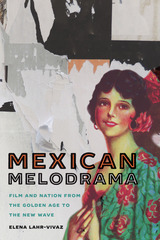 Mexican Melodrama: Film and Nation from the Golden Age to the New Wave
Elena Lahr-Vivaz
University of Arizona Press, 2016 In Mexican Melodrama, Elena Lahr-Vivaz explores the compelling ways that new-wave Mexican directors use the tropes and themes of Golden Age films to denounce the excesses of a nation characterized as a fragmented and fictitious construct. Analyzing big hits and quiet successes of both Golden Age and new-wave cinema, the author offers in each chapter a comparative reading of films from the two eras, considering, for instance, Amores perros (Love’s a Bitch, Alejandro González Iñárritu, 2000) alongside Nosotros los pobres (We the Poor, Ismael Rodríguez, 1947). Through such readings, Lahr-Vivaz examines how new-wave directors draw from a previous generation to produce meaning in the present.
Mexico’s Golden Age of film—the period from the 1930s to the 1950s—is considered “golden” due to both the prestige of the era’s stars and the critical and popular success of the films released. Golden Age directors often turned to the tropes of melodrama and allegory to offer spectators an image of an idealized Mexico and to spur the formation of a spectatorship united through shared tears and laughter. In contrast, Lahr-Vivaz demonstrates that new-wave directors of the 1990s and 2000s use the melodramatic mode to present a vision of fragmentation and to open a space for critical resistance. In so doing, new-wave directors highlight the limitations rather than the possibilities of a unified spectatorship, and point to the need for spectators to assume a critical stance in the face of the exigencies of the present.
Written in an accessible style, Mexican Melodrama offers a timely comparative analysis of critically acclaimed films that will serve as key referents in discussions of Mexican cinema for years to come.
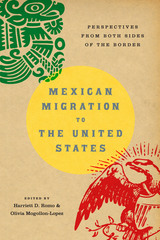 Mexican Migration to the United States: Perspectives From Both Sides of the Border
Edited by Harriett D. Romo and Olivia Mogollon-Lopez
University of Texas Press, 2016 Borderlands migration has been the subject of considerable study, but the authorship has usually reflected a north-of-the-border perspective only. Gathering a transnational group of prominent researchers, including leading Mexican scholars whose work is not readily available in the United States and academics from US universities, Mexican Migration to the United States brings together an array of often-overlooked viewpoints, reflecting the interconnectedness of immigration policy. This collection’s research, principally empirical, reveals significant aspects of labor markets, family life, and educational processes. Presenting recent data and accessible explanations of complex histories, the essays capture the evolving legal frameworks and economic implications of Mexico-US migrations at the national and municipal levels, as well as the experiences of receiving communities in the United States. The volume includes illuminating reports on populations ranging from undocumented young adults to elite Mexican women immigrants, health-care rights, Mexico’s incorporation of return migration, the impact of Deferred Action for Childhood Arrivals on higher education, and the experiences of young children returning to Mexican schools after living in the United States. Reflecting a multidisciplinary approach, the list of contributors includes anthropologists, demographers, economists, educators, policy analysts, and sociologists. Underscoring the fact that Mexican migration to the United States is unique and complex, this timely work exemplifies the cross-border collaboration crucial to the development of immigration policies that serve people in both countries.
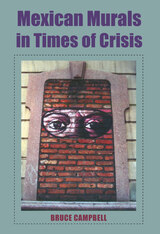 Mexican Murals in Times of Crisis
Bruce Campbell
University of Arizona Press, 2003 Murals have been an important medium of public expression in Mexico since the Mexican Revolution, and names such as Diego Rivera, David Alfaro Siqueiros, and José Clemente Orozco will forever be linked with this revolutionary art form. Many people, however, believe that Mexico's renowned mural tradition died with these famous practitioners, and today's mural artists labor in obscurity as many of their creations are destroyed through hostility or neglect.
This book traces the ongoing critical contributions of mural arts to public life in Mexico to show how postrevolutionary murals have been overshadowed both by the Mexican School and by the exclusionary nature of official public arts. By documenting a range of mural practices—from fixed-site murals to mantas (banner murals) to graffiti—Bruce Campbell evaluates the ways in which the practical and aesthetic components of revolutionary Mexican muralism have been appropriated and redeployed within the context of Mexico's ongoing economic and political crisis. Four dozen photographs illustrate the text. Blending ethnography, political science, and sociology with art history, Campbell traces the emergence of modern Mexican mural art as a composite of aesthetic, discursive, and performative elements through which collective interests and identities are shaped.
He focuses on mural activists engaged combatively with the state—in barrios, unions, and street protests—to show that mural arts that are neither connected to the elite art world nor supported by the government have made significant contributions to Mexican culture. Campbell brings all previous studies of Mexican muralism up to date by revealing the wealth of art that has flourished in the shadows of official recognition. His work shows that interpretations by art historians preoccupied with contemporary high art have been incomplete—and that a rich mural tradition still survives, and thrives, in Mexico.
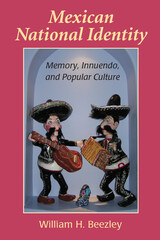 Mexican National Identity: Memory, Innuendo, and Popular Culture
William H. Beezley
University of Arizona Press, 2008 In this enlightening book, the well-known historian William Beezley contends that a Mexican national identity was forged during the nineteenth century not by a self-anointed elite but rather by a disparate mix of ordinary people and everyday events. In examining independence festivals, children’s games, annual almanacs, and the performances of itinerant puppet theaters, Beezley argues that these seemingly unrelated and commonplace occurrences—not the far more self-conscious and organized efforts of politicians, teachers, and others—created a far-reaching sense of a new nation. In the century that followed Mexico’s independence from Spain in 1821, Beezley maintains, sentiments of nationality were promulgated by people who were concerned not with the promotion of nationalism but with something far more immediate—the need to earn a living. These peddlers, vendors, actors, artisans, writers, publishers, and puppeteers sought widespread popular appeal so that they could earn money. According to Beezley, they constantly refined their performances, as well as the symbols and images they employed, in order to secure larger revenues. Gradually they discovered the stories, acts, and products that attracted the largest numbers of paying customers. As Beezley convincingly asserts, out of “what sold to the masses” a collective national identity slowly emerged. Mexican National Identity makes an important contribution to the growing body of literature that explores the influences of popular culture on issues of national identity. By looking at identity as it was fashioned “in the streets,” it opens new avenues for exploring identity formation more generally, not just in Mexico and Latin American countries but in every nation. Check out the New Books in History Interview with Bill Beezley!
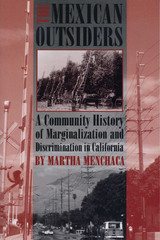 The Mexican Outsiders: A Community History of Marginalization and Discrimination in California
By Martha Menchaca
University of Texas Press, 1995 People of Mexican descent and Anglo Americans have lived together in the U.S. Southwest for over a hundred years, yet relations between them remain strained, as shown by recent controversies over social services for undocumented aliens in California. In this study, covering the Spanish colonial period to the present day, Martha Menchaca delves deeply into interethnic relations in Santa Paula, California, to document how the residential, social, and school segregation of Mexican-origin people became institutionalized in a representative California town. Menchaca lived in Santa Paula during the 1980s, and interviews with residents add a vivid human dimension to her book. She argues that social segregation in Santa Paula has evolved into a system of social apartness—that is, a cultural system controlled by Anglo Americans that designates the proper times and places where Mexican-origin people can socially interact with Anglos. This first historical ethnographic case study of a Mexican-origin community will be important reading across a spectrum of disciplines, including anthropology, sociology, race and ethnicity, Latino studies, and American culture.
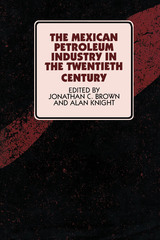 The Mexican Petroleum Industry in the Twentieth Century
Edited by Jonathan C. Brown and Alan Knight
University of Texas Press, 1992 Mexico's petroleum industry has come to symbolize the very sovereignty of the nation itself. Politicians criticize Pemex, the national oil company, at their peril, and President Salinas de Gortari has made clear that the free trade negotiations between Mexico and the United States will not affect Pemex's basic status as a public enterprise. How and why did the petroleum industry gain such prominence and, some might say, immunity within Mexico's political economy? The Mexican Petroleum Industry in the Twentieth Century, edited by Jonathan C. Brown and Alan Knight, seeks to explain the impact of the oil sector on the nation's economic, political, and social development. The book is a multinational effort—one author is Australian, two British, three North American, and five Mexican. Each contributing scholar has researched and written extensively about Mexico and its oil industry.
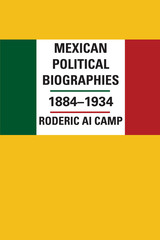 Mexican Political Biographies, 1884–1934
By Roderic Ai Camp
University of Texas Press, 1991 Here is an authoritative reference work that makes biographies of prominent Mexican national politicians from the period 1884–1934 available in English. Like the author's biographical directory for the years 1935–2009, it draws on many years of research in Mexico and the United States and seeks not only to provide accurate biographical information about each entry but also, where possible and appropriate, to connect these politicians to more recent leadership generations. Thus, Mexican Political Biographies, 1884-1934 not only is a useful historical source but also provides additional information on the family backgrounds of many contemporary figures. The work includes those figures who have held specific posts at the national level or who have served as state governors. Each biographical entry contains the following information: date of birth, birthplace, education, elective political office, political party positions, appointive governmental posts at all levels, group activities, nongovernmental positions and professions, relatives, mentors and important friends, military experience, unusual career activities, and published biographical sources. Another unique feature of the directory is appendixes with complete lists of the names and dates of cabinet members, supreme court justices, senators, deputies, selected ambassadors, and party leaders.
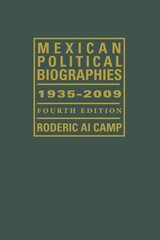 Mexican Political Biographies, 1935-2009: Fourth Edition
By Roderic Ai Camp
University of Texas Press, 2011 This fourth edition of Roderic Camp's highly respected Mexican Political Biographies is an updated comprehensive biographical directory of leading state and national politicians in Mexico, covering the years 1935–2009. The original edition, published in 1976, was the first and only comprehensive biographical work on contemporary political figures in any language and served as the prototype for the Mexican government's brief foray into its own official biographical directory. The Mexican Supreme Court has cited every biography of justices in the third edition as the basis of its biographies in the late 1980s. With updates of the existing biographies and appendices, plus almost 1,000 additional biographies, this fourth edition now features close to 3,000 entries and serves as a unique resource list of the chronological occupants of all leading national political posts. The need for such information has become even more pronounced since Mexico's political transformation from a semi-authoritarian to a democratic model. This latest edition allows readers access to information about Mexican politicians into the new century, and like its earlier versions, will be a valuable tool for government officials, journalists, historians, social scientists, the business community, and students. Finally, it includes a detailed bibliographic essay that identifies and explains the significance of biographical sources and has been enhanced by numerous up-to-date Internet sources. An added convenience is an accompanying CD that allows readers to search the biographies and appendices, enhancing the longevity, usefulness, and uniqueness of this edition.
The Mexican Republic: The First Decade, 1823-1832
Stanley C. Green
University of Pittsburgh Press, 1987 Green offers a colorful acccount of the first decade of Mexican independence from Spain. He views the failed attempt to establish a strong republic and the subsequent civil war that plagued the young nation. From this first decade, two polarized factions emerged, one federalist and populist, the other attempted to keep much of the old order of authroitarianism and church power established under colonialism. The were to be called the Liberals and the Conservatives, who would vie for power over the next century.
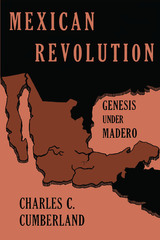 Mexican Revolution: Genesis under Madero
By Charles C. Cumberland
University of Texas Press, 1974 The Mexican Revolution is one of the most important and ambitious sociopolitical experiments in modem times. The Revolution developed in three distinct stages: the overthrow of the Díaz dictatorship, the subsequent era of bloodshed and devastation during which radical ideas were written into the constitution, and the much longer span during which the ideas have been put into practice. The present volume covers the first stage of this development. Idealistic, patriotic hacendado Francisco I. Madero became the catalyst of the Revolution. All peaceful means having failed to secure democratic elections, Madero reluctantly undertook to mold the discontented factions into an effective force for insurrection. But victory brought disunity. Opposition to the Díaz regime, not a positive desire for reform, had held the revolutionaries together. Díaz deposed, Madero could not muster sufficient support to realize more than a fraction of his objectives, and he himself fell victim to counterrevolution.
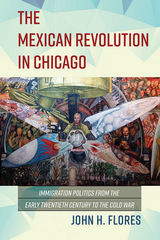 The Mexican Revolution in Chicago: Immigration Politics from the Early Twentieth Century to the Cold War
John H Flores
University of Illinois Press, 2018 Few realize that long before the political activism of the 1960s, there existed a broad social movement in the United States spearheaded by a generation of Mexican immigrants inspired by the revolution in their homeland. Many revolutionaries eschewed U.S. citizenship and have thus far been lost to history, though they have much to teach us about the increasingly international world of today. John H. Flores follows this revolutionary generation of Mexican immigrants and the transnational movements they created in the United States. Through a careful, detailed study of Chicagoland, the area in and around Chicago, Flores examines how competing immigrant organizations raised funds, joined labor unions and churches, engaged the Spanish-language media, and appealed in their own ways to the dignity and unity of other Mexicans. Painting portraits of liberals and radicals, who drew support from the Mexican government, and conservatives, who found a homegrown American ally in the Roman Catholic Church, Flores recovers a complex and little known political world shaped by events south of the U.S border.
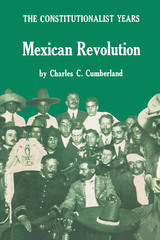 Mexican Revolution: The Constitutionalist Years
By Charles C. Cumberland
University of Texas Press, 1972 The years 1913-1920 were the most critical years of the Mexican revolution. This study of the period, a sequel to Cumberland's Mexican Revolution: Genesis under Madero (University of Texas Press, 1952), traces Mexico's course through the anguish of civil war to the establishment of a tenuous new government, the codification of revolutionary aspirations in a remarkable constitution, and the emergence of an activist leadership determined to propel Mexico into the select company of developed nations. The narrative begins with Huerta's overthrow of Madero in 1913 and the rise of Carranza's Constitutionalist counterchallenge. It concludes with a summary of Carranza's stormy term as constitutional president climaxed by his ouster and overthrow in a revolt spearheaded by Alvaro Obregón. Professor Cumberland has based his study on a wide range of Mexican and U.S. primary sources as well as pertinent secondary studies. He has utilized much new material and has brought to it a mature and sophisticated analysis; the result is a major contribution to the understanding of one of the twentieth century's most significant revolutionary movements.
 Mexican Soundings: Essays in Honour of David A. Brading
Edited by Susan Deans-Smith and Eric Van Young
University of London Press, 2007 David Brading is one of the foremost historians of Latin America in the United Kingdom. The essays in this volume convey the enduring nature of many of the questions raised by his work. They reflect the wide range of his interests: from Mexican Baroque and post-Tridentine Catholicism to studies of the dynamics of state building in nineteenth- century Mexico and of the problem of Mexican national identity. The contributions represent a wide chronological spread from the late seventeenth century to the twentieth century, as well as geographical diversity (Mexico City, Queretaro, and Puebla). Part I comprises an autobiographical essay by David Brading, an appreciation of him by Enrique Florescano, and an historiographical assessment of Brading's work by Eric Van Young. Part II gathers together six essays by former students (Susan Deans-Smith and Ellen Gunnarsdottir) and colleagues (Brian Hamnett, Marta Garcia Urgarte, Guy Thomson, and Alan Knight).
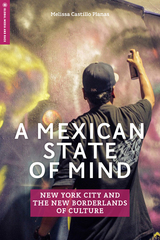 A Mexican State of Mind: New York City and the New Borderlands of Culture
Melissa Castillo-Garsow
Rutgers University Press, 2020 A Mexican State of Mind: New York City and the New Borderlands of Culture explores the cultural and creative lives of the largely young undocumented Mexican population in New York City since September 11, 2001. Inspired by a dialogue between the landmark works of Paul Gilroy and Gloria Anzaldúa, it develops a new analytic framework, the Atlantic Borderlands, which bridges Mexican diasporic experiences in New York City and the black diaspora, not as a comparison but in recognition that colonialism, interracial and interethnic contact through trade, migration, and slavery are connected via capitalist economies and technological developments. This book is based on ten years of fieldwork in New York City, with members of a vibrant community of young Mexican migrants who coexist and interact with people from all over the world. It focuses on youth culture including hip hop, graffiti, muralism, labor activism, arts entrepreneurship and collective making.
 The Mexican Transpacific: Nikkei Writing, Visual Arts, and Performance
Ignacio López-Calvo
Vanderbilt University Press, 2022 The Mexican Transpacific considers the influence of a Japanese ethnic background or lack thereof in the cultural production of several twentieth- and twenty-first-century Mexican authors, performers, and visual artists. Despite Japanese Mexicans’ unquestionable influence on Mexico’s history and culture and the historical studies recently published on this Nikkei community, the study of its cultural production and therefore its self-definition has been, for the most part, overlooked.
This book, a continuation of author Ignacio López-Calvo’s previous research on cultural production by Latin American authors of Asian ancestry, focuses mostly on literature, theater, and visual arts produced by Japanese immigrants in Mexico and their descendants, rather than on the Japanese community as a mere object of study. With this interdisciplinary project, López-Calvo aims to bring to the fore this silenced community’s voice and agency to historicize its own experience.
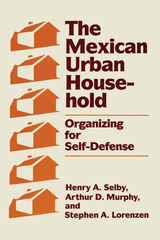 The Mexican Urban Household: Organizing for Self-Defense
By Henry A. Selby, Arthur D. Murphy, and Stephen A. Lorenzen
University of Texas Press, 1990 The sufferings of “ordinary” people under harsh economic conditions can eventually lead to the fall of governments. Given this fact, it becomes important to know how “ordinary” people live—what privations they suffer and what strategies they use to survive in times of economic crisis. The Mexican Urban Household provides this information for Mexico near the end of the twentieth century. Mexico is now a predominantly urban nation, and this study is the definitive work on the strategies of self-defense of its urban households. It is based on surveys of nearly 10,000 households, conducted during twenty years of field work in five very different cities, with the help of a staff of more than twenty Mexican social scientists, engineers, architects, and social workers. Far from being a compilation of undigested statistics, however, The Mexican Urban Household uses its rich data to vividly reveal how Mexican families use their every resource to defend themselves against a political and economic system that overwhelms and exploits them. It describes how families band together, sometimes with three generations in one small house, to minimize expenses and pool resources. It explores the limited range of available jobs, from secure but scarce bureaucratic positions to more common and less reliable jobs in blue-collar industries and the informal economy. And, most important, it traces the high cost to families, particularly to women, of the endless struggle to make ends meet. These important findings outline the dimensions of the economic crisis for ordinary Mexicans. It will be crucial reading not only for everyone interested in the future of Mexico but also for students of development throughout the Third World.
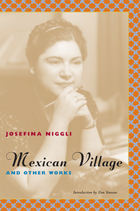 Mexican Village and Other Works
Josefina Niggli
Northwestern University Press, 2007 Born in Monterrey, Nuevo León, Mexico in 1910, Josefina María Niggli was one of the first Latina writers to have her work published in the United States—and thus one of the first to introduce American audiences to the culture and people flourishing along the U.S.–Mexico border. Well ahead of what is now called Chicano literature, her writings—spanning a broad range of genres, subjects, and styles—offer an insider's view of the everyday lives little known or noted outside of their native milieu. In Niggli's plays, for instance, these often invisible working class Mexicans were literally elevated to the public stage, their hidden reality given expression.
A long-overdue gathering of Niggli's work, this volume showcases the writer's remarkable literary versatility, as well as the groundbreaking nature of her writing, which in many ways established a blueprint for future generations of writers and readers of Chicano literature. This collection includes Niggli's most famous and influential work, Mexican Village—a literary chronicle of Hidalgo, Mexico, which explores the distinct nature and tensions of Mexican life—along with her novel Step Down, Elder Brother, and five of her most well-known plays.
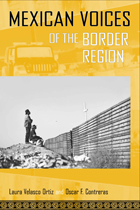 Mexican Voices of the Border Region: Mexicans and Mexican Americans Speak about Living along the Wall
Authored by Laura Velasco Ortiz and Oscar F. Contreras with translations by Sandra del Castillo
Temple University Press, 2011 Every day, 40,000 commuters cross the U.S. Mexico border at Tijuana San Diego to go to work. Untold numbers cross illegally. Since NAFTA was signed into law, the border has become a greater obstacle for people moving between countries. Transnational powers have exerted greater control over the flow of goods, services, information, and people.
Mexican Voices of the Border Region examines the flow of people, commercial traffic, and the development of relationships across this border. Through first-person narratives, Laura Velasco Ortiz and Oscar F. Contreras show that since NAFTA, Tijuana has become a dynamic and significant place for both nations in terms of jobs and residents. The authors emphasize that the border itself has different meanings whether one crosses it frequently or not at all. The interviews probe into matters of race, class, gender, ethnicity, place, violence, and political economy as well as the individual's sense of agency.
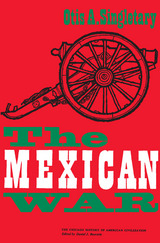 The Mexican War
Otis A. Singletary
University of Chicago Press, 1960 The Mexican War has long been overshadowed in the public imagination by that most popular of all American wars, the Civil War. And it has been swept under the carpet of national conscience as, at worst, a calculated land grab from a neighbor too weak to defend itself.
Otis Singletary's concise, dramatic account of the war that won the Southwest and California for the United States is designed to evoke in modern readers a fresh appreciation of one of the most colorful but neglected episodes in American military affairs—and certainly one of the most significant. Victory in this "military exercise" turned our attention to the Far West, made possible the Gold Rush of '49, and brought vast new territories and new peoples into the Union—altering the face of the nation and greatly influencing its future course.
Mr. Singletary treats the military, political, economic, and diplomatic aspects of the war. He focuses on the ways in which the Mexican War exemplified the dynamic spirit of Manifest Destiny and was a microcosm of peculiarly American—and peculiarly democratic—problems of waging war.
"All in all, this is the best short account of the Mexican War yet written."—T. Harry Williams, The Journal of Modern History
 Mexican Waves: Radio Broadcasting Along Mexico's Northern Border, 1930–1950
Sonia Robles
University of Arizona Press, 2019 Mexican Waves is the fascinating history of how borderlands radio stations shaped the identity of an entire region as they addressed the needs of the local population and fluidly reached across borders to the United States. In so doing, radio stations created a new market of borderlands consumers and worked both within and outside the constraints of Mexican and U.S. laws.
Historian Sonia Robles examines the transnational business practices of Mexican radio entrepreneurs between the Golden Age of radio and the early years of television history. Intersecting Mexican history and diaspora studies with communications studies, this book explains how Mexican radio entrepreneurs targeted the Mexican population in the United States decades before U.S. advertising agencies realized the value of the Spanish-language market.
Robles’s robust transnational research weaves together histories of technology, performance, entrepreneurship, and business into a single story. Examining the programming of northern Mexican commercial radio stations, the book shows how radio stations from Tijuana to Matamoros courted Spanish-language listeners in the U.S. Southwest and local Mexican audiences between 1930 and 1950. Robles deftly demonstrates Mexico’s role in creating the borderlands, adding texture and depth to the story.
Scholars and students of radio, Spanish-language media in the United States, communication studies, Mexican history, and border studies will see how Mexican radio shaped the region’s development and how transnational listening communities used broadcast media’s unique programming to carve out a place for themselves as consumers and citizens of Mexico and the United States.
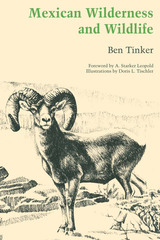 Mexican Wilderness and Wildlife
By Ben Tinker
University of Texas Press, 1978 From the mountainous area bordering Arizona and New Mexico, the western range of the Sierra Madres reaches south into Mexico to the state of Jalisco. The eastern range stretches from the Texas border down to Morelia and the Valley of Mexico. Ben Tinker spent years exploring this rugged wilderness and the vast deserts of Sonora and Baja California. Mexican Wilderness and Wildlife condenses a lifetime of outdoor lore and learning. Tinker provides detailed life sketches of Mexico's Desert Bighorn Sheep, Pronghorn Antelope, Mule Deer, Whitetail Deer, Peccary, Grizzly and Black Bears, Wild Turkey, Jaguar, Mountain Lion, Timber Wolf, Coyote, and Bobcat. Each is illustrated by wildlife artist Doris Tischler, and Tinker describes their habitats, habits, reproduction, and peculiarities. Information is supplied on the physical measurements of several species of major wildlife. Tinker's observations are laced with anecdotes about his experiences in Mexico's remote backcountry—encounters with bandits, survival in the desert mountains, and the chance discovery of archaeological ruins. The book describes the terrain and flora of the four life zones inhabited by major game and predatory animals. The section on desert water is a fascinating account of how animals thrive among cacti, thorn trees, and creosote bush remote from streams and waterholes. There is also a brief discussion of conservation efforts in Mexico, chapters on trout fishing in the Sierra Madre Occidental and Baja California, and a guide to big game habitats. This volume will be valuable to hunters, conservationists, naturalists, and others interested in the wilderness and wildlife of Mexico. Ben Tinker collected much of the material for this book during the years he roamed northern Mexico as Federal Game Guardian. Though an American, Tinker had long been familiar with Mexican wildlife through his Sonoran ranching operation and was known for his interest in conservation when he was appointed by Alvaro Obregón in 1922.
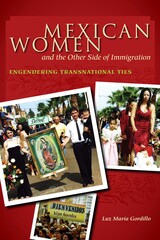 Mexican Women and the Other Side of Immigration: Engendering Transnational Ties
By Luz María Gordillo
University of Texas Press, 2010 Weaving narratives with gendered analysis and historiography of Mexicans in the Midwest, Mexican Women and the Other Side of Immigration examines the unique transnational community created between San Ignacio Cerro Gordo, Jalisco, and Detroit, Michigan, in the last three decades of the twentieth century, asserting that both the community of origin and the receiving community are integral to an immigrant's everyday life, though the manifestations of this are rife with contradictions. Exploring the challenges faced by this population since the inception of the Bracero Program in 1942 in constantly re-creating, adapting, accommodating, shaping, and creating new meanings of their environments, Luz María Gordillo emphasizes the gender-specific aspects of these situations. While other studies of Mexican transnational identity focus on social institutions, Gordillo's work introduces the concept of transnational sexualities, particularly the social construction of working-class sexuality. Her findings indicate that many female San Ignacians shattered stereotypes, transgressing traditionally male roles while their husbands lived abroad. When the women themselves immigrated as well, these transgressions facilitated their adaptation in Detroit. Placed within the larger context of globalization, Mexican Women and the Other Side of Immigration is a timely excavation of oral histories, archival documents, and the remnants of three decades of memory.
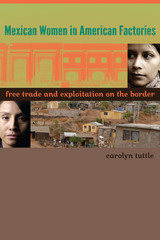 Mexican Women in American Factories: Free Trade and Exploitation on the Border
By Carolyn Tuttle
University of Texas Press, 2012 Prior to the millennium, economists and policy makers argued that free trade between the United States and Mexico would benefit both Americans and Mexicans. They believed that NAFTA would be a “win-win” proposition that would offer U.S. companies new markets for their products and Mexicans the hope of living in a more developed country with the modern conveniences of wealthier nations. Blending rigorous economic and statistical analysis with concern for the people affected, Mexican Women in American Factories offers the first assessment of whether NAFTA has fulfilled these expectations by examining its socioeconomic impact on workers in a Mexican border town. Carolyn Tuttle led a group that interviewed 620 women maquila workers in Nogales, Sonora, Mexico. The responses from this representative sample refute many of the hopeful predictions made by scholars before NAFTA and reveal instead that little has improved for maquila workers. The women’s stories make it plain that free trade has created more low-paying jobs in sweatshops where workers are exploited. Families of maquila workers live in one- or two-room houses with no running water, no drainage, and no heat. The multinational companies who operate the maquilas consistently break Mexican labor laws by requiring women to work more than nine hours a day, six days a week, without medical benefits, while the minimum wage they pay workers is insufficient to feed their families. These findings will make a crucial contribution to debates over free trade, CAFTA-DR, and the impact of globalization.
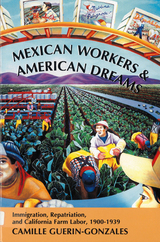 Mexican Workers and the American Dream: Immigration, Repatriation, and California Farm Labor, 1900-1939
Guerin-Gonzales, Camille
Rutgers University Press, 1994 "Guerin-Gonzales's special contribution is the link she explores between immigrant experience and the American dream. The towering irony her fine book reveals is how an ideology of promise for others was for the Mexican migrants the justification for their exploitation and, when the Great Drepression struck, for expelling many of them from the country."--David Brody, University of California, Davis "Based on exhaustive research in U.S. and Mexican archives, this study offers a richly-textured history of Mexican immigrants in rural California. A work of exceptional breadth, especially with regard to repatriation, [it] is a pivotal contribution to Chicano historiography and immigration studies."--Vicki L. Ruiz, Andrew W. Mellon All-Claremont Professor in the Humanities, The Claremont Graduate School
In the first forty years of this century, over one million Mexican immigrants moved to the United States, attracted by the prospect of farm work in California. They became workers in industrial agriculture --barely recognized, never respected, and poorly paid. Native white American workers did not resent the Mexicans during prosperous times, when everyone who wanted to work could do so. But during the Great Depression, native workers began to realize that many of the Mexican workers were here to stay. Native workers, blaming their unemployment on the immigrants, joined with government officials to demand that Mexican workers and their families return to Mexico. During the 1930s, the federal government and county relief agencies cooperated in a nasty repatriation program, forcing half a million Mexicans living in the U.S. to return to Mexico.
Camille Guerin-Gonzales tells the story of their migration, their years here, and of the repatriation program--one of the largest mass removal operations ever sanctioned by the U.S. government.She documents both their efforts to resist and the overpowering forces that worked against them.
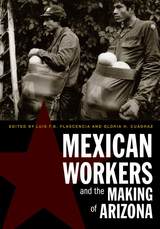 Mexican Workers and the Making of Arizona
Edited by Luis F. B. Plascencia and Gloria H. Cuádraz
University of Arizona Press, 2018 On any given day in Arizona, thousands of Mexican-descent workers labor to make living in urban and rural areas possible. The majority of such workers are largely invisible. Their work as caretakers of children and the elderly, dishwashers or cooks in restaurants, and hotel housekeeping staff, among other roles, remains in the shadows of an economy dependent on their labor.
Mexican Workers and the Making of Arizona centers on the production of an elastic supply of labor, revealing how this long-standing approach to the building of Arizona has obscured important power relations, including the state’s favorable treatment of corporations vis-à-vis workers. Building on recent scholarship about Chicanas/os and others, the volume insightfully describes how U.S. industries such as railroads, mining, and agriculture have fostered the recruitment of Mexican labor, thus ensuring the presence of a surplus labor pool that expands and contracts to accommodate production and profit goals.
The volume’s contributors delve into examples of migration and settlement in the Salt River Valley; the mobilization and immobilization of cotton workers in the 1920s; miners and their challenge to a dual-wage system in Miami, Arizona; Mexican American women workers in midcentury Phoenix; the 1980s Morenci copper miners’ strike and Chicana mobilization; Arizona’s industrial and agribusiness demands for Mexican contract labor; and the labor rights violations of construction workers today.
Mexican Workers and the Making of Arizona fills an important gap in our understanding of Mexicans and Mexican Americans in the Southwest by turning the scholarly gaze to Arizona, which has had a long-standing impact on national policy and politics.
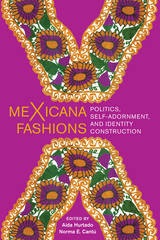 meXicana Fashions: Politics, Self-Adornment, and Identity Construction
Edited by Aída Hurtado and Norma E. Cantú
University of Texas Press, 2020 2020 Second Place, Best Nonfiction Multi Author, International Latino Book Awards Collecting the perspectives of scholars who reflect on their own relationships to particular garments, analyze the politics of dress, and examine the role of consumerism and entrepreneurialism in the production of creating and selling a style, meXicana Fashions examines and searches for meaning in these visible, performative aspects of identity. Focusing primarily on Chicanas but also considering trends connected to other Latin American communities, the authors highlight specific constituencies that are defined by region (“Tejana style,” “L.A. style”), age group (“homie,” “chola”), and social class (marked by haute couture labels such as Carolina Herrera and Oscar de la Renta). The essays acknowledge the complex layers of these styles, which are not mutually exclusive but instead reflect a range of intersections in occupation, origin, personality, sexuality, and fads. Other elements include urban indigenous fashion shows, the shifting quinceañera market, “walking altars” on the Days of the Dead, plus-size clothing, huipiles in the workplace, and dressing in drag. Together, these chapters illuminate the full array of messages woven into a vibrant social fabric.
 meXicana Roots and Routes: Listening to People, Places, and Pasts
Edited by Vanessa Fonseca-Chávez and Anita Huízar-Hernández
University of Arizona Press, 2025 Community voices are often an underrepresented aspect of our historical and cultural knowledge of the U.S. Southwest.
In this collection, established and emerging scholars draw upon their rootedness in the U.S. Southwest and U.S.-Mexico borderlands. The meXicana contributors use personal and scholarly inquiry to discuss what it means to cultivate spaces of belonging, navigate language policies, and explore and excavate silences in various spaces, among other important themes.
From the recruitment of Latinas for the U.S. Benito Juárez Squadron in World War II, to the early twentieth-century development of bilingual education in Arizona, to new and insightful analyses of Bracero Program participants and their families, the book details little-known oral histories and archival material to present a rich account of lives along the border with emphasis on women and the working class.
As the inaugural publication of the Arizona Crossroads series, readers will find Arizona featured as a central node of borderlands roots and routes. Each section of the book intentionally centers Arizona within broader comparative and cross-state dialogues, alongside chapters that reflect regional concerns in other southwestern states, including Texas, California, Colorado, and New Mexico. Throughout, this volume highlights the ways in which personal experience, community building, and scholarly perspectives can provide a powerful space for community voices.
Contributors
Vanessa Fonseca-Chávez
Lillian Gorman
Gloria Holguín Cuádraz
Anita Huízar-Hernández
Christine Marin
Valerie A. Martínez
Alina R. Méndez
Karen R. Roybal
Yvette J. Saavedra
Liliana Toledo-Guzmán
Andrea Tovar
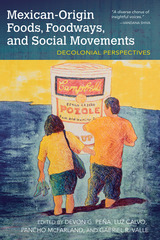 Mexican-Origin Foods, Foodways, and Social Movements: Decolonial Perspectives
Devon Peña
University of Arkansas Press, 2017 Winner, 2018 ASFS (Association for the Study of Food and Society) Book Award, Edited Volume
This collection of new essays offers groundbreaking perspectives on the ways that food and foodways serve as an element of decolonization in Mexican-origin communities.
The writers here take us from multigenerational acequia farmers, who trace their ancestry to Indigenous families in place well before the Oñate Entrada of 1598, to tomorrow’s transborder travelers who will be negotiating entry into the United States. Throughout, we witness the shifting mosaic of Mexican-origin foods and foodways in the fields, gardens, and kitchen tables from Chiapas to Alaska.
Global food systems are also considered from a critical agroecological perspective, including the ways colonialism affects native biocultural diversity, ecosystem resilience, and equality across species, human groups, and generations.
Mexican-Origin Foods, Foodways, and Social Movements is a major contribution to the understanding of the ways that Mexican-origin peoples have resisted and transformed food systems. It will animate scholarship on global food studies for years to come.
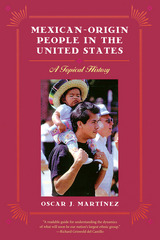 Mexican-Origin People in the United States: A Topical History
Oscar J. Martínez
University of Arizona Press, 2001 The history of the United States in the twentieth century is inextricably entwined with that of people of Mexican origin. The twenty million Mexicans and Mexican Americans living in the U.S. today are predominantly a product of post-1900 growth, and their numbers give them an increasingly meaningful voice in the political process. Oscar J. Martínez here recounts the struggle of a people who have scraped and grappled to make a place for themselves in the American mainstream.
Focusing on social, economic, and political change during the twentieth century—particularly in the American West—Martínez provides a survey of long-term trends among Mexican Americans and shows that many of the difficult conditions they have experienced have changed decidedly for the better. Organized thematically, the book addresses population dynamics, immigration, interaction with the mainstream, assimilation into the labor force, and growth of the Mexican American middle class. Martínez then examines the various forms by which people of Mexican descent have expressed themselves politically: becoming involved in community organizations, participating as voters, and standing for elective office. Finally he summarizes salient historical points and offers reflections on issues of future significance. Where appropriate, he considers the unique circumstances that distinguish the experiences of Mexican Americans from those of other ethnic groups.
By the year 2000, significant numbers of people of Mexican origin had penetrated the middle class and had achieved unprecedented levels of power and influence in American society; at the same time, many problems remain unsolved, and the masses face new challenges created by the increasingly globalized U.S. economy. This concise overview of Mexican-origin people puts these successes and challenges in perspective and defines their contribution to the shaping of modern America.
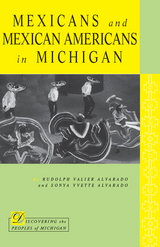 Mexicans and Mexican Americans in Michigan
Rudolph V. Alvarado
Michigan State University Press, 2003 Unlike most of their immigrant counterparts, up until the turn of the twentieth century most Mexicans and Mexican Americans did not settle permanently in Michigan but were seasonal laborers, returning to homes in the southwestern United States or Mexico in the winter. Nevertheless, during the past century the number of Mexicans and Mexican Americans settling in Michigan has increased dramatically, and today Michigan is undergoing its third “great wave” of Mexican immigration. Though many Mexican and Mexican American immigrants still come to Michigan seeking work on farms, many others now come seeking work in manufacturing and construction, college educations, opportunities to start businesses, and to join family members already established in the state. In Mexicans and Mexican Americans in Michigan, Rudolph Valier Alvarado and Sonya Yvette Alvarado examine the settlement trends and growth of this population, as well as the cultural and social impact that the state and these immigrants have had on one another. The story of Mexicans and Mexican Americans in Michigan is one of a steadily increasing presence and influence that well illustrates how peoples and places combine to create traditions and institutions.
Mexicans in California: Transformations and Challenges
Edited by Ramon A. Gutierrez and Patricia Zavella
University of Illinois Press, 2008 Numbering over a third of California's population and thirteen percent of the U.S. population, people of Mexican ancestry represent a hugely complex group with a long history in the country. Contributors explore a broad range of issues regarding California's ethnic Mexican population, including their concentration among the working poor and as day laborers; their participation in various sectors of the educational system; social problems such as domestic violence; their contributions to the arts, especially music; media stereotyping; and political alliances and alignments. Contributors are Brenda D. Arellano, Leo R. Chavez, Yvette G. Flores, Ramón A. Gutiérrez, Aída Hurtado, Olga Nájera-Ramírez, Chon A. Noriega, Manuel Pastor Jr., Armida Ornelas, Russell W. Rumberger, Daniel Solórzano, Enriqueta Valdez Curiel, and Abel Valenzuela Jr.
 Mexicans in the Making of America
Neil Foley
Harvard University Press, 2014 A Choice Outstanding Academic Title of the Year
According to census projections, by 2050 nearly one in three U.S. residents will be Latino, and the overwhelming majority of these will be of Mexican descent. This dramatic demographic shift is reshaping politics, culture, and fundamental ideas about American identity. Neil Foley, a leading Mexican American historian, offers a sweeping view of the evolution of Mexican America, from a colonial outpost on Mexico’s northern frontier to a twenty-first-century people integral to the nation they have helped build.
“Compelling…Readers of all political persuasions will find Foley’s intensively researched, well-documented scholarly work an instructive, thoroughly accessible guide to the ramifications of immigration policy.”
—Publishers Weekly
“For Americans long accustomed to understanding the country’s development as an east-to-west phenomenon, Foley’s singular service is to urge us to tilt the map south-to-north and to comprehend conditions as they have been for some time and will likely be for the foreseeable future…A timely look at and appreciation of a fast-growing demographic destined to play an increasingly important role in our history.”
—Kirkus Reviews
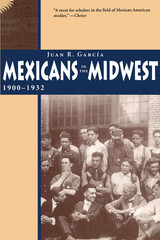 Mexicans in the Midwest, 1900-1932
Juan R. García
University of Arizona Press, 1996 Early in this century, a few Mexican migrants began streaming northward into the Midwest, but by 1914--in response to the war in Europe and a booming U.S. economy--the stream had become a flood. Barely a generation later, this so-called Immigrant Generation of Mexicans was displaced and returned to the U.S. Southwest or to Mexico. Drawing on both published works and archival materials, this new study considers the many factors that affected the process of immigration as well as the development of communities in the region. These include the internal forces of religion, ethnic identity, and a sense of nationalism, as well as external influences such as economic factors, discrimination, and the vagaries of U.S.-Mexico relations.
Here is a book that persuasively challenges many prevailing assumptions about Mexican people and the communities they established in the Midwest. The author notes the commonalities and differences between Mexicans in that region and their compadres who settled elsewhere. He further demonstrates that although Mexicans in the Midwest maintained a strong sense of cultural identity, they were quick to adopt the consumer culture and other elements of U.S. life that met their needs.
Focusing on a people, place, and time rarely covered before now, this wide-ranging work will be welcomed by scholars and students of history, sociology, and Chicano studies. General readers interested in ethnic issues and the multicultural fabric of American society will find here a window to the past as well as new perspectives for understanding the present and the future.
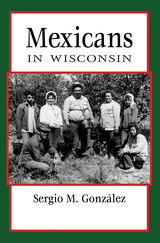 Mexicans in Wisconsin
Sergio González
Wisconsin Historical Society Press, 2017 From agricultural and factory workers to renowned writers and musicians, the Mexican immigrants who have made their homes in Wisconsin over the past century have become a significant and diverse part of this state’s cultural and economic history. Coming from a variety of educational and professional backgrounds, the earliest Mexican immigrants traveled north in search of better economic opportunities and relief from the violence and economic turmoil of the Mexican Revolution. They found work in tanneries and foundries, and on beet farms where they replaced earlier European immigrant workers who had moved on to family farms. As Mexican immigration has grown to the present day, these families have become integral members of Wisconsin communities, building businesses, support systems, and religious institutions. But their experience has also been riddled with challenges, as they have fought for adequate working conditions, access to education, and acceptance amid widespread prejudice. In this concise history, learn the fascinating stories of this vibrant and resilient immigrant population: from the Tejano migrant workers who traveled north seasonally to work in the state’s cucumber fields, to the determined labor movement led by Jesus Salas, to the young activists of the Chicano Movement, and beyond.
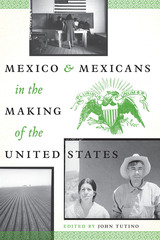 Mexico and Mexicans in the Making of the United States
Edited by John Tutino
University of Texas Press, 2012 Mexico and Mexicans have been involved in every aspect of making the United States from colonial times until the present. Yet our shared history is a largely untold story, eclipsed by headlines about illegal immigration and the drug war. Placing Mexicans and Mexico in the center of American history, this volume elucidates how economic, social, and cultural legacies grounded in colonial New Spain shaped both Mexico and the United States, as well as how Mexican Americans have constructively participated in North American ways of production, politics, social relations, and cultural understandings. Combining historical, sociological, and cultural perspectives, the contributors to this volume explore the following topics: the Hispanic foundations of North American capitalism; indigenous peoples’ actions and adaptations to living between Mexico and the United States; U.S. literary constructions of a Mexican “other” during the U.S.-Mexican War and the Civil War; the Mexican cotton trade, which helped sustain the Confederacy during the Civil War; the transformation of the Arizona borderlands from a multiethnic Mexican frontier into an industrializing place of “whites” and “Mexicans”; the early-twentieth-century roles of indigenous Mexicans in organizing to demand rights for all workers; the rise of Mexican Americans to claim middle-class lives during and after World War II; and the persistence of a Mexican tradition of racial/ethnic mixing—mestizaje—as an alternative to the racial polarities so long at the center of American life.
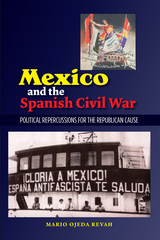 Mexico and the Spanish Civil War: Domestic Politics and the Republican Cause
Mario Ojeda Revah
Sussex Academic Press, 2022 Based on first-hand diplomatic, political and journalistic sources, most unpublished, Mexico and the Spanish Civil War investigates the backing of the Second Republic by Mexico during the Spanish Civil War. Significant military, material and financial aid was given by the government of Lazaro Cardenas (1934-1940) to the Republic, which involved not only direct sales of arms, but also smuggling operations covertly undertaken by Mexican diplomatic agents in order to circumvent the embargo imposed by the London Committee of Non Intervention. This path-breaking account reveals the operations in Spain of Mexican workers, soldiers, artists and intellectuals -- such as later Nobel Laureate Octavio Paz and the Muralist David Alfaro Siqueiros -- as volunteers and propagandists for the Republican cause. Engagement with the Spanish Civil War also had a profound impact upon Mexico's domestic politics as support for the Republic was equated by Cardenas with his own revolutionary project. The defeat of the Republic in 1939 therefore had far-reaching repercussions for the post-1940 governments. Originally published to critical acclaim in Spanish, the work has been quoted and reviewed by many leading specialists on the Civil War, including Anthony Beevor, angel Vinas, Santos Julia, and Pedro Perez Herrero. This book is essential reading for students and scholars specialising in contemporary European history and politics, Latin American studies, and all those with an interest in the Spanish Civil War and the Mexican Revolution.
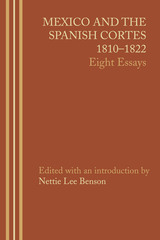 Mexico and the Spanish Cortes, 1810–1822: Eight Essays
Edited by Nettie Lee Benson
University of Texas Press, 1966 Few developments in the history of the Spanish colonial system in Mexico have been more carelessly treated or more often misinterpreted than the attempt to establish constitutional government in New Spain under the Spanish monarchy during the 1809–1814 and 1820–1822 periods. Yet the broad outlines of the Mexican constitutional system were laid then, largely through the insistent efforts of the Mexican deputies to the Cortes, the Spanish legislative body. Some of the delegates also grasped this opportunity to inform their countrymen and train them in the effectiveness of parliamentary debate and resolution as a more intelligent road to democratic and representative government. The 70 Mexican deputies (of the 160 elected) who actively participated in the sessions of the Cortes either helped draw up the Constitution of 1812, which initiated provisions for many needed reforms relating to military, religious, economic, educational, judicial, and governmental affairs in Mexico, or contributed to the enabling acts consequent to these provisions. The prime reason for calling the Cortes, however, and especially for inviting the participation of the Mexicans, was to attempt to maintain New Spain’s loyalty to the mother country, an unrealized objective in the long run, although much constructive discussion of this goal was offered by the Mexican delegates. These eight essays trace the establishment and implementation of the Mexican electoral system, both national and municipal, and of reforms in the economic, journalistic, religious, and military systems. They serve as an informative introduction to the revolutionary role the Cortes of Spain played in Mexican history and as a record of the contribution of Mexican delegates to the beginning of liberal reform in their country.
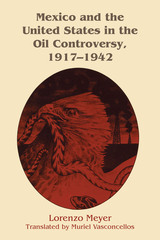 Mexico and the United States in the Oil Controversy, 1917–1942
By Lorenzo Meyer; translated by Muriel Vasconcellos
University of Texas Press, 1977 From reviews of the Spanish edition: “Meyer’s perceptive commentary on Mexican power politics presents new insights into the petroleum lobbies in Mexico City and Washington. With unbiased empathy he shows the validity of Mexico’s complaints about foreigners’ deriving an overabundance of profit from a nonrenewable natural resource. He understands United States history and never abuses his license to criticize.” —Hispanic American Historical Review “This useful addition to the literature on twentieth-century Mexican–United States diplomatic relations is a scholarly work, worthy of consideration by all students of the subject.”—American Historical Review Mexico and the United States in the Oil Controversy, 1917–1942 explores the relationship between the United States and Mexico during the first half of the twentieth century, with special attention to the Mexican nationalization of the oil industry. Relying on Mexican archival material never before analyzed, the author presents a unique perspective on the period following the Mexican Revolution and Mexico’s efforts to diminish its economic dependency on the United States. This work not only describes the political and economic struggle between the Mexican government and the U.S. oil companies but also serves to illustrate in general the nature of dependency between Latin American countries and the United States. It will be of interest not only to Mexican specialists but also to diplomatic and economic historians.
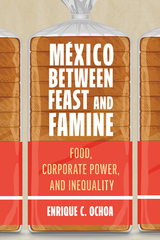 México Between Feast and Famine: Food, Corporate Power, and Inequality
Enrique C. Ochoa
University of Arizona Press, 2025 As the birthplace of maize and a celebrated culinary destination, Mexico stands at the crossroads of gastronomic richness and stark social disparities. In México Between Feast and Famine Enrique C. Ochoa unveils the historical and contemporary forces behind Mexico’s polarized food systems. México Between Feast and Famine provides one of the first comprehensive analyses of Mexico’s food systems and how they reflect the contradictions and inequalities at the heart of Mexico. Ochoa examines the historical roots and contemporary manifestations of neoliberal policies that have reshaped food production, distribution, and consumption in Mexico. Ochoa analyzes the histories of Mexico’s mega food companies, including GRUMA, Bimbo, Oxxo, Aurrera/Walmex, and reveals how corporations have captured the food system at the same time that diet-related diseases have soared. The author not only examines the economic and political dimensions of food production but also interrogates the social and cultural impacts. As debates around food sovereignty, globalization, and sustainable development intensify globally, México Between Feast and Famine provides a timely analysis that counters conventional narratives about Mexican cuisine. Even as it looks back, this work looks to the future, where more equitable and sustainable food systems prioritize social justice and community well-being.
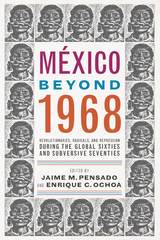 México Beyond 1968: Revolutionaries, Radicals, and Repression During the Global Sixties and Subversive Seventies
Edited by Jaime M. Pensado and Enrique C. Ochoa
University of Arizona Press, 2018 México Beyond 1968 examines the revolutionary organizing and state repression that characterized Mexico during the 1960s and 1970s. The massacre of students in Mexico City in October 1968 is often considered the defining moment of this period. The authors in this volume challenge the centrality of that moment by looking at the broader story of struggle and repression across Mexico during this time. México Beyond 1968 complicates traditional narratives of youth radicalism and places urban and rural rebellions within the political context of the nation’s Dirty Wars during this period.
The book illustrates how expressions of resistance developed from the ground up in different regions of Mexico, including Chihuahua, Guerrero, Jalisco, Mexico City, Puebla, and Nuevo León. Movements in these regions took on a variety of forms, including militant strikes, land invasions, cross-country marches, independent forums, popular organizing, and urban and rural guerrilla uprisings.
México Beyond 1968 brings together leading scholars of Mexican studies today. They share their original research from Mexican archives partially opened after 2000 and now closed again to scholars, and they offer analysis of this rich primary source material, including interviews, political manifestos, newspapers, and human rights reports.
By centering on movements throughout Mexico, México Beyond 1968 underscores the deep-rooted histories of inequality and the frustrations with a regime that monopolized power for decades. It challenges the conception of the Mexican state as “exceptional” and underscores and refocuses the centrality of the 1968 student movement. It brings to light the documents and voices of those who fought repression with revolution and asks us to rethink Mexico’s place in tumultuous times.
Contributors:
Alexander Aviña
Adela Cedillo
A. S. Dillingham
Luis Herrán Avila
Fernando Herrera Calderón Gladys I. McCormick
Enrique C. Ochoa
Verónica Oikión Solano
Tanalís Padilla
Wil G. Pansters
Jaime M. Pensado
Gema Santamaría
Michael Soldatenko
Carla Irina Villanueva
Eric Zolov
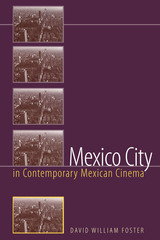 Mexico City in Contemporary Mexican Cinema
By David William Foster
University of Texas Press, 2002 Just as Mexican national life has come to center on the sprawling, dynamic, almost indefinable metropolis of Mexico City, so recent Mexican cinema has focused on the city not merely as a setting for films but almost as a protagonist in its own right, whose conditions both create meaning for and receive meaning from the human lives lived in its midst. Through close readings of fourteen recent critically acclaimed films, this book watches Mexican cinema in this process of producing cultural meaning through its creation, enaction, and interpretation of the idea of Mexico City. David William Foster analyzes how Mexican filmmakers have used Mexico City as a vehicle for exploring such issues as crime, living space, street life, youth culture, political and police corruption, safety hazards, gender roles, and ethnic and social identities. The book is divided into three sections. "Politics of the City" examines the films Rojo amanecer,Novia que te vea,Frida, naturaleza viva, and Sexo, pudor y lágrimas. "Human Geographies" looks at El Callejón de los Milagros,Mecánica nacional,El castillo de la pureza,Todo el poder, and Lolo. "Mapping Gender" discusses Danzón,De noche vienes,Esmeralda,La tarea,Lola, and Entre Pancho Villa y una mujer desnuda.
 The Mexico City Reader
Edited by Ruben Gallo
University of Wisconsin Press, 2004 Mexico City is one of Latin America’s cultural capitals, and one of the most vibrant urban spaces in the world. The Mexico City Reader is an anthology of "Cronicas"—short, hybrid texts that are part literary essay, part urban reportage—about life in the capital. This is not the "City of Palaces" of yesteryear, but the vibrant, chaotic, anarchic urban space of the1980s and 1990s—the city of garbage mafias, necrophiliac artists, and kitschy millionaires.
Like the visitor wandering through the city streets, the reader will be constantly surprised by the visions encountered in this mosaic of writings—a textual space brimming with life and crowded with flâneurs, flirtatious students, Indian dancers,
food vendors, fortune tellers, political activists, and peasant protesters.
The essays included in this anthology were written by a panoply of writers, from well-known authors like Carlos Monsiváis and Jorge Ibagüengoitia to younger figures like Fabrizio Mejía Madrid and Juieta García González, all of whom are experienced practitioners of the city. The texts collected in this anthology are among the most striking examples of this concomitant "theory and practice" of Mexico City, that most delirious of megalopolises.
“[An] exciting literary journey . . .”—Carolyn Malloy, Multicultural Review
 Mexico, From Mestizo to Multicultural: National Identity and Recent Representations of the Conquest
Carrie C. Chorba
Vanderbilt University Press, 2006 In Mexico, the confluence of the 1992 Quincentennial commemoration of Columbus's voyages and the neo-liberal sexenio, or presidency, of Carlos Salinas de Gortari spurred artistic creations that capture the decade like no other source does. In the 1990s, Mexican artists produced an inordinate number of works that revise and rewrite the events of the sixteenth-century conquest and colonization. These works and their relationship to, indeed their mirroring of, the intellectual and cultural atmosphere in Mexico during the Salinas presidency are of paramount importance if we are to understand the subtle but deep shifts within Mexico's national identity that took place at the end of the last century.
Throughout the twentieth century, the post-revolutionary Mexican State had used mestizaje as a symbol of national unity and social integration. By the end of the millennium, however, Mexico had gone from a PRI-dominated, economically protectionist nation to a more democratic, economically globalizing one. More importantly, the homogenizing, mestizophile national identity that pervaded Mexico throughout the past century had given way to official admission of Mexico's ethnic and linguistic diversity--or 'pluriculture' according to President Salinas's 1992 constitutional revision.
This book is the first interdisciplinary study of literary, cinematic, and graphic images of Mexican national identity in the 1980s and '90s. Discussing, in depth, writings, films, and cartoons from a vast array of contemporary sources, Carrie C. Chorba creates a social history of this important shift.
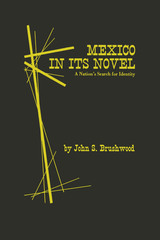 Mexico in Its Novel: A Nation's Search for Identity
By John S. Brushwood
University of Texas Press, 1966 Mexico in Its Novel is a perceptive examination of the Mexican reality as revealed through the nation's novel. The author presents the Mexican novel as a cultural phenomenon: a manifestation of the impact of history upon the nation, an attempt by a people to come to grips with and understand what has happened and is happening to them. Written in a clear and graceful style, this study examines the life of the novel as a genre against the background of Mexican chronology. It begins with a survey of the mid-twentieth-century novel, the Mexican novel which came of age in the period following the 1947 publication of Agustín Yáñez's The Edge of the Storm. During this time the novel resolved some of its most complicated problems and, as a result, offered a wider and deeper view of reality. Having established this circumstance, John Brushwood goes back in time to the Conquest and then moves forward to the twentieth-century novel. Passing from the Colonial Period into the nineteenth century, the author recognizes the relationship between Romanticism and the desire for logical social behavior, and then views this relationship in the perspective of the Reform, an attempt to bring order out of chaos. The novel under the Díaz dictatorship is seen in three different phases, and the last Díaz chapter actually moves into the Revolution itself. The novel during the years of fighting is considered along with the first post-Revolutionary fiction. From that point the developing conflict within Mexican reality itself—a conflict between introversion and extroversion, nationalism and cosmopolitanism—reaches out to seek its solution in the novels of the first chapter.
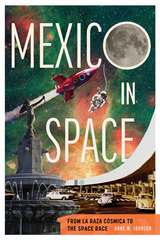 Mexico in Space: From la Raza Cósmica to the Space Race
Anne W. Johnson
University of Arizona Press, 2026 From Aztec sun stones to satellite launches, from muralist visions to dark sky parks, Mexico’s engagement with outer space is fundamental to its identity. Mexico in Space offers a groundbreaking look at how the country has navigated the tensions between technological dependence and sovereign dreams.
Anthropologist Anne W. Johnson reveals Mexico’s unique relationship with outer space, describing Indigenous knowledge, nationalist projects, artistic visions, and community practices. Through rich ethnographic detail and historical insight, Johnson challenges the notion that space is for everyone and shows whose voices truly shape the world’s cosmic futures. Johnson introduces us to satellite engineers, community astronomers, space generation youth, and artists imagining Mars, each crafting alternative cosmic futures.
As space exploration increasingly becomes the domain of billionaires and superpowers, this book offers a compelling counternarrative, demonstrating how Mexican cosmic engagements suggest more just, inclusive ways of inhabiting Earth and beyond and providing vital lessons for reimagining humanity’s place in the cosmos.
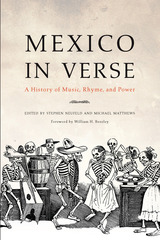 Mexico in Verse: A History of Music, Rhyme, and Power
Edited by Stephen Neufeld and Michael Matthews; Foreword by William H. Beezley
University of Arizona Press, 2015 The history of Mexico is spoken in the voice of ordinary people. In rhymed verse and mariachi song, in letters of romance and whispered words in the cantina, the heart and soul of a nation is revealed in all its intimacy and authenticity. Mexico in Verse, edited by Stephen Neufeld and Michael Matthews, examines Mexican history through its poetry and music, the spoken and the written word.
Focusing on modern Mexico, from 1840 to the 1980s, this volume examines the cultural venues in which people articulated their understanding of the social, political, and economic change they witnessed taking place during times of tremendous upheaval, such as the Mexican-American War, the Porfiriato, and the Mexican Revolution. The words of diverse peoples—people of the street, of the field, of the cantinas—reveal the development of the modern nation. Neufeld and Matthews have chosen sources so far unexplored by Mexicanist scholars in order to investigate the ways that individuals interpreted—whether resisting or reinforcing—official narratives about formative historical moments.
The contributors offer new research that reveals how different social groups interpreted and understood the Mexican experience. The collected essays cover a wide range of topics: military life, railroad accidents, religious upheaval, children’s literature, alcohol consumption, and the 1985 earthquake. Each chapter provides a translated song or poem that encourages readers to participate in the interpretive practice of historical research and cultural scholarship. In this regard, Mexico in Verse serves both as a volume of collected essays and as a classroom-ready primary document reader.
 Mexico, Interrupted: Labor, Idleness, and the Economic Imaginary of Independence
Sergio Gutiérrez Negrón
Vanderbilt University Press, 2023 Honorable Mention, Premio al Mejor Libro en Humanidades, Latin American Studies Association–Mexico Section, 2024
Mexican independence was, in a sense, an economic event. Through economic concerns, elites created a common ground with non-elites in their demands against foreign domination, and independence was imagined by the lettered men of Mexico as a feat that would nationalize a rich and productive economic apparatus.
Mexico, Interrupted investigates these economic hopes during the difficult decades between 1821, the year of the country’s definite separation from Spain, and 1852, a period of political polarization after the US-Mexico War that led the country to the brink of another armed conflict. Drawing on political and popular media, this book studies the Mexican intelligentsia’s obsession with labor and idleness in their attempts to create a wealthy, independent nation.
Focusing on figures of work and its opposites, Mexico, Interrupted reconstructs these decades’ “economic imaginaries of independence”: the political and cultural discourses that structured understandings, beliefs, and fantasies of the relationship between “the economy” and the life of an independent polity. By bringing together intellectual history, critical theory, and cultural studies, Gutiérrez Negrón offers a new account of the Mexican nineteenth century and complicates the history of the “spirit of capitalism” in the Americas.
Mexico Mystique: The Coming Sixth World of Consciousness
Frank Waters
Ohio University Press, 1989 In Mexico Mystique Frank Waters draws us deeply into the ancient but still-living myths of Mexico. To reveal their hidden meanings and their powerful symbolism, he brings to bear his gift for intuitive imagination as well as a broad knowledge of anthropology, Jungian psychology, astrology, and Eastern and esoteric religions. He offers a startling interpretation of the Mayan Great Cycle — our present Fifth World — whose beginning has been projected to 3113 B.C., and whose cataclysmic end has been predicted by 2011 A.D.
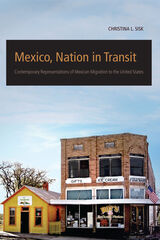 Mexico, Nation in Transit: Contemporary Representations of Mexican Migration to the United States
Christina L. Sisk
University of Arizona Press, 2011 Mexico, Nation in Transit examines how the Mexican migrant population in the United States is represented in the Mexican national im-aginary—on both sides of the border. Exploring representations of migration in literature, film, and music produced in the past twenty years, Christina Sisk argues that Mexico is imagined as a nation that exists outside of its territorial borders and into the United States. Although some Americans feel threatened by the determined resilience of Mexican national identity among immigrants, Sisk counters that the persis-tence of immigrant Mexicans’ identities with their homeland—with the cities, states, regions, and nation where they were born or have family—is not in opposition to their identity as Americans.
Sisk’s transnational investigation moves easily across the US–Mexico border, analyzing films made on both sides, literature de la frontera, Mexican rock music, migrant narratives, and texts written by second- and third-generation immigrants. Included are the perspectives of those who left Mexico, those who were left behind, and the children who travel back “home.” Sisk discovers that the loss of Mexicans to the United States through emigration has had an effect on Mexico similar to the impact of the perceived Mexican invasion of the United States.
Spanning the social sciences and the humanities, Mexico, Nation in Transit poses a new transnational alternative to the postnational view that geopolitical borders are being erased by the forces of migration and globalization, and the nationalist view that borders must be strictly enforced. It shows that borders, like identities, are not easy to locate precisely.
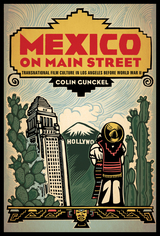 Mexico on Main Street: Transnational Film Culture in Los Angeles before World War II
Gunckel, Colin
Rutgers University Press, 2015 In the early decades of the twentieth-century, Main Street was the heart of Los Angeles’s Mexican immigrant community. It was also the hub for an extensive, largely forgotten film culture that thrived in L.A. during the early days of Hollywood. Drawing from rare archives, including the city’s Spanish-language newspapers, Colin Gunckel vividly demonstrates how this immigrant community pioneered a practice of transnational media convergence, consuming films from Hollywood and Mexico, while also producing fan publications, fiction, criticism, music, and live theatrical events. Mexico on Main Street locates this film culture at the center of a series of key debates concerning national identity, ethnicity, class, and the role of Mexicans within Hollywood before World War II. As Gunckel shows, the immigrant community’s cultural elite tried to rally the working-class population toward the cause of Mexican nationalism, while Hollywood sought to position them as part of a lucrative transnational Latin American market. Yet ironically, both Hollywood studios and Mexican American cultural elites used the media to present negative depictions of working-class Mexicans, portraying their behaviors as a threat to middle-class respectability. Rather than simply depicting working-class immigrants as pawns of these power players, however, Gunckel reveals their active participation in the era’s film culture.
Gunckel’s innovative approach combines media studies, urban history, and ethnic studies to reconstruct a distinctive, richly layered immigrant film culture. Mexico on Main Street demonstrates how a site-specific study of cultural and ethnic issues challenges our existing conceptions of U.S. film history, Mexican cinema, and the history of Los Angeles.
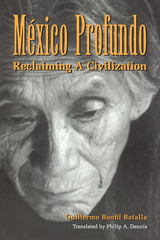 México Profundo: Reclaiming a Civilization
By Guillermo Bonfil Batalla
University of Texas Press, 1996 This translation of a major work in Mexican anthropology argues that Mesoamerican civilization is an ongoing and undeniable force in contemporary Mexican life. For Guillermo Bonfil Batalla, the remaining Indian communities, the "de-Indianized" rural mestizo communities, and vast sectors of the poor urban population constitute the México profundo. Their lives and ways of understanding the world continue to be rooted in Mesoamerican civilization. An ancient agricultural complex provides their food supply, and work is understood as a way of maintaining a harmonious relationship with the natural world. Health is related to human conduct, and community service is often part of each individual's life obligation. Time is circular, and humans fulfill their own cycle in relation to other cycles of the universe. Since the Conquest, Bonfil argues, the peoples of the México profundo have been dominated by an "imaginary México" imposed by the West. It is imaginary not because it does not exist, but because it denies the cultural reality lived daily by most Mexicans. Within the México profundo there exists an enormous body of accumulated knowledge, as well as successful patterns for living together and adapting to the natural world. To face the future successfully, argues Bonfil, Mexico must build on these strengths of Mesoamerican civilization, "one of the few original civilizations that humanity has created throughout all its history."
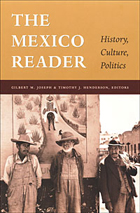 The Mexico Reader: History, Culture, Politics
Gilbert M. Joseph and Timothy J. Henderson, eds.
Duke University Press, 2002 The Mexico Reader is a vivid introduction to muchos Méxicos—the many Mexicos, or the many varied histories and cultures that comprise contemporary Mexico. Unparalleled in scope and written for the traveler, student, and expert alike, the collection offers a comprehensive guide to the history and culture of Mexico—including its difficult, uneven modernization; the ways the country has been profoundly shaped not only by Mexicans but also by those outside its borders; and the extraordinary economic, political, and ideological power of the Roman Catholic Church. The book looks at what underlies the chronic instability, violence, and economic turmoil that have characterized periods of Mexico’s history while it also celebrates the country’s rich cultural heritage. A diverse collection of more than eighty selections, The Mexico Reader brings together poetry, folklore, fiction, polemics, photoessays, songs, political cartoons, memoirs, satire, and scholarly writing. Many pieces are by Mexicans, and a substantial number appear for the first time in English. Works by Octavio Paz and Carlos Fuentes are included along with pieces about such well-known figures as the larger-than-life revolutionary leaders Pancho Villa and Emiliano Zapata; there is also a comminiqué from a more recent rebel, Subcomandante Marcos. At the same time, the book highlights the perspectives of many others—indigenous peoples, women, politicians, patriots, artists, soldiers, rebels, priests, workers, peasants, foreign diplomats, and travelers. The Mexico Reader explores what it means to be Mexican, tracing the history of Mexico from pre-Columbian times through the country’s epic revolution (1910–17) to the present day. The materials relating to the latter half of the twentieth century focus on the contradictions and costs of postrevolutionary modernization, the rise of civil society, and the dynamic cross-cultural zone marked by the two thousand-mile Mexico-U.S. border. The editors have divided the book into several sections organized roughly in chronological order and have provided brief historical contexts for each section. They have also furnished a lengthy list of resources about Mexico, including websites and suggestions for further reading.
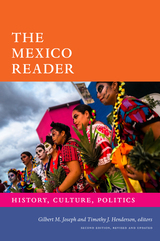 The Mexico Reader: History, Culture, Politics
Gilbert M. Joseph and Timothy J. Henderson, editors
Duke University Press, 2022 The Mexico Reader is a vivid and comprehensive guide to muchos Méxicos—the many varied histories and cultures of Mexico. Unparalleled in scope, it covers pre-Columbian times to the present, from the extraordinary power and influence of the Roman Catholic Church to Mexico’s uneven postrevolutionary modernization, from chronic economic and political instability to its rich cultural heritage. Bringing together over eighty selections that include poetry, folklore, photo essays, songs, political cartoons, memoirs, journalism, and scholarly writing, this volume highlights the voices of everyday Mexicans—indigenous peoples, artists, soldiers, priests, peasants, and workers. It also includes pieces by politicians and foreign diplomats; by literary giants Octavio Paz, Gloria Anzaldúa, and Carlos Fuentes; and by and about revolutionary leaders Pancho Villa and Emiliano Zapata. This revised and updated edition features new selections that address twenty-first-century developments, including the rise of narcopolitics, the economic and personal costs of the United States’ mass deportation programs, the political activism of indigenous healers and manufacturing workers, and the impact of the COVID-19 pandemic. The Mexico Reader is an essential resource for travelers, students, and experts alike.
Mexico Reading the United States
Linda Egan
Vanderbilt University Press, 2009 The thirteen original essays in this collection explore the Mexican point of view from the 1920s to the present in order to register often unheard voices in the complex cross-border, cross-cultural reality shared by the two nations. The contributors, all of whom have personal experience with the challenges of bi-cultural and bi-national living, discuss travel writing, novels, film, essays, political cartoons, and Mexican sociocultural movements.
In a time of ever-increasing migration of capital and human beings, this book turns on its head the usual perspective of U.S. economic and cultural dominance in order to deepen understanding of the bi-national relationship.
 Mexico s New Cultural History: ¿Una Lucha Libre?, Volume 79
Susan Deans-Smith and Gilbert M. Joseph, eds.
Duke University Press In this special issue of the Hispanic American Historical Review, the editors stepped outside the sometimes narrow confines of technical academic writing. They sought contributors who were willing to dive into an honest, open discussion of Mexico’s cultural history. The result is a vigorous, complex, innovative, and occasionally humorous discussion of the pros and cons of a new cultural historical approach to Mexican history. All the contributors to this issue agree on the importance and relevance of a historical study of culture in its most inclusive sense. But there is much less consensus about the promise and potential of a "new cultural history" of Mexico and Latin America. While some of the contributors celebrate new interpretive and methodological advances, others express concern about the dangers of overinterpretation, untoward speculation, and the imposition of postmodernist concepts. Contributors and topics covered include:
Susan Deans-Smith and Gilbert M. Joseph on the Arena of Dispute
Eric Van Young on the New Cultural History
William E. French on Cultural History of Nineteenth-Century Mexico
Mary Kay Vaughan on Cultural Approaches to Peasant Politics in the Mexican Revolution
Stephen Haber on Mexico’s "New" Cultural History
Florencia E. Mallon on Cycles of Revisionism
Susan Migden Socolow on Putting the "Cult" in Culture
Claudio Lomnitz on the Politics of the "New Cultural History of Mexico"
Mexico Through Russian Eyes, 1806-1940
William Harrison Richardson
University of Pittsburgh Press, 1988 In this unique book, William Richardson analyzes the descriptions given of Mexico by an assortment of Russian visitors, from the employees of the Russian-American Company who made their first contacts in the early nineteenth century to the artists, diplomats, and exiles of the twentieth century. He explores the biases they brought with them and the interpretations they relayed back to readers at home. Richardson finds that Russians had a particular empathy for the Mexicans, sharing a perceived similarity in their histories: conquest by a foreign power; a long period of centralized, authoritarian rule; an attempt at liberal reform followed by revolution.
 Mexico Unveiled: Resisting Colonial Vices and Other Complaints
Carlos Pereda; Translated by Noell Birondo with Andres Bonilla
Vanderbilt University Press, 2025 Carlos Pereda’s Mexico Unveiled is a fresh, idiosyncratic synthesis of twentieth-century Mexican philosophy that puts contemporary debates about Mexican identity politics into a critical perspective. This edition—translated, edited, and introduced by Noell Birondo—brings the Mexican thinker’s ideas to a new English-language audience.
In three engaging essays written in a peerless prose style, Pereda considers the persistent influence of European colonialism on Mexican intellectual life, the politics of inclusion, and the changing ideas of what it means to be Mexican. He identifies three “vices”—social habits, customs, and beliefs inherited from European colonialism—that have influenced the development of Mexican national identity: subaltern fervor, craving for novelty, and nationalist zeal. Pereda demonstrates that these three tendencies have led Mexican intellectuals, and Mexican society more generally, to uncritically adopt a politics of exclusion and destructive nationalist attitudes.
Using a strategy he calls “nomadic” thinking—the act of moving beyond our cultural preconceptions and habits of thinking—Pereda guides readers through a number of examples drawn from Mexican philosophy and culture that illustrate these tendencies. At its core, Mexico Unveiled is an accessible and entertaining introduction to the philosophical themes that have long occupied Pereda’s life and work and Mexican philosophy more generally.
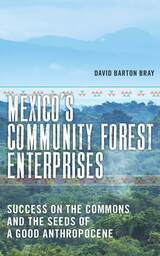 Mexico’s Community Forest Enterprises: Success on the Commons and the Seeds of a Good Anthropocene
David Barton Bray
University of Arizona Press, 2020 The road to sustainable forest management and stewardship has been debated for decades. Some advocate for governmental control and oversight. Some say that the only way to stem the tide of deforestation is to place as many tracts as possible under strict protection. Caught in the middle of this debate, forest inhabitants of the developing world struggle to balance the extraction of precarious livelihoods from forests while responding to increasing pressures from national governments, international institutions, and their own perceptions of environmental decline to protect biodiversity, restore forests, and mitigate climate change.
Mexico presents a unique case in which much of the nation’s forests were placed as commons in the hands of communities, who, with state support and their own entrepreneurial vigor, created community forest enterprises (CFEs). David Barton Bray, who has spent more than thirty years engaged with and researching Mexican community forestry, shows that this reform has transformed forest management in that country at a scale and level of maturity unmatched anywhere else in the world.
For decades Mexico has been conducting a de facto large-scale experiment in the design of a national social-ecological system (SES) focused on community forests. What happens when you give subsistence communities rights over forests, as well as training, organizational support, equipment, and financial capital? Do the communities destroy the forest in the name of economic development, or do they manage them sustainably, generating current income while maintaining intergenerational value as a resource for their children? Bray shares the scientific and social evidence that can now begin to answer these questions. This is an invaluable resource for students, researchers, and the interested public on the future of global forest resilience and the possibilities for a good Anthropocene.
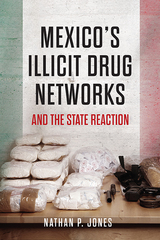 Mexico's Illicit Drug Networks and the State Reaction
Nathan P. Jones
Georgetown University Press Mexican drug networks are large and violent, engaging in activities like the trafficking of narcotics, money laundering, extortion, kidnapping, and mass murder. Despite the impact of these activities in Mexico and abroad, these illicit networks are remarkably resilient to state intervention. Drawing on extensive fieldwork and interviews with US and Mexican law enforcement, government officials, organized crime victims, and criminals, Nathan P. Jones examines the comparative resilience of two basic types of drug networks—“territorial” and “transactional”—that are differentiated by their business strategies and provoke wildly different responses from the state. Transactional networks focus on trafficking and are more likely to collude with the state through corruption, while territorial networks that seek to control territory for the purpose of taxation, extortion, and their own security often trigger a strong backlash from the state. Timely and authoritative, Mexico's Illicit Drug Networks and the State Reaction provides crucial insight into why Mexico targets some drug networks over others, reassesses the impact of the war on drugs, and proposes new solutions for weak states in their battles with drug networks.
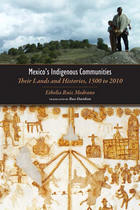 Mexico's Indigenous Communities: Their Lands and Histories, 1500-2010
Ethelia Ruiz Medrano
University Press of Colorado, 2010 A rich and detailed account of indigenous history in central and southern Mexico from the sixteenth to the twenty-first centuries, Mexico's Indigenous Communities is an expansive work that destroys the notion that Indians were victims of forces beyond their control and today have little connection with their ancient past. Indian communities continue to remember and tell their own local histories, recovering and rewriting versions of their past in light of their lived present. Ethelia Ruiz Medrano focuses on a series of individual cases, falling within successive historical epochs, that illustrate how the practice of drawing up and preserving historical documents-in particular, maps, oral accounts, and painted manuscripts-has been a determining factor in the history of Mexico's Indian communities for a variety of purposes, including the significant issue of land and its rightful ownership. Since the sixteenth century, numerous Indian pueblos have presented colonial and national courts with historical evidence that defends their landholdings. Because of its sweeping scope, groundbreaking research, and the author's intimate knowledge of specific communities, Mexico's Indigenous Communities is a unique and exceptional contribution to Mexican history. It will appeal to students and specialists of history, indigenous studies, ethnohistory, and anthropology of Latin America and Mexico
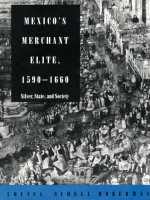 Mexico's Merchant Elite, 1590-1660: Silver, State, and Society
Louisa Schell Hoberman
Duke University Press, 1991 Combining social, political, and economic history, Louisa Schell Hoberman examines a neglected period in Mexico’s colonial past, providing the first book-length study of the period’s merchant elite and its impact on the evolution of Mexico.
Through extensive archival research, Hoberman brings to light new data that illuminate the formation, behavior, and power of the merchant class in New Spain. She documents sources and uses of merchant wealth, tracing the relative importance of mining, agriculture, trade, and public office. By delving into biographical information on prominent families, Hoberman also reveals much about the longevity of the first generation’s social and economic achievements.
The author’s broad analysis situates her study in the overall environment in which the merchants thrived. Among the topics discussed are the mining and operation of the mint, Mexico’s political position vis-a-vis Spain, and the question of an economic depression in the seventeenth century.
 Mexico's Middle Class in the Neoliberal Era
Dennis Gilbert
University of Arizona Press, 2007 Mexico’s modern middle class emerged in the decades after World War II, a period of spectacular economic growth and social change. Though little studied, the middle class now accounts for one in five Mexican households. This path-breaking book explores the changing fortunes and political transformation of the middle class, especially during the last two decades, as Mexico has adopted new, market-oriented economic policies and has abandoned one-party rule.
Blending the personal narratives of middle-class Mexicans with analyses of national surveys of households and voters, Dennis Gilbert traces the development of the middle class since the 1940s. He describes how middle-class Mexicans were affected by the economic upheavals of the 1980s and 1990s and examines their shifting relations with the ruling Partido Revolucionario Institucional (PRI).
Long faithful to the PRI, the middle class gradually grew disenchanted. Gilbert examines middle-class reactions to the 1968 Tlatelolco massacre, the 1982 debt crisis, the government’s feeble response to the 1985 Mexico City earthquake, and its brazen manipulation of the vote count in the 1988 presidential election. Drawing on detailed interviews with Mexican families, he describes the effects of the 1994–95 peso crisis on middle-class households and their economic and political responses to it. His analysis of exit poll data from the 2000 elections shows that the lopsided middle-class vote in favor of opposition candidate Vicente Fox played a critical role in the election that drove the PRI from power after seven decades.
The book closes with an epilogue on the middle class and the July 2006 presidential elections.
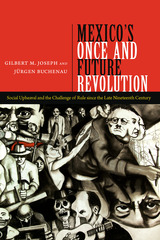 Mexico's Once and Future Revolution: Social Upheaval and the Challenge of Rule since the Late Nineteenth Century
Gilbert M. Joseph and Jürgen Buchenau
Duke University Press, 2013 In this concise historical analysis of the Mexican Revolution, Gilbert M. Joseph and Jürgen Buchenau explore the revolution's causes, dynamics, consequences, and legacies. They do so from varied perspectives, including those of campesinos and workers; politicians, artists, intellectuals, and students; women and men; the well-heeled, the dispossessed, and the multitude in the middle. In the process, they engage major questions about the revolution. How did the revolutionary process and its aftermath modernize the nation's economy and political system and transform the lives of ordinary Mexicans? Rather than conceiving the revolution as either the culminating popular struggle of Mexico's history or the triumph of a new (not so revolutionary) state over the people, Joseph and Buchenau examine the textured process through which state and society shaped each other. The result is a lively history of Mexico's "long twentieth century," from Porfirio Díaz's modernizing dictatorship to the neoliberalism of the present day.
 Mexicos Political Awakening
Vikram Chand
University of Notre Dame Press, 2000 True democracy has been long in coming to Mexico, but citizen rebellion and the work of social leaders helped bring about dramatic changes at the end of the twentieth century. The traditional dominance of the one-party state has yielded to a more democratic structure marked by growing decentralization and the adoption of fairer election rules and procedures.
Vikram Chand examines the role of major institutions in fostering democratization in Mexico during the 1980s and 1990s, offering an understanding of how these changes came about and why they are likely to last. He focuses on three important factors that fostered this transition: the growing participation of the Catholic Church and its lay organizations in politics, the proliferation of non-governmental civic associations dedicated to promoting clean elections, and the emergence of vibrant opposition parties. He particularly highlights the conservative National Action Party, about which little has been written in English.
Chand tells how the rise of a more politically-aware citizenry and the growing power of non-state institutions pressured the ruling Institutional Revolutionary Party into adopting electoral reforms, resulting in the first open primary for gubernatorial elections in 1998. Using the state of Chihuahua as a case study, he draws on primary research--including 293 interviews with key figures in the political process--to demonstrate how the mutual interaction of national and regional politics has helped bring about these democratic transitions.
Mexico's Political Awakening is a "bottom-up" perspective on democratization, correcting analyses which view that process in Mexico as flowing down from the President. It challenges existing theories of democratization by emphasizing the importance of strong social institutions for the development of democracy, and it demonstrates that increases in political participation play a vital role in strengthening those institutions.
Vikram K. Chand is Senior Public Sector Management Specialist, The WorldBank, New Delhi.
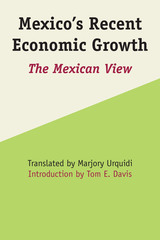 Mexico's Recent Economic Growth: The Mexican View
Translated by Marjory Urquidi; Essays by Enrique Pérez López and others, introduction by Tom E. Davis
University of Texas Press, 1967 The Mexican economy underwent a process of growth and transformation in the twentieth century, which was confirmed by the indexes and figures that economists use to chart the rate of growth, even allowing for possible inaccuracies in these figures. This volume of six essays makes readily available to English-speaking readers a selection of significant contributions by outstanding Mexican economists dealing with the mid-twentieth-century growth of the Mexican economy. Enrique Pérez López provides an overview of the development of the gross national product in the economy and the structural changes that were imperative if basic social goals were to be implemented and the optimal adjustments to changing world conditions effected. Ernesto Fernández Hurtado discusses the process of accommodation and cooperation between the public and the private sectors that has contributed significantly to economic growth, stressing particularly the role of agriculture. Mario Ramón Beteta describes central bank policy and the functioning of the Central Bank, showing how control over credit and the banking system assures stability and accelerating growth through its credit rationing. Alfredo Navarrete R. traces the sources of domestic savings that have provided 90 percent of the capital employed in the economy since the Revolution, and Ifigenia M. de Navarrete demonstrates that rapid economic growth has not resulted in a more equitable distribution of income. Victor Urquidi stresses the balanced growth, achieved by allocating public capital formation to basic infrastructure, that has helped develop agriculture as well as industry, and indicates the nature of the structural change that must occur if the economy is to expand rapidly. In his introduction Tom E. Davis compares growth in Mexico with developments during the same period in Chile and Argentina. The country reached its midcentury standard of living after fifty years of drastic social and political changes under a constitution that altered the system and the concept of private property and the role of the state. These new concepts brought about changes in the structure of production and social relationships, together with a rise to new cultural, technical, and moral levels. These changes, in turn, placed Mexico in a new position with new problems. A question that must be answered is whether the economic goals of the future require a reappraisal of social relationships and of the ways of administering and utilizing the country’s resources and potential productivity.
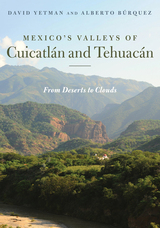 Mexico’s Valleys of Cuicatlán and Tehuacán: From Deserts to Clouds
David Yetman and Alberto Búrquez
University of Arizona Press, 2023 Mexico’s Valleys of Cuicatlán and Tehuacán: From Deserts to Clouds provides an accessible and photographic view of the culture, history, and environment of an extraordinary region of southern Mexico. The Valleys of Cuicatlán and Tehuacán are lauded by botanists for their spectacular plant life—they contain the densest columnar cacti forests in the world. Recent archaeological excavations reveal them also to be a formative Mesoamerican site as well. So singular is this region that it is home to the Tehuacán-Cuicatlán Biosphere Reserve and a UNESCO World Heritage Site.
Through firsthand experience and engaging prose, the authors provide a synthesis of the geology, ecology, history, and cultures of the valleys, showing their importance and influence as Mesoamerican arteries for environmental and cultural interchange through Mexico. It also reveals the extraordinary plant life that draws from habitats ranging from deserts to tropical forests.
The authors, both experts in their respective fields, begin with a general description of the geography of the valleys, followed by an introduction to climate and hydrology, a look at the valleys’ often bewildering geology. The book delves into cultural and linguistic backgrounds of the valleys and discusses archaeological sites that that encapsulate the valleys’ fascinating history prior to the arrival of Europeans. The book concludes by describing the flora that makes the region so singular.
 Mexico-Tenochtitlan: Dynamism at the Center of the World
Barbara E. Mundy, Leonardo López Luján, and Elizabeth Hill Boone
Harvard University Press Tenochtitlan enjoyed a meteoric rise to power beginning in the fourteenth century, when its leaders transformed it into the political, economic, and spiritual center of the Mexica. Even after its rulership was decapitated following the Spanish invasion of 1519–1521, the city (rechristened Mexico City) remained a dynamic urban center. Mexico-Tenochtitlan: Dynamism at the Center of the World looks anew at the reasons for the city’s rapid consolidation and enduring status as an imperial capital. Commemorating the 500th anniversary of the fall of Tenochtitlan, the thirteen chapters of this volume highlight recent discoveries brought to light by archaeological and archival research; discuss excavations of offerings, burials, and skull racks as the physical residue of ephemeral performances; and examine sculptures, manuscripts, ritual objects, and luxury items as indices of artistic production and imperial ideologies. By setting continuities against the backdrop of regime change, particularly in the Indigenous sphere and among Indigenous actors, these chapters, written by archaeologists, art historians, and object conservators enable us to see how phenomena forged in the pre-Hispanic period were carried across the sixteenth century.
Meyerhold and the Cubists: Perspectives on Painting and Performance
Amy Skinner
Intellect Books, 2015 This book offers a rich analysis of collage practices in the theater of Vsevolod Meyerhold. Focusing on the philosophical and formal tenets of the form, and supporting her analysis with wide-ranging examples from both theater and fine art, Amy Skinner develops collage as a framework for reading the whole of the theatrical experience, from scenography and mise-en-scène to text and spectatorship. An innovative exploration of the influence of collage on twentieth- and twenty-first-century theater, Meyerhold and the Cubists will be essential for theater scholars and practitioners alike.
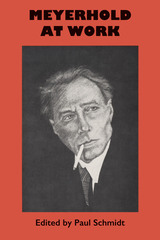 Meyerhold at Work
Edited by Paul Schmidt; translations by Paul Schmidt, Ilya Levin, and Vern McGee
University of Texas Press, 1980 “Not a mirror but a magnifying glass”—such, in the poet Mayakovsky’s words, was the theater of Vsevolod Meyerhold. The first to insist on the primacy of the director’s role, indeed the first to conceive of it as a role, this passionately dedicated Russian director tore down the fourth wall and forced the actors and audience together into one inescapable community of experience. Yet Meyerhold recorded few of his theories in writing, and the intensity and brilliance of his work must be recaptured through the actors and artists who helped create the performances. Focusing on Meyerhold’s postrevolutionary career, Paul Schmidt has assembled in this book journals, letters, reminiscences, and, of special interest, actual rehearsal notes that build a fascinating, intimate picture of Meyerhold as a theorist and as a man. Included are Meyerhold’s frantic notes to his teacher, friend, and bête noire Stanislavsky; detailed descriptions of how he trained his actors in “biomechanics”; and memories by such students as Eisenstein and such friends as Pasternak and Ehrenburg. One chapter deals with Meyerhold’s never-realized conception of Boris Godunov, while another describes his direction of Camille, which starred Zinaida Raikh, his wife, and which played its 725th and last performance on the day Stalin’s government liquidated Meyerhold’s theater. Paul Schmidt’s introduction and headnotes enhance our understanding of Meyerhold as a pioneer of modern theater.
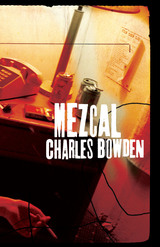 Mezcal
By Charles Bowden
University of Texas Press, 1988 Praise for Mezcal: "Mezcal is also a lyrical meditation upon the ultimate strength of the land, specifically the desert Southwest, and how that land prevails and endures despite every effort of modern industry and development to rape and savage it in the name of progress. Mezcal lingers in the mind as only the very best books manage to do."—Harry Crews "The author . . . excavates his own tormented life—and its relation to the land he loves—in a series of powerful, imagistic autobiographical essays. Like the desert he cherishes, this memoir is harsh yet lovely, full of sour self-truth. . . . A potent presentation of the wounds of one man's life, packed with indelible impressions; but there's little healing here, making this a bitter if beautiful read."—Kirkus Review "In Mezcal . . . Bowden drops the journalistic veil, exploring the ecology of his interior landscape at least as thoroughly as the changing scenery that surrounds him. . . . Others—Aldo Leopold, Edward Abbey—have already staked inviolate claims on the Southwestern deserts. But Bowden owns the complex terrain where, like a mezcal-inspired mirage, the Sonoran sun-belt overlaps the gray convolutions of the American mind."—Los Angeles Times
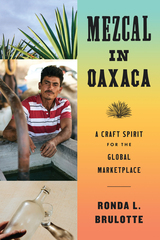 Mezcal in Oaxaca: A Craft Spirit for the Global Marketplace
Ronda L. Brulotte
University of Texas Press, 2025 An ethnography of mezcal and how it has become a global, "artisanal" good. Mezcal is booming. Once considered a peasant drink—the rough, lowbrow cousin of the more refined tequila—the smoky spirit is now prized by connoisseurs the world over. It is also hailed as a savior of Oaxaca, powering a craft industry that can uphold rural economies and Indigenous traditions. Ronda L. Brulotte traces mezcal’s swift rise and its effects on communities that have distilled and enjoyed the beverage for generations. Only in the late 1990s did mezcal begin to escape its longstanding associations with Indigenous and working-class life, even as these very qualities supply the “authenticity” that elite consumers crave. Through a detailed ethnography of the spirits industry in Oaxaca, Brulotte compares the ideal of the artisanal economy with the reality of participation in global markets. Her findings—focused on tourism-led development and gentrification, the exploitation of women and smallholders, and swelling regional migration pressures—raise troubling questions about the ecological and social sustainability of a new craft imaginary that rebrands rustic products as luxury goods.
Mezukak Shivatayim: Studies in Jewish Life and Literature in Honor of Bernard Septimus
Edward Breuer, Elisha Russ-Fishbane, and Adena Tanenbaum
Harvard University Press, 2026 Mezukak Shivatayim brings together the work of over a dozen students of Professor Bernard Septimus as a tribute to his superb and masterful scholarship. In his writing and teaching, Septimus exhibited an extraordinary breadth of interests, an exquisite ability to draw nuance and cultural resonance from Hebrew texts, and deep historical insights. These qualities are on display in the essays in this volume, which cover a wide range of philosophical, literary, and historical topics ranging from the tenth to the twentieth centuries. The themes include rabbinic culture, Jewish thought and literature, and Jewish communities in their Christian and Muslim contexts.
 Mi lengua: Spanish as a Heritage Language in the United States, Research and Practice
Ana Roca and M. Cecilia Colombi, Editors
Georgetown University Press, 2003 An increasing number of U.S. Latinos are seeking to become more proficient in Spanish. The Spanish they may have been exposed to in childhood may not be sufficient when they find themselves as adults in more demanding environments, academic or professional. Heritage language learners appear in a wide spectrum of proficiency, from those who have a low level of speaking abilities, to those who may have a higher degree of bilingualism, but not fluent. Whatever the individual case may be, these heritage speakers of Spanish have different linguistic and pedagogical needs than those students learning Spanish as a second or foreign language. The members of the American Association of Teachers of Spanish and Portuguese (AATSP) have identified teaching heritage learners as their second greatest area of concern (after proficiency testing). Editors Ana Roca and Cecilia Colombi saw a great need for greater availability and dissemination of scholarly research in applied linguistics and pedagogy that address the development and maintenance of Spanish as a heritage language and the teaching of Spanish to U.S. Hispanic bilingual students in grades K-16. The result is Mi lengua: Spanish as a Heritage Language in the United States. Mi lengua delves into the research, theory, and practice of teaching Spanish as a heritage language in the United States. The editors and contributors examine theoretical considerations in the field of Heritage Language Development (HLD) as well as community and classroom-based research studies at the elementary, secondary, and university levels. Some chapters are written in Spanish and each chapter presents a practical section on pedagogical implications that provides practice-related suggestions for the teaching of Spanish as a heritage language to students from elementary grades to secondary and college and university levels.
 Miami in the Anthropocene: Rising Seas and Urban Resilience
Stephanie Wakefield
University of Minnesota Press, 2025 Reimagining adaptation amidst climate change–driven mutations of urban space and life Between its susceptibility to flooding and an ever-expanding real estate market powered by global surges of people and capital, Miami is an epicenter of the urban Anthropocene and a living laboratory for adaptation to sea level rise. Miami in the Anthropocene explores the social, environmental, and technical transformations involved in climate adaptation infrastructure and imaginaries in a global city seen as climate change ground zero. Using Miami as a compelling microcosm for understanding the complex interplay between urbanization and environmental upheaval in the twenty-first century, Stephanie Wakefield shows how “aqua-urban futures” are being imagined for the city, from governmental scenario exercises for severe weather events to proposals to transform the city’s metropolitan area into an archipelago of islands connected by bridges. She examines the shifts reweaving the fabric of urban life and presents designs that imagine dramatic new ways of living with water. Grounded in the dynamic landscape of Miami but reaching far beyond its shores, Miami in the Anthropocene delves into the broader debates shaping urban thought and practice in the Anthropocene. Focusing on postresilience urban designs, Wakefield illuminates the path toward a future where cities embrace opportunities for evolution rather than merely for survival.
The Miami Indians of Indiana: A Persistent People, 1654-1994
Stewart Rafert
Indiana Historical Society Press, 1996 Now scattered in small communities in northern Indiana, the Eastern Miami Indians, once a well-known tribe, have lived in undeserved obscurity since the 1840s. In recent years they have become more visible as they have sought restoration of treaty rights and have revitalized their culture. The post-removal history of the Indiana Miami tribe is a rich texture of social, legal, and economic history, much enhanced by folklore and a rich series of photographic images. In The Miami Indians of Indiana: A Persistent People, 1654–1994, Rafert explores the history and culture of the Miami Indians.
 Mice in the Freezer, Owls on the Porch: The Lives of Naturalists Frederick and Francis Hamerstrom
Helen M. Corneli
University of Wisconsin Press, 2006 Mice in the Freezer, Owls on the Porch is in many ways a love story—about a quiet scientist and his flamboyant wife, but also about their passions for hunting, for wild lands, and for the grouse and raptor species that they were instrumental in saving from destruction.
From the papers and letters of Frederick and Frances Hamerstrom, the reminiscences of contemporaries, and her own long friendship with this extraordinary couple who were her neighbors, Helen Corneli draws an intimate picture of Fran and "Hammy" from childhood through the genesis and maturation of a romantic, creative, and scientific relationship. Following the Hamerstroms as they give up a life of sophisticated convention and comfort for the more "civilized" (as Aldo Leopold would have it) pleasures of living and conducting on-the-spot research into diminishing species, Corneli captures the spirit of the Hamerstroms, their profession, and the natural and human environments in which they worked. A nuanced account of the labors, adventures, and achievements that distinguished the Hamerstroms over the years—and that inspired a generation of naturalists—this book also provides a dramatic account of conservation history over the course of the twentieth century, particularly in Wisconsin during the eventful years from the 1920s through the 1970s.
 Michael Bay
Lutz Koepnick
University of Illinois Press, 2018 If size counts for anything, Michael Bay towers over his contemporaries. His summer-defining event films involve extraordinary production costs and churn enormous box office returns. His ability to mastermind breathtaking spectacles of action, mayhem, and special effects continually push the movie industry as much as the medium of film toward new frontiers. Lutz Koepnick engages the bigness of works like Armageddon and the Transformers movies to explore essential questions of contemporary filmmaking and culture. Combining close analysis and theoretical reflection, Koepnick shows how Bay's films, knowingly or not, address profound issues about what it means to live in the late twentieth- and early twenty-first centuries. According to Koepnick's astute readings, no one eager to understand the state of cinema today can ignore Bay's work. Bay's cinema of world-making and transnational reach not only exemplifies interlocking processes of cultural and economic globalization. It urges us to contemplate the future of moving images, of memory, matter, community, and experience, amid a time of rampant political populism and ever-accelerating technological change. An eye-opening look at one of Hollywood's most polarizing directors, Michael Bay illuminates what energizes the films of this cinematic and cultural force.
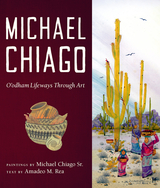 Michael Chiago: O’odham Lifeways Through Art
Paintings by Michael Chiago Sr. Text by Amadeo M. Rea
University of Arizona Press, 2022 This book offers an artistic depiction of O’odham lifeways through the paintings of internationally acclaimed O’odham artist Michael Chiago Sr. Ethnobiologist Amadeo M. Rea collaborated with the artist to describe the paintings in accompanying text, making this unique book a vital resource for cultural understanding and preservation. A joint effort in seeing, this work explores how the artist sees and interprets his culture through his art.
A wide array of Chiago’s paintings are represented in this book, illustrating past and present Akimel O’odham and Tohono O’odham culture. The paintings show the lives and traditions of O’odham people from both the artist’s parents’ and grandparents’ generations and today. The paintings demonstrate the colonial Spanish, Mexican, and Anglo-American influences on O’odham culture throughout the decades, and the text explains how wells and windmills, schools, border walls, and nonnative crops have brought about significant change in O’odham life. The paintings and text in this book beautifully depict a variety of O’odham lifeways, including the striking Sonoran Desert environment of O’odham country, gathering local foods and cooking meals, shrines, ceremonies, dances, and more.
By combining Chiago’s paintings of his lived experiences with Rea’s ethnographic work, this book offers a full, colorful, and powerful picture of O’odham heritage, culture, and language, creating a teaching reference for future generations.
Michael Faraday's 'Chemical Notes, Hints, Suggestions and Objects of Pursuit' of 1822
Ryan D. Tweney
The Institution of Engineering and Technology, 1991 Modern life now depends on the application of Faraday's discoveries of the electric motor, transformer and the dynamo; modern physical theories reflect the field-conception of natural powers that he pioneered. Faraday's chemical notebook of 1822 is one of the most significant of Faraday's unpublished writings because it served as a place to explore possibilities and questions, rather than to record laboratory work. Transcribed and published here for the first time, the notebook shows that Faraday's physical achievements emerged from the context of applied, laboratory chemistry. It foreshadows many of his most important discoveries, and offers a revealing glimpse into the mind and scientific aspirations of a master experimentalist.
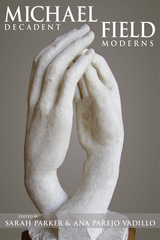 Michael Field: Decadent Moderns
Sarah Parker
Ohio University Press, 2019 In the last twenty years, Michael Field has emerged as one of the most fascinating poets of the Victorian era. Through their collaborative partnership as “Michael Field,” Katharine Bradley and Edith Cooper engaged in the aesthetic and decadent movements of the fin de siècle, while their poetry and verse drama articulate ideas associated with the New Woman and boldly express queer and lesbian desire. Michael Field: Decadent Moderns extends the focus on these key literary and cultural contexts by emphasizing their continuing significance within twentieth-century literary modernism. Through a series of interdisciplinary essays, this book addresses Michael Field’s energetic engagements with a range of topics including ecology, perfume, tourism, art history, sculpture, formalism, classics, and book history. In doing so, Michael Field: Decadent Moderns highlights the modernity, radicalism, and relevance of their work, both within the nineteenth and twentieth centuries as well as in our own cultural moment. Contributors: Leire Barrera-Medrano, Joseph Bristow, Jill R. Ehnenn, Sarah E. Kersh, Kristin Mahoney, Catherine Maxwell, Alex Murray, Sarah Parker, Margaret D. Stetz, Kate Thomas, and Ana Parejo Vadillo.
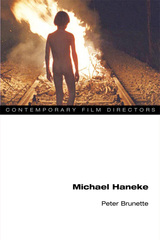 Michael Haneke
Peter Brunette
University of Illinois Press, 2010 In this book, Peter Brunette analyzes the theatrical releases of Austrian film director Michael Haneke, including The White Ribbon, winner of the 2009 Palme d'Or at the Cannes Film Festival. Perhaps best known to U.S. audiences for Caché, The Piano Teacher, and his remake of his own disturbing Funny Games, Haneke has consistently challenged critics and film viewers to consider their own responsibility for what they watch when they seek to be "merely" entertained by such studio-produced Hollywood thrillers. Brunette highlights Haneke's brilliant use of uncompromising visual and aural techniques to express complex themes. His most recent films contain what has become his hallmark: a moment of violence or shock that is not intended to be exploitative, but that nevertheless goes beyond the conventional boundaries of most art cinema. Lauded for graphically revealing the powerful influence of contemporary media on social behavior, his films offer a chilling critique of contemporary consumer society. Brunette discusses Haneke's major releases in English, French, and German, including the film that first brought him to international attention, Benny's Video. The first full-length study of Haneke's work in any language, this book also includes an interview with the director that explores his motivations and methods.
 Michael Haneke: The Intermedial Void
Christopher Rowe
Northwestern University Press, 2017 The two primary goals of this ambitious study are to provide a new framework in which to interpret the films of Michael Haneke, including Funny Games, Caché, and others, and to show how the concept of intermediality can be used to expand the possibilities of film and media studies, tying the two more closely together. Christopher Rowe argues that Haneke’s practice of introducing nonfilmic media into his films is not simply an aspect of his interest in society’s oversaturation in various forms of media. Instead, the use of video, television, photography, literary voice, and other media must be understood as modes of expression that fundamentally oppose the film medium itself. The “intermedial void” is a product of the absolute incommensurability of these media forms as perceptual and affective phenomena. Close analysis of specific films shows how their relationship to noncinematic media transforms the nature of the film image, and of film spectatorship.
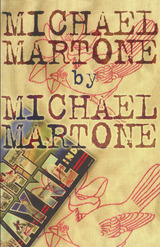 Michael Martone: Fictions
Michael Martone
University of Alabama Press, 2005 A giddy exploration of the parts of books nobody ever reads
Michael Martone, by Michael Martone, continues the author's giddy exploration of the parts of books nobody ever reads. Michael Martone is its own appendix, comprising fifty “contributors notes,” each of which identifies in exorbitant biographical detail the author of the other forty-nine. Full of fanciful anecdotes and preposterous reminiscences, Martone’s self-inventions include the multiple deaths of himself and all his family members, his Kafkaesque rebirth as a giant insect, and his stints as circus performer, assembly-line worker, photographer, and movie extra.
Expect no autobiographical consistency here. A note revealing Martone's mother as the ghost-writer of all his books precedes the note beginning, “Michael Martone, an orphan . . . “ We learn of Martone’s university career and sketchy formal education, his misguided caretaking of his teacher John Barth’s lawn, and his impersonation of a poor African republic in political science class, where Martone's population is allowed to starve as his more fortunate fellow republics fight over development and natural resource trading-cards.
The author of Michael Martone, whose other names include Missy, Dolly, Peanut, Bug, Gigi-tone, Tony's boy, Patty's boy, Junior's, Mickey, Monk, Mr. Martone, and “the contributor named in this note," proves as Protean as fiction itself, continuously transforming the past with every new attribution but never identifying himself by name. It is this missing personage who, from first note to last, constitutes the unformed subject of Michael Martone.
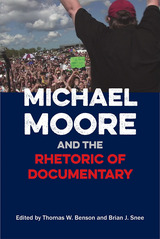 Michael Moore and the Rhetoric of Documentary
Edited by Thomas W. Benson and Brian J. Snee
Southern Illinois University Press, 2015 Not afraid to tackle provocative topics in American culture, from gun violence and labor policies to terrorism and health care, Michael Moore has earned both applause and invective in his career as a documentarian. In such polarizing films as Bowling for Columbine, Fahrenheit 9/11, and Sicko, Moore has established a unique voice of radical nostalgia for progressivism, and in doing so has become one of the most recognized documentary filmmakers of all time. In the first in-depth study of Moore’s feature-length documentary films, editors Thomas W. Benson and Brian J. Snee have gathered leading rhetoric scholars to examine the production, rhetorical appeals, and audience reception of these films. Contributors critique the films primarily as modes of public argument and political art. Each essay is devoted to one of Moore’s films and traces in detail how each film invites specific audience responses. Michael Moore and the Rhetoric of Documentary reveals not only the art, the argument, and the emotional appeals of Moore’s documentaries but also how these films have revolutionized the genre of documentary filmmaking.
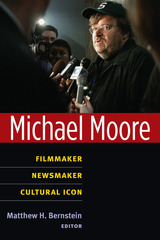 Michael Moore: Filmmaker, Newsmaker, Cultural Icon
Matthew Bernstein, Editor
University of Michigan Press, 2010 For more than twenty years, Michael Moore has transformed himself from a marginal filmmaker into a cultural icon, unofficial spokesperson for liberals and the Left. American conservatives constantly use him for target practice and target. Book author, film director, television personality, and Web presence, Moore is now a one-man cultural phenomenon. Although Michael Moore is a constant presence on the media landscape, this is the first volume to focus on the Moore phenomenom. It explores Moore's work in film and elsewhere, bringing diverse perspectives on his activities and status as voice of liberal America and the disenfranchised working class. Topics examined include the disjunction between Moore's celebrity status and everyman, middle-western persona, his self-mocking ironic sensibility, his tendency to diagnose American social and political problems in terms of class rather than gender, his reception abroad, and his uneasy relationship with the conventions of documentary filmmaking. The contributors are leading scholars and film critics, including Paul Arthur, Cary Elza, Jeffrey P. Jones, Douglas Kellner, Richard Kilborn, William Luhr, Charles Musser, Richard R. Ness, Miles Orvell, Richard Porton, Sergio Rizzo, Christopher Sharrett, Gaylyn Studlar, and David Teztlaff. The volume features both assessments of Moore's work in general and close analyses of his most successful films. The result is a definitive assessment of Moore's career to date. Matthew Bernstein is Professor and Chair of Film Studies at Emory University. He is author of Walter Wanger: Hollywood Independent.
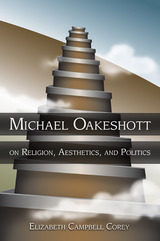 Michael Oakeshott on Religion, Aesthetics, and Politics
Elizabeth Campbell Corey
University of Missouri Press, 2006 For much of his career, British political philosopher Michael Oakeshott was identified with Margaret Thatcher’s conservative policies. He has been called by some a guru to the Tories, while others have considered him one of the last proponents of British Idealism. Best known for such books as Experience and Its Modes and Rationalism in Politics, Oakeshott has been the subject of numerous studies, but always with an emphasis on his political thought.
Elizabeth Campbell Corey now makes the case that Oakeshott’s moral and political philosophies are more informed by religious and aesthetic considerations than has previously been supposed. Hers is the first book-length study of this premise, arguing that Oakeshott’s views on aesthetics, religion, and morality are intimately linked in a creative moral personality that underlies his political theorizing.
Corey focuses on a wealth of early material from Oakeshott’s career that has only recently been published, as well as his acclaimed “Tower of Babel” essays, to show that these works illuminate his thinking in ways that could not have been realized prior to their publication. She places Oakeshott squarely in the Augustinian tradition, citing his 1929 essay “Religion and the World,” and then identifies his departure from it. She explores Oakeshott’s recurring theme of “living one’s life in the present”; examines his explicit discussions of religion, aesthetics, and morality; and then considers his political thought in light of this moral vision. She finally compares his idea of Rationalism to Eric Voegelin’s concept of
Gnosticism and considers both thinkers’ treatment of Hobbes to delineate their philosophical differences.
Through this insightful analysis, Corey shows Oakeshott to be not merely a political philosopher but a thinker with humanistic interests—one who throughout his life was deeply interested in the question of what it means to be human and was moved by art, poetry, and religion while recognizing the necessary evil of political arrangements in order for those activities to flourish. Her work is a major step in a reevaluation of Oakeshott, showing that his conservatism has been greatly misunderstood and that he is more properly regarded as a philosopher whose vision of the human condition, while oftentimes detached and skeptical, is also romantic and inspired.
 Michael Osborn on Metaphor and Style
Michael Osborn
Michigan State University Press, 2018 This volume features two dimensions of Michael Osborn’s work with rhetorical metaphor. The first focuses on his early efforts to develop a conception of metaphor to advance the understanding of rhetoric, while the second concerns more recent efforts to apply this enriched conception in the analysis and criticism of significant rhetorical practice. The older emphasis features four of Osborn’s more prominent published essays, revealing the personal context in which they were generated, their strengths and shortcomings, and how they may have inspired the work of others. His more recent unpublished work analyzes patterns of metaphor in the major speeches of Demosthenes, the evolution of metaphors of illness and cure in speeches across several millennia, the exploitation of the birth-death-rebirth metaphor in Riefenstahl’s masterpiece of Nazi propaganda Triumph of the Will, and the contrasting forms of spatial imagery in the speeches of Edmund Burke and Barack Obama and what these contrasts may portend.
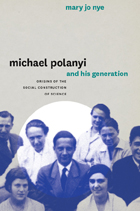 Michael Polanyi and His Generation: Origins of the Social Construction of Science
Mary Jo Nye
University of Chicago Press, 2011 In Michael Polanyi and His Generation, Mary Jo Nye investigates the role that Michael Polanyi and several of his contemporaries played in the emergence of the social turn in the philosophy of science. This turn involved seeing science as a socially based enterprise that does not rely on empiricism and reason alone but on social communities, behavioral norms, and personal commitments. Nye argues that the roots of the social turn are to be found in the scientific culture and political events of Europe in the 1930s, when scientific intellectuals struggled to defend the universal status of scientific knowledge and to justify public support for science in an era of economic catastrophe, Stalinism and Fascism, and increased demands for applications of science to industry and social welfare. At the center of this struggle was Polanyi, who Nye contends was one of the first advocates of this new conception of science. Nye reconstructs Polanyi’s scientific and political milieus in Budapest, Berlin, and Manchester from the 1910s to the 1950s and explains how he and other natural scientists and social scientists of his generation—including J. D. Bernal, Ludwik Fleck, Karl Mannheim, and Robert K. Merton—and the next, such as Thomas Kuhn, forged a politically charged philosophy of science, one that newly emphasized the social construction of science.
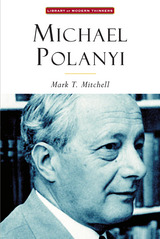 Michael Polanyi: The Art of Knowing
Mark T. Mitchell
Intercollegiate Studies Institute, 2006 The polymath Michael Polanyi first made his mark as a physical chemist, but his interests gradually shifted to economics, politics, and philosophy, in which field he would ultimately propose a revolutionary theory of knowledge that grew out of his firsthand experience with both the scientific method and political totalitarianism. In this sixth entry in ISI Books’ Library of Modern Thinkers’ series, Mark T. Mitchell reveals how Polanyi came to recognize that the roots of the modern political and spiritual crisis lay in an errant conception of knowledge that served to foreclose any possibility of making meaningful statements about truth, goodness, or beauty. Polanyi’s theory of knowledge as ineluctably personal but also grounded in reality is not merely of historical interest, writes Mitchell, for it proposes an attractive alternative for anyone who would reject both the hubris of modern rationalism and the ultimately nihilistic implications of academic postmodernism.
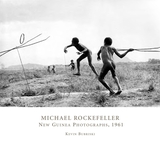 Michael Rockefeller: New Guinea Photographs, 1961
Kevin Bubriski
Harvard University Press, 2006 From April to August 1961, recent Harvard graduate Michael Clark Rockefeller was sound recordist and still photographer on a remarkable multidisciplinary expedition to the Dani people of highland New Guinea. In five short months he produced a wonderful body of work, including over 4,000 black-and-white negatives.
In this catalogue, photographer Kevin Bubriski explores Rockefeller's journey into the culture and community of the Dani and into rapport with the people whose lives he chronicled. The book reveals not only the young photographer's growing fluency in the language of the camera, but also the development of his personal way of seeing the Dani world around him. Although Rockefeller's life was cut tragically short on an expedition to the Asmat in the fall of 1961, his photographs are as vivid today as they were the moment they were made.
Featuring over 75 photographs, this beautiful volume is the first publication of a substantial body of Michael Rockefeller's visual legacy. Rockefeller's extraordinary photographs reveal both the resilient spirit of the Dani people and the anthropological and aesthetic eye of a young man full of promise. In a Foreword, Robert Gardner provides a personal recollection of Michael Rockefeller's experience in the New Guinea highlands.
 Michel de Certeau in the Plural, Volume 100
Ian Buchanan, ed.
Duke University Press French philosopher Michel de Certeau wrote about seventeenth-century mysticism, religion and pluralism, architecture, everyday life, and the history of anthropology. But because critics of his works have tended to fragment it into hermetic compartments, dealing only with what is relevant to their own fields, the expansiveness of his ouevre has suffered damaging distortions in the secondary literature. This special issue of South Atlantic Quarterly provides the first comprehensive view of his complete work, with contributors evaluating his weaknesses as well as his strengths. With articles that engage directly—as well as theoretically—with de Certeau, this collection corrects a long-standing imbalance in the criticism by covering works from two periods about which little is known in anglophone circles: his early books on religious history and his midlife histories of mysticism and possession. It also includes critiques from queer theory and feminist theory, as well as comparative readings that assess de Certeau alongside his famous contemporary, Michel Foucault. With articles by an international array of scholars who address both the secular and the religious thinker, this special issue is the most definitive study to date of this important twentieth-century thinker. Contributors. Jeremy Ahearne, Frederick C. Bauerschmidt, Ian Buchanan, Philippe Carrard, Claire Colebrook, Tom Conley, Verena Andermatt Conley, Catherine Driscoll, Carla Freccero, John Frow, Richard Terdiman, Timothy Tomasik, Marie-Claire Vallois, Graham Ward
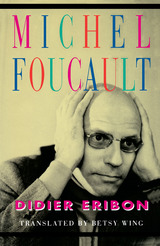 Michel Foucault
Didier Eribon
Harvard University Press, 1991 At the time of his death in 1984, at the age of fifty-eight, Michel Foucault was widely regarded as one of the most powerful minds of this century. Hailed by distinguished historians and lionized on his frequent visits to America, he continues to provoke lively debate. The nature and merits of his accomplishments remain tangled in controversy. Rejecting traditional liberal and Marxist "dreams of solidarity," Foucault became the very model of the modern intellectual, replacing Sartre as the figure of the eminent Parisian and cosmopolitan master thinker.
Foucault himself discouraged biographical questions, claiming that he was "not at all interesting." Didier Eribon's captivating account overthrows that assertion. As a journalist well acquainted with Foucault for years before his death, Eribon was particularly well placed to conduct the dozens of interviews which are the cornerstone of this book. He has drawn upon eyewitness accounts by Foucault's closest associates from all phases of his life--his mother, his schoolteachers, his classmates, his friends and enemies in academic life, and his celebrated companions in political activism, including Simone Signoret and Yves Montand. Eribon has methodically retraced the footsteps of his peripatetic subject, from France to Sweden to Poland to Germany to Tunisia to Brazil to Japan to the United States. The result is a concise, crisply readable, meticulously documented narrative that debunks the many myths and rumors surrounding the brilliant philosophe--and forces us to consider seriously the idea that all his books are indeed, just as Foucault said near the end of his life, "fragments of an autobiography."
Who was this man, Michel Foucault? In the late 1950s Foucault emerged as a budding young cultural attaché, friendly with Gaullist diplomats. By the mid-1960s he appeared as one of the avatars of structuralism, positioning himself as a new star in the fashionable world of French thought. A few months after the May 1968 student revolt, with Gaullism apparently shaken, he emerged as an ultra-leftist and a fellow traveler of Maoists. Yet during this same period, Eribon shows, he was quietly and adroitly campaigning for a chair in the College de France--the very pinnacle of the French academic system. This book does more than follow the career of one extraordinary intellectual. It reconstructs the cultural, political, and intellectual life of France from the postwar years to the present. It is the story of a man and his time.
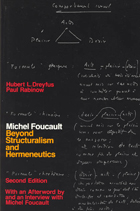 Michel Foucault: Beyond Structuralism and Hermeneutics
Hubert L. Dreyfus and Paul Rabinow
University of Chicago Press, 1983 This book, which Foucault himself has judged accurate, is the first to provide a sustained, coherent analysis of Foucault's work as a whole.
To demonstrate the sense in which Foucault's work is beyond structuralism and hermeneutics, the authors unfold a careful, analytical exposition of his oeuvre. They argue that during the of Foucault's work became a sustained and largely successful effort to develop a new method—"interpretative analytics"—capable fo explaining both the logic of structuralism's claim to be an objective science and the apparent validity of the hermeneutical counterclaim that the human sciences can proceed only by understanding the deepest meaning of the subject and his tradition.
"There are many new secondary sources [on Foucault]. None surpass the book by Hubert Dreyfus and Paul Rabinow. . . . The American paperback edition contains Foucault's 'On the Genealogy of Ethics,' a lucid interview that is now our best source for seeing how he construed the whole project of the history of sexuality."—David Hoy, London Review of Books
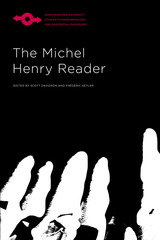 The Michel Henry Reader
Edited by Scott Davidson and Frédéric Seyler
Northwestern University Press, 2019 From beginning to end, the philosophy of Michel Henry offers an original and profound reflection on life. Henry challenges the conventional understanding of life as a set of natural processes and a general classification of beings. Maintaining that our access to the meaning of life has been blocked by naturalism as well as by traditional philosophical assumptions, Henry carries out an enterprise that can rightfully be called “radical.” His phenomenology leads back to the original dimension of life—to a reality that precedes and conditions the natural sciences and even objectivity as such.
The Michel Henry Reader is an indispensable resource for those who are approaching Henry for the first time as well as for those who are already familiar with his work. It provides broad coverage of the major themes in his philosophy and new translations of Henry’s most important essays. Sixteen chapters are divided into four parts that demonstrate the profound implications of Henry’s philosophy of life: for phenomenology; for subjectivity; for politics, art, and language; and for ethics and religion.
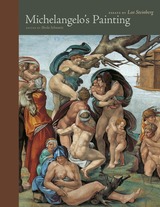 Michelangelo's Painting: Selected Essays
Leo Steinberg
University of Chicago Press, 2019 Leo Steinberg was one of the most original art historians of the twentieth century, known for taking interpretive risks that challenged the profession by overturning reigning orthodoxies. In essays and lectures ranging from old masters to contemporary art, he combined scholarly erudition with an eloquent prose that illuminated his subject and a credo that privileged the visual evidence of the image over the literature written about it. His writings, sometimes provocative and controversial, remain vital and influential reading.
For half a century, Steinberg delved into Michelangelo’s work, revealing the symbolic structures underlying the artist’s highly charged idiom. This volume of essays and unpublished lectures elucidates many of Michelangelo’s paintings, from frescoes in the Sistine Chapel to the Conversion of St. Paul and the Crucifixion of St. Peter, the artist’s lesser-known works in the Vatican’s Pauline Chapel; also included is a study of the relationship of the Doni Madonna to Leonardo.
Steinberg’s perceptions evolved from long, hard looking. Almost everything he wrote included passages of old-fashioned formal analysis, but always put into the service of interpretation. He understood that Michelangelo’s rendering of figures, as well as their gestures and interrelations, conveys an emblematic significance masquerading under the guise of naturalism. Michelangelo pushed Renaissance naturalism into the furthest reaches of metaphor, using the language of the body to express fundamental Christian tenets once expressible only by poets and preachers.
Leo Steinberg was one of the most original art historians of the twentieth century, known for taking interpretive risks that challenged the profession by overturning reigning orthodoxies. Michelangelo’s Painting is the second volume in a series that presents Steinberg’s writings, selected and edited by his longtime associate Sheila Schwartz.
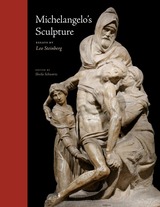 Michelangelo’s Sculpture: Selected Essays
Leo Steinberg
University of Chicago Press, 2018 Leo Steinberg was one of the most original and daring art historians of the twentieth century, known for taking interpretative risks that challenged the profession by overturning reigning orthodoxies. In essays and lectures that ranged from old masters to contemporary art, he combined scholarly erudition with an eloquent prose that illuminated his subject and a credo that privileged the visual evidence of the image over the literature written about it. His works, sometimes provocative and controversial, remain vital and influential reading.
For half a century, Steinberg delved into Michelangelo’s work, revealing the symbolic structures underlying the artist’s highly charged idiom. This volume of essays and unpublished lectures explicates many of Michelangelo’s most celebrated sculptures, applying principles gleaned from long, hard looking. Almost everything Steinberg wrote included passages of old-fashioned formal analysis, but here put to the service of interpretation. He understood that Michelangelo’s rendering of figures as well as their gestures and interrelations conveys an emblematic significance masquerading under the guise of naturalism. Michelangelo pushed Renaissance naturalism into the furthest reaches of metaphor, using the language of the body and its actions to express fundamental Christian tenets once expressible only by poets and preachers—or, as Steinberg put it, in Michelangelo’s art, “anatomy becomes theology.”
Michelangelo’s Sculpture is the first in a series of volumes of Steinberg’s selected writings and unpublished lectures, edited by his longtime associate Sheila Schwartz. The volume also includes a book review debunking psychoanalytic interpretation of the master’s work, a light-hearted look at Michelangelo and the medical profession and, finally, the shortest piece Steinberg ever published.
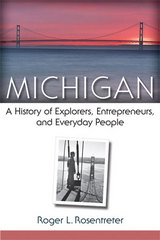 Michigan: A History of Explorers, Entrepreneurs, and Everyday People
Roger L. Rosentreter
University of Michigan Press, 2013 The history of Michigan is a fascinating story of breathtaking geography enriched by an abundant water supply, of bold fur traders and missionaries who developed settlements that grew into major cities, of ingenious entrepreneurs who established thriving industries, and of celebrated cultural icons like the Motown sound. It is also the story of the exploitation of Native Americans, racial discord that resulted in a devastating riot, and ongoing tensions between employers and unions. Michigan: A History of Explorers, Entrepreneurs, and Everyday People recounts this colorful past and the significant role the state has played in shaping the United States. Well-researched and engagingly written, the book spans from Michigan’s geologic formation to important 21st-century developments in a concise but detailed chronicle that will appeal to general readers, scholars, and students interested in Michigan’s past, present, and future.
|
|
